Impact of Brand Loyalty on Consumer Buying Behaviour in Myntra
VerifiedAdded on 2022/11/28
|63
|18942
|173
AI Summary
This research focuses on the impact of brand loyalty on consumer buying behaviour in Myntra, an Indian fashion and lifestyle brand. It explores the factors influencing consumer behaviour and loyalty in the e-commerce industry. The study aims to provide insights and recommendations for Myntra to enhance brand loyalty and regulate consumer buying behaviour. The research includes a literature review, research methodology, data analysis, findings, and recommendations.
Contribute Materials
Your contribution can guide someone’s learning journey. Share your
documents today.
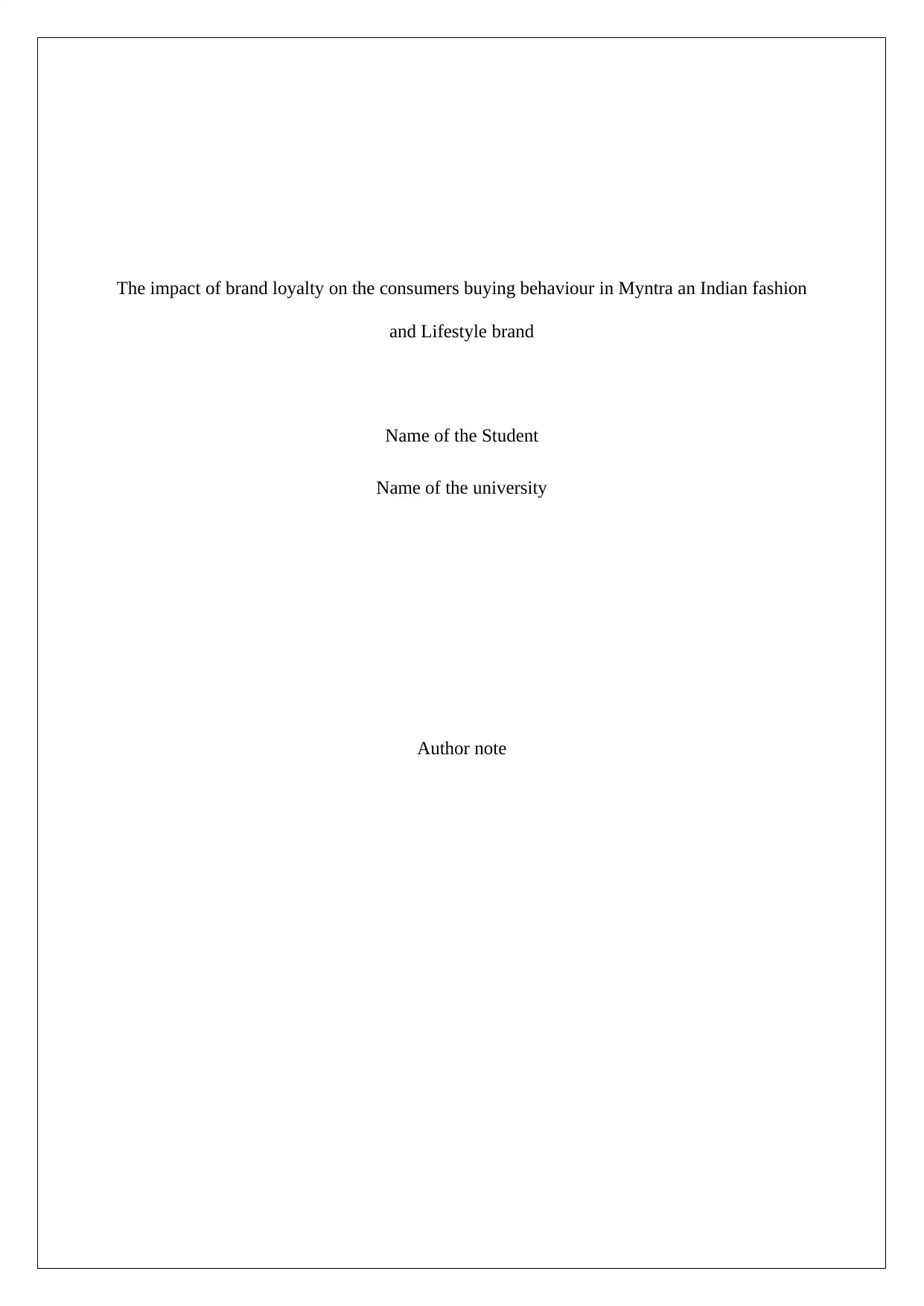
The impact of brand loyalty on the consumers buying behaviour in Myntra an Indian fashion
and Lifestyle brand
Name of the Student
Name of the university
Author note
and Lifestyle brand
Name of the Student
Name of the university
Author note
Secure Best Marks with AI Grader
Need help grading? Try our AI Grader for instant feedback on your assignments.
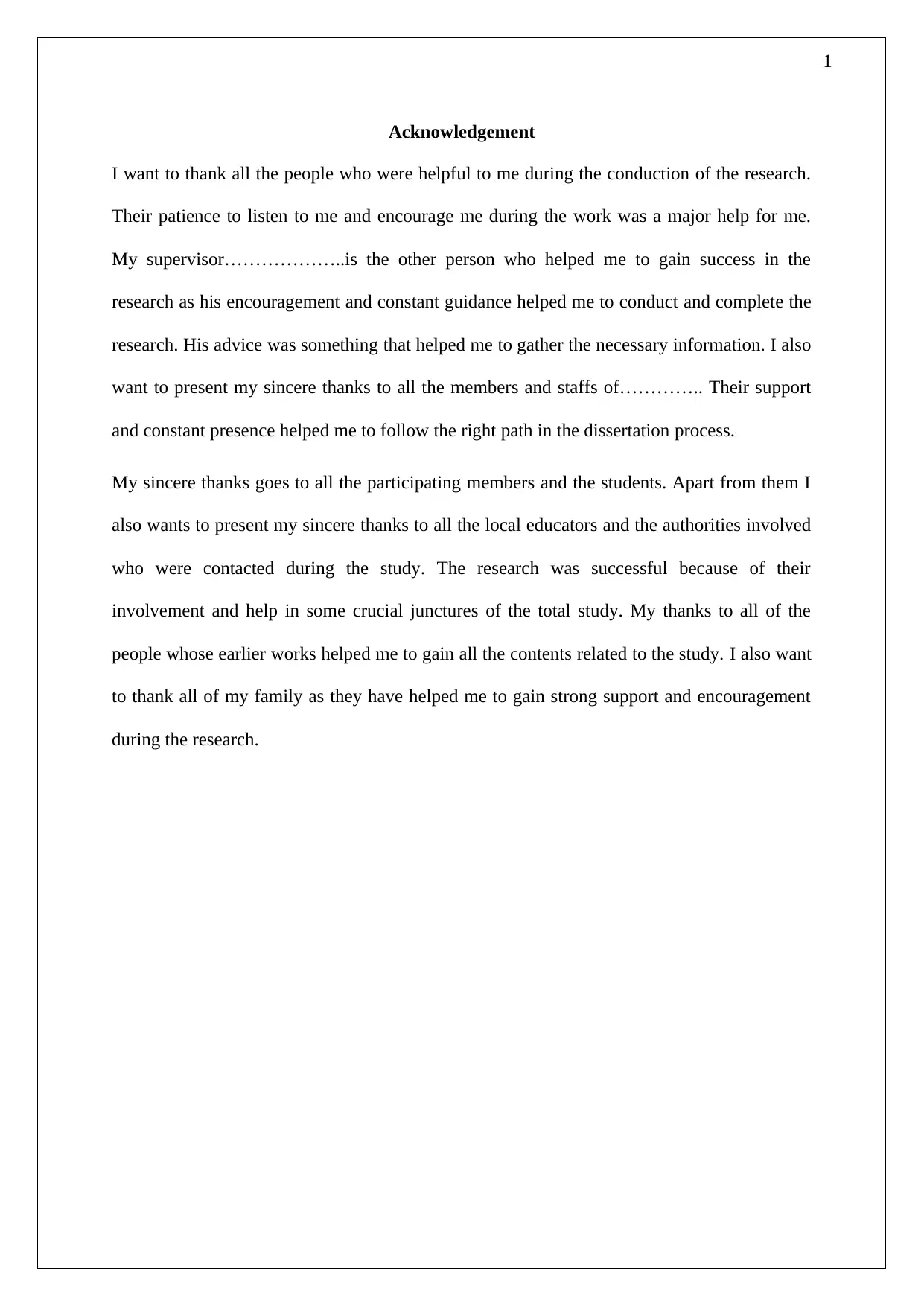
1
Acknowledgement
I want to thank all the people who were helpful to me during the conduction of the research.
Their patience to listen to me and encourage me during the work was a major help for me.
My supervisor………………..is the other person who helped me to gain success in the
research as his encouragement and constant guidance helped me to conduct and complete the
research. His advice was something that helped me to gather the necessary information. I also
want to present my sincere thanks to all the members and staffs of………….. Their support
and constant presence helped me to follow the right path in the dissertation process.
My sincere thanks goes to all the participating members and the students. Apart from them I
also wants to present my sincere thanks to all the local educators and the authorities involved
who were contacted during the study. The research was successful because of their
involvement and help in some crucial junctures of the total study. My thanks to all of the
people whose earlier works helped me to gain all the contents related to the study. I also want
to thank all of my family as they have helped me to gain strong support and encouragement
during the research.
Acknowledgement
I want to thank all the people who were helpful to me during the conduction of the research.
Their patience to listen to me and encourage me during the work was a major help for me.
My supervisor………………..is the other person who helped me to gain success in the
research as his encouragement and constant guidance helped me to conduct and complete the
research. His advice was something that helped me to gather the necessary information. I also
want to present my sincere thanks to all the members and staffs of………….. Their support
and constant presence helped me to follow the right path in the dissertation process.
My sincere thanks goes to all the participating members and the students. Apart from them I
also wants to present my sincere thanks to all the local educators and the authorities involved
who were contacted during the study. The research was successful because of their
involvement and help in some crucial junctures of the total study. My thanks to all of the
people whose earlier works helped me to gain all the contents related to the study. I also want
to thank all of my family as they have helped me to gain strong support and encouragement
during the research.
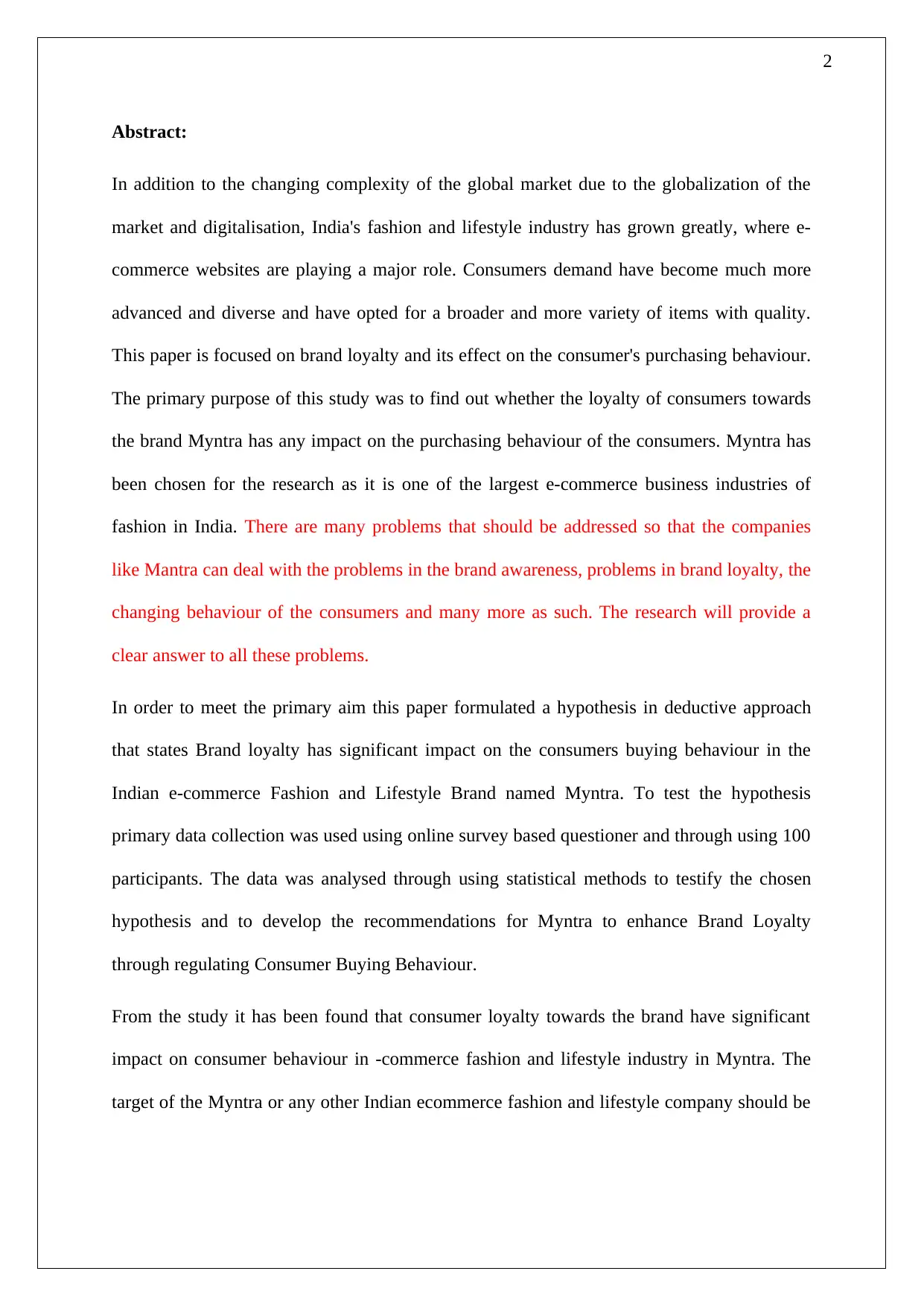
2
Abstract:
In addition to the changing complexity of the global market due to the globalization of the
market and digitalisation, India's fashion and lifestyle industry has grown greatly, where e-
commerce websites are playing a major role. Consumers demand have become much more
advanced and diverse and have opted for a broader and more variety of items with quality.
This paper is focused on brand loyalty and its effect on the consumer's purchasing behaviour.
The primary purpose of this study was to find out whether the loyalty of consumers towards
the brand Myntra has any impact on the purchasing behaviour of the consumers. Myntra has
been chosen for the research as it is one of the largest e-commerce business industries of
fashion in India. There are many problems that should be addressed so that the companies
like Mantra can deal with the problems in the brand awareness, problems in brand loyalty, the
changing behaviour of the consumers and many more as such. The research will provide a
clear answer to all these problems.
In order to meet the primary aim this paper formulated a hypothesis in deductive approach
that states Brand loyalty has significant impact on the consumers buying behaviour in the
Indian e-commerce Fashion and Lifestyle Brand named Myntra. To test the hypothesis
primary data collection was used using online survey based questioner and through using 100
participants. The data was analysed through using statistical methods to testify the chosen
hypothesis and to develop the recommendations for Myntra to enhance Brand Loyalty
through regulating Consumer Buying Behaviour.
From the study it has been found that consumer loyalty towards the brand have significant
impact on consumer behaviour in -commerce fashion and lifestyle industry in Myntra. The
target of the Myntra or any other Indian ecommerce fashion and lifestyle company should be
Abstract:
In addition to the changing complexity of the global market due to the globalization of the
market and digitalisation, India's fashion and lifestyle industry has grown greatly, where e-
commerce websites are playing a major role. Consumers demand have become much more
advanced and diverse and have opted for a broader and more variety of items with quality.
This paper is focused on brand loyalty and its effect on the consumer's purchasing behaviour.
The primary purpose of this study was to find out whether the loyalty of consumers towards
the brand Myntra has any impact on the purchasing behaviour of the consumers. Myntra has
been chosen for the research as it is one of the largest e-commerce business industries of
fashion in India. There are many problems that should be addressed so that the companies
like Mantra can deal with the problems in the brand awareness, problems in brand loyalty, the
changing behaviour of the consumers and many more as such. The research will provide a
clear answer to all these problems.
In order to meet the primary aim this paper formulated a hypothesis in deductive approach
that states Brand loyalty has significant impact on the consumers buying behaviour in the
Indian e-commerce Fashion and Lifestyle Brand named Myntra. To test the hypothesis
primary data collection was used using online survey based questioner and through using 100
participants. The data was analysed through using statistical methods to testify the chosen
hypothesis and to develop the recommendations for Myntra to enhance Brand Loyalty
through regulating Consumer Buying Behaviour.
From the study it has been found that consumer loyalty towards the brand have significant
impact on consumer behaviour in -commerce fashion and lifestyle industry in Myntra. The
target of the Myntra or any other Indian ecommerce fashion and lifestyle company should be
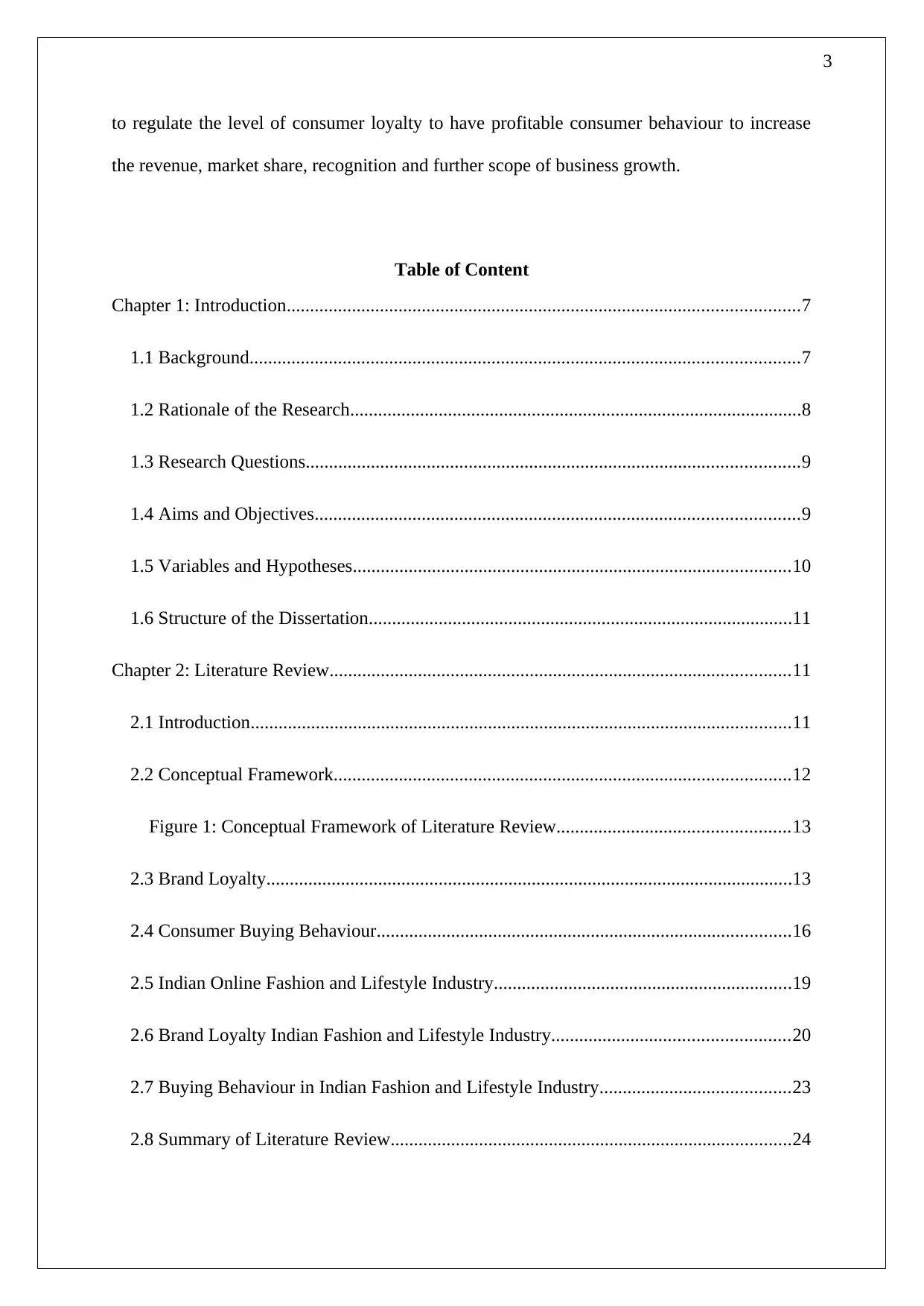
3
to regulate the level of consumer loyalty to have profitable consumer behaviour to increase
the revenue, market share, recognition and further scope of business growth.
Table of Content
Chapter 1: Introduction..............................................................................................................7
1.1 Background......................................................................................................................7
1.2 Rationale of the Research.................................................................................................8
1.3 Research Questions..........................................................................................................9
1.4 Aims and Objectives........................................................................................................9
1.5 Variables and Hypotheses..............................................................................................10
1.6 Structure of the Dissertation...........................................................................................11
Chapter 2: Literature Review...................................................................................................11
2.1 Introduction....................................................................................................................11
2.2 Conceptual Framework..................................................................................................12
Figure 1: Conceptual Framework of Literature Review..................................................13
2.3 Brand Loyalty.................................................................................................................13
2.4 Consumer Buying Behaviour.........................................................................................16
2.5 Indian Online Fashion and Lifestyle Industry................................................................19
2.6 Brand Loyalty Indian Fashion and Lifestyle Industry...................................................20
2.7 Buying Behaviour in Indian Fashion and Lifestyle Industry.........................................23
2.8 Summary of Literature Review......................................................................................24
to regulate the level of consumer loyalty to have profitable consumer behaviour to increase
the revenue, market share, recognition and further scope of business growth.
Table of Content
Chapter 1: Introduction..............................................................................................................7
1.1 Background......................................................................................................................7
1.2 Rationale of the Research.................................................................................................8
1.3 Research Questions..........................................................................................................9
1.4 Aims and Objectives........................................................................................................9
1.5 Variables and Hypotheses..............................................................................................10
1.6 Structure of the Dissertation...........................................................................................11
Chapter 2: Literature Review...................................................................................................11
2.1 Introduction....................................................................................................................11
2.2 Conceptual Framework..................................................................................................12
Figure 1: Conceptual Framework of Literature Review..................................................13
2.3 Brand Loyalty.................................................................................................................13
2.4 Consumer Buying Behaviour.........................................................................................16
2.5 Indian Online Fashion and Lifestyle Industry................................................................19
2.6 Brand Loyalty Indian Fashion and Lifestyle Industry...................................................20
2.7 Buying Behaviour in Indian Fashion and Lifestyle Industry.........................................23
2.8 Summary of Literature Review......................................................................................24
Secure Best Marks with AI Grader
Need help grading? Try our AI Grader for instant feedback on your assignments.

4
Chapter 3: Research Methodology...........................................................................................25
3.1 Introduction....................................................................................................................25
3.2 Research Methodology outline......................................................................................26
3.3 Research Philosophy and Justification for Selection.....................................................26
3.4 Research Approach and Justification for Selection.......................................................27
3.5 Research Design and Justification for Selection............................................................28
3.6 Research strategy...........................................................................................................29
3.7 Population and Sampling Process..................................................................................30
3.8 Data Collection Procedure.............................................................................................31
3.9 Data Analysis Procedure................................................................................................32
3.10 Ethical Consideration...................................................................................................33
3.11 Summary of the Method...............................................................................................33
Chapter 4: Data Analysis and Findings....................................................................................34
4.1 Overview of Results.......................................................................................................34
4.2 Descriptive Analysis......................................................................................................34
4.3 Inferential Analysis........................................................................................................39
4.4 Summary of Findings.....................................................................................................45
Chapter 5: Discussion..............................................................................................................46
Chapter 6: Conclusion..............................................................................................................49
6.1 Summary of Study..........................................................................................................49
6.2 Linking with Research Questions..................................................................................50
Chapter 3: Research Methodology...........................................................................................25
3.1 Introduction....................................................................................................................25
3.2 Research Methodology outline......................................................................................26
3.3 Research Philosophy and Justification for Selection.....................................................26
3.4 Research Approach and Justification for Selection.......................................................27
3.5 Research Design and Justification for Selection............................................................28
3.6 Research strategy...........................................................................................................29
3.7 Population and Sampling Process..................................................................................30
3.8 Data Collection Procedure.............................................................................................31
3.9 Data Analysis Procedure................................................................................................32
3.10 Ethical Consideration...................................................................................................33
3.11 Summary of the Method...............................................................................................33
Chapter 4: Data Analysis and Findings....................................................................................34
4.1 Overview of Results.......................................................................................................34
4.2 Descriptive Analysis......................................................................................................34
4.3 Inferential Analysis........................................................................................................39
4.4 Summary of Findings.....................................................................................................45
Chapter 5: Discussion..............................................................................................................46
Chapter 6: Conclusion..............................................................................................................49
6.1 Summary of Study..........................................................................................................49
6.2 Linking with Research Questions..................................................................................50
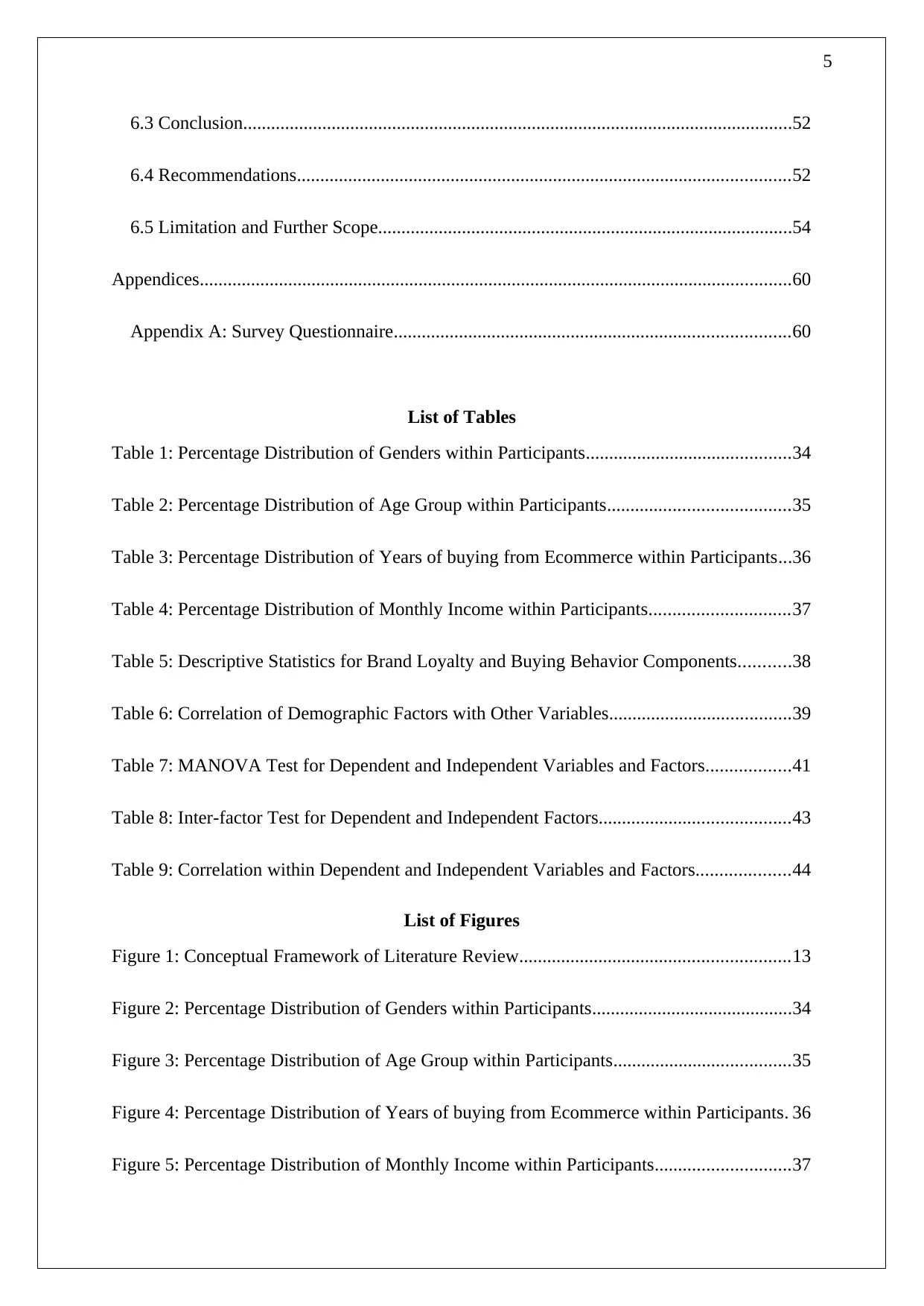
5
6.3 Conclusion......................................................................................................................52
6.4 Recommendations..........................................................................................................52
6.5 Limitation and Further Scope.........................................................................................54
Appendices...............................................................................................................................60
Appendix A: Survey Questionnaire.....................................................................................60
List of Tables
Table 1: Percentage Distribution of Genders within Participants............................................34
Table 2: Percentage Distribution of Age Group within Participants.......................................35
Table 3: Percentage Distribution of Years of buying from Ecommerce within Participants...36
Table 4: Percentage Distribution of Monthly Income within Participants..............................37
Table 5: Descriptive Statistics for Brand Loyalty and Buying Behavior Components...........38
Table 6: Correlation of Demographic Factors with Other Variables.......................................39
Table 7: MANOVA Test for Dependent and Independent Variables and Factors..................41
Table 8: Inter-factor Test for Dependent and Independent Factors.........................................43
Table 9: Correlation within Dependent and Independent Variables and Factors....................44
List of Figures
Figure 1: Conceptual Framework of Literature Review..........................................................13
Figure 2: Percentage Distribution of Genders within Participants...........................................34
Figure 3: Percentage Distribution of Age Group within Participants......................................35
Figure 4: Percentage Distribution of Years of buying from Ecommerce within Participants. 36
Figure 5: Percentage Distribution of Monthly Income within Participants.............................37
6.3 Conclusion......................................................................................................................52
6.4 Recommendations..........................................................................................................52
6.5 Limitation and Further Scope.........................................................................................54
Appendices...............................................................................................................................60
Appendix A: Survey Questionnaire.....................................................................................60
List of Tables
Table 1: Percentage Distribution of Genders within Participants............................................34
Table 2: Percentage Distribution of Age Group within Participants.......................................35
Table 3: Percentage Distribution of Years of buying from Ecommerce within Participants...36
Table 4: Percentage Distribution of Monthly Income within Participants..............................37
Table 5: Descriptive Statistics for Brand Loyalty and Buying Behavior Components...........38
Table 6: Correlation of Demographic Factors with Other Variables.......................................39
Table 7: MANOVA Test for Dependent and Independent Variables and Factors..................41
Table 8: Inter-factor Test for Dependent and Independent Factors.........................................43
Table 9: Correlation within Dependent and Independent Variables and Factors....................44
List of Figures
Figure 1: Conceptual Framework of Literature Review..........................................................13
Figure 2: Percentage Distribution of Genders within Participants...........................................34
Figure 3: Percentage Distribution of Age Group within Participants......................................35
Figure 4: Percentage Distribution of Years of buying from Ecommerce within Participants. 36
Figure 5: Percentage Distribution of Monthly Income within Participants.............................37

6
Paraphrase This Document
Need a fresh take? Get an instant paraphrase of this document with our AI Paraphraser
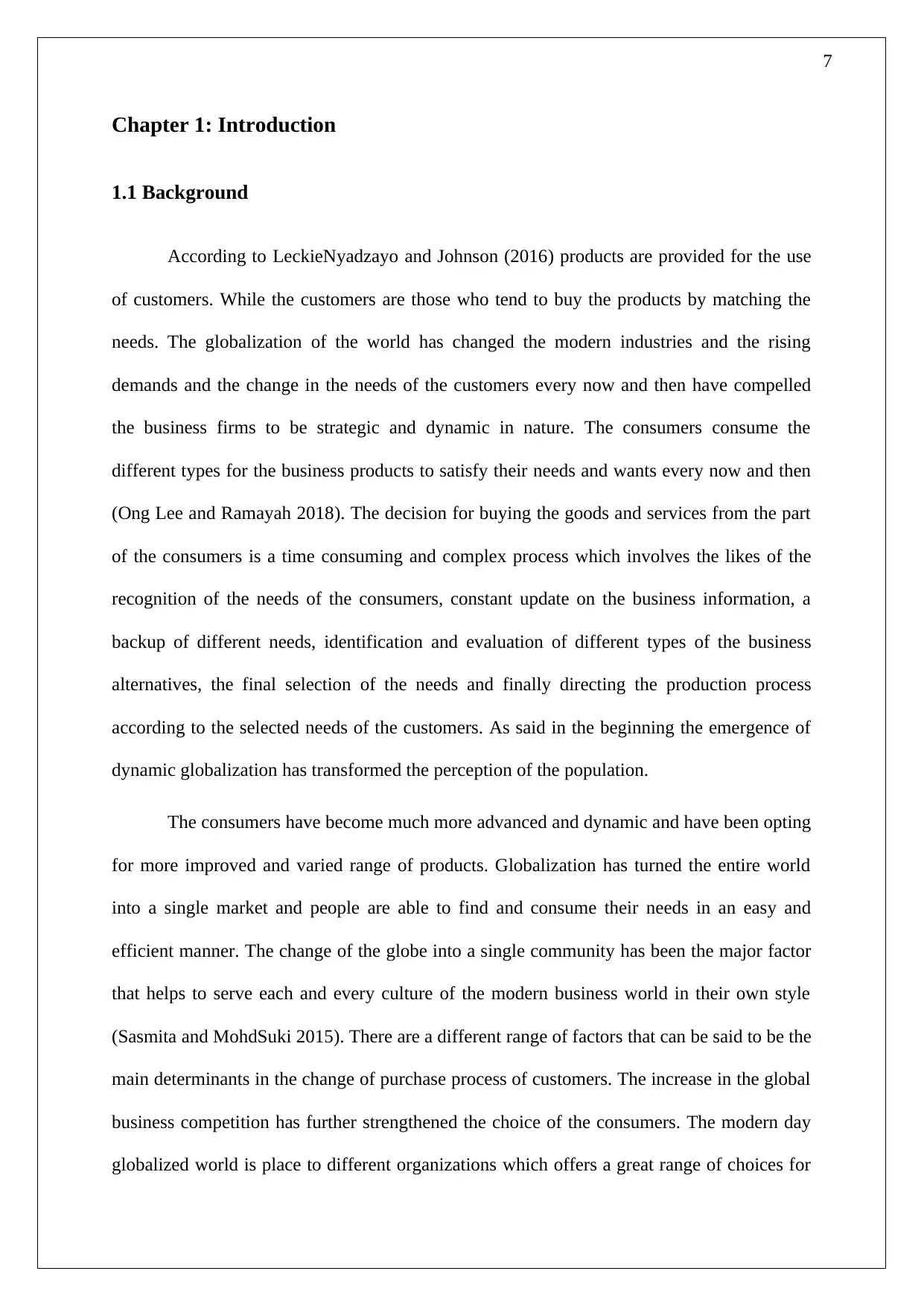
7
Chapter 1: Introduction
1.1 Background
According to LeckieNyadzayo and Johnson (2016) products are provided for the use
of customers. While the customers are those who tend to buy the products by matching the
needs. The globalization of the world has changed the modern industries and the rising
demands and the change in the needs of the customers every now and then have compelled
the business firms to be strategic and dynamic in nature. The consumers consume the
different types for the business products to satisfy their needs and wants every now and then
(Ong Lee and Ramayah 2018). The decision for buying the goods and services from the part
of the consumers is a time consuming and complex process which involves the likes of the
recognition of the needs of the consumers, constant update on the business information, a
backup of different needs, identification and evaluation of different types of the business
alternatives, the final selection of the needs and finally directing the production process
according to the selected needs of the customers. As said in the beginning the emergence of
dynamic globalization has transformed the perception of the population.
The consumers have become much more advanced and dynamic and have been opting
for more improved and varied range of products. Globalization has turned the entire world
into a single market and people are able to find and consume their needs in an easy and
efficient manner. The change of the globe into a single community has been the major factor
that helps to serve each and every culture of the modern business world in their own style
(Sasmita and MohdSuki 2015). There are a different range of factors that can be said to be the
main determinants in the change of purchase process of customers. The increase in the global
business competition has further strengthened the choice of the consumers. The modern day
globalized world is place to different organizations which offers a great range of choices for
Chapter 1: Introduction
1.1 Background
According to LeckieNyadzayo and Johnson (2016) products are provided for the use
of customers. While the customers are those who tend to buy the products by matching the
needs. The globalization of the world has changed the modern industries and the rising
demands and the change in the needs of the customers every now and then have compelled
the business firms to be strategic and dynamic in nature. The consumers consume the
different types for the business products to satisfy their needs and wants every now and then
(Ong Lee and Ramayah 2018). The decision for buying the goods and services from the part
of the consumers is a time consuming and complex process which involves the likes of the
recognition of the needs of the consumers, constant update on the business information, a
backup of different needs, identification and evaluation of different types of the business
alternatives, the final selection of the needs and finally directing the production process
according to the selected needs of the customers. As said in the beginning the emergence of
dynamic globalization has transformed the perception of the population.
The consumers have become much more advanced and dynamic and have been opting
for more improved and varied range of products. Globalization has turned the entire world
into a single market and people are able to find and consume their needs in an easy and
efficient manner. The change of the globe into a single community has been the major factor
that helps to serve each and every culture of the modern business world in their own style
(Sasmita and MohdSuki 2015). There are a different range of factors that can be said to be the
main determinants in the change of purchase process of customers. The increase in the global
business competition has further strengthened the choice of the consumers. The modern day
globalized world is place to different organizations which offers a great range of choices for
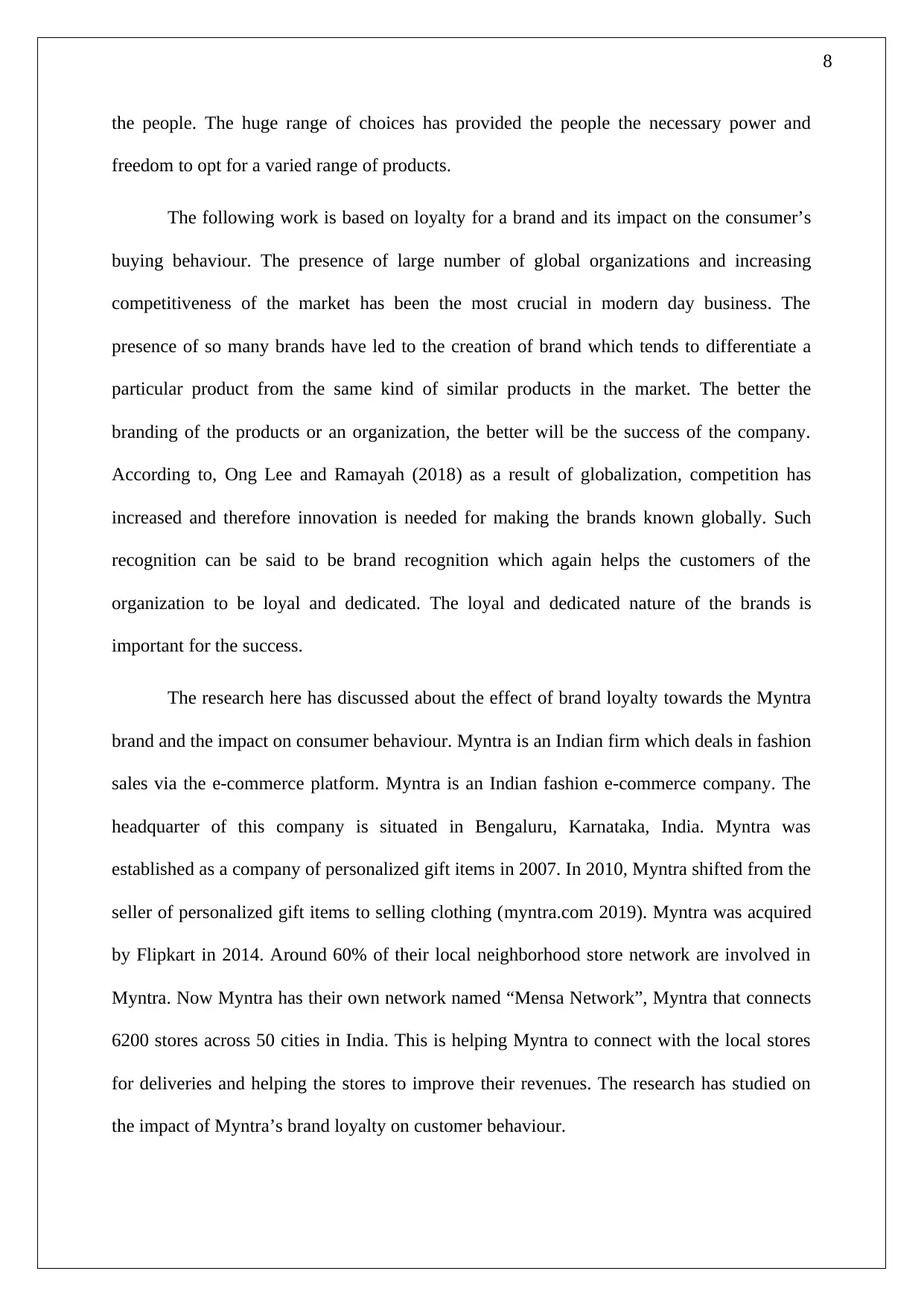
8
the people. The huge range of choices has provided the people the necessary power and
freedom to opt for a varied range of products.
The following work is based on loyalty for a brand and its impact on the consumer’s
buying behaviour. The presence of large number of global organizations and increasing
competitiveness of the market has been the most crucial in modern day business. The
presence of so many brands have led to the creation of brand which tends to differentiate a
particular product from the same kind of similar products in the market. The better the
branding of the products or an organization, the better will be the success of the company.
According to, Ong Lee and Ramayah (2018) as a result of globalization, competition has
increased and therefore innovation is needed for making the brands known globally. Such
recognition can be said to be brand recognition which again helps the customers of the
organization to be loyal and dedicated. The loyal and dedicated nature of the brands is
important for the success.
The research here has discussed about the effect of brand loyalty towards the Myntra
brand and the impact on consumer behaviour. Myntra is an Indian firm which deals in fashion
sales via the e-commerce platform. Myntra is an Indian fashion e-commerce company. The
headquarter of this company is situated in Bengaluru, Karnataka, India. Myntra was
established as a company of personalized gift items in 2007. In 2010, Myntra shifted from the
seller of personalized gift items to selling clothing (myntra.com 2019). Myntra was acquired
by Flipkart in 2014. Around 60% of their local neighborhood store network are involved in
Myntra. Now Myntra has their own network named “Mensa Network”, Myntra that connects
6200 stores across 50 cities in India. This is helping Myntra to connect with the local stores
for deliveries and helping the stores to improve their revenues. The research has studied on
the impact of Myntra’s brand loyalty on customer behaviour.
the people. The huge range of choices has provided the people the necessary power and
freedom to opt for a varied range of products.
The following work is based on loyalty for a brand and its impact on the consumer’s
buying behaviour. The presence of large number of global organizations and increasing
competitiveness of the market has been the most crucial in modern day business. The
presence of so many brands have led to the creation of brand which tends to differentiate a
particular product from the same kind of similar products in the market. The better the
branding of the products or an organization, the better will be the success of the company.
According to, Ong Lee and Ramayah (2018) as a result of globalization, competition has
increased and therefore innovation is needed for making the brands known globally. Such
recognition can be said to be brand recognition which again helps the customers of the
organization to be loyal and dedicated. The loyal and dedicated nature of the brands is
important for the success.
The research here has discussed about the effect of brand loyalty towards the Myntra
brand and the impact on consumer behaviour. Myntra is an Indian firm which deals in fashion
sales via the e-commerce platform. Myntra is an Indian fashion e-commerce company. The
headquarter of this company is situated in Bengaluru, Karnataka, India. Myntra was
established as a company of personalized gift items in 2007. In 2010, Myntra shifted from the
seller of personalized gift items to selling clothing (myntra.com 2019). Myntra was acquired
by Flipkart in 2014. Around 60% of their local neighborhood store network are involved in
Myntra. Now Myntra has their own network named “Mensa Network”, Myntra that connects
6200 stores across 50 cities in India. This is helping Myntra to connect with the local stores
for deliveries and helping the stores to improve their revenues. The research has studied on
the impact of Myntra’s brand loyalty on customer behaviour.
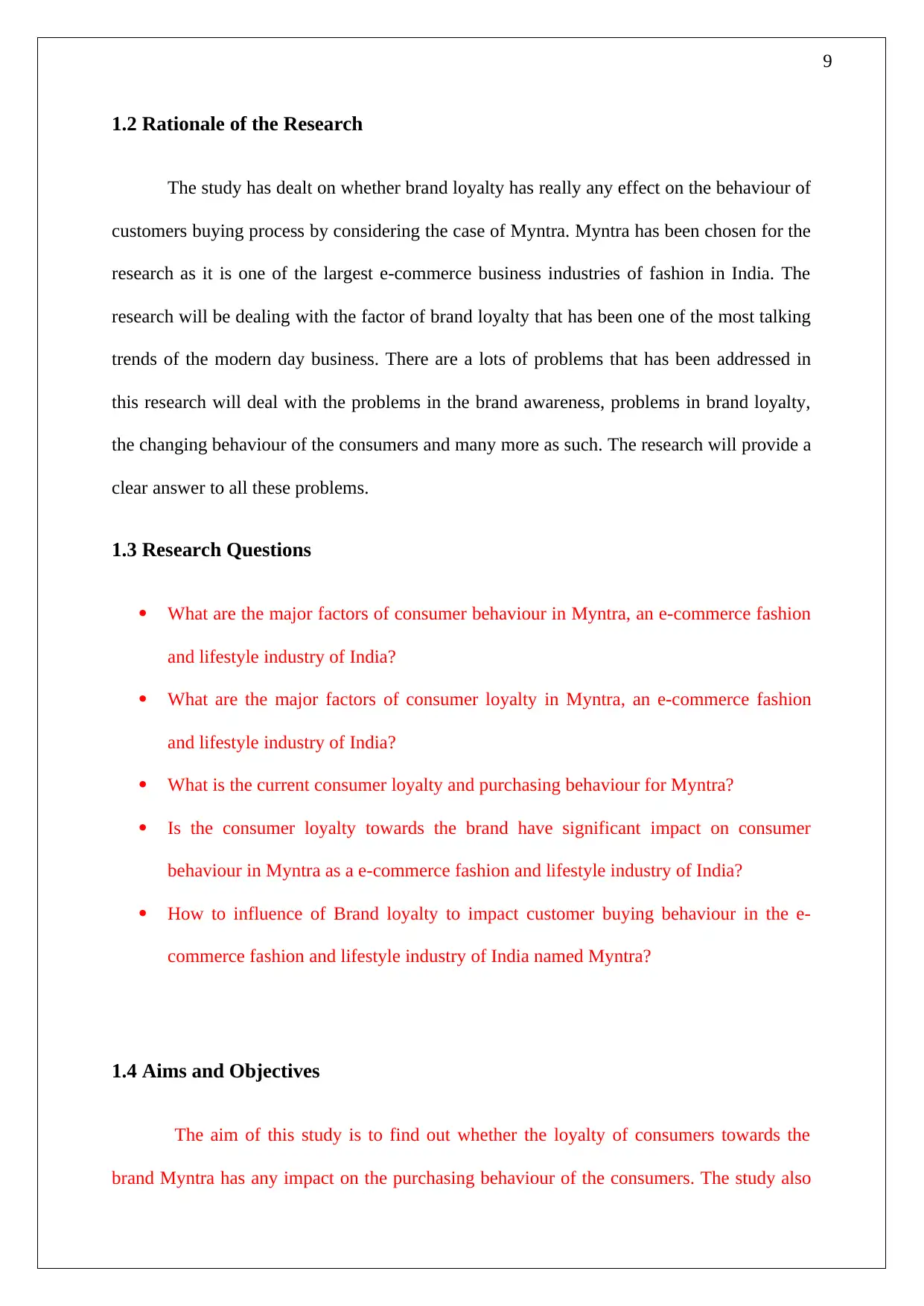
9
1.2 Rationale of the Research
The study has dealt on whether brand loyalty has really any effect on the behaviour of
customers buying process by considering the case of Myntra. Myntra has been chosen for the
research as it is one of the largest e-commerce business industries of fashion in India. The
research will be dealing with the factor of brand loyalty that has been one of the most talking
trends of the modern day business. There are a lots of problems that has been addressed in
this research will deal with the problems in the brand awareness, problems in brand loyalty,
the changing behaviour of the consumers and many more as such. The research will provide a
clear answer to all these problems.
1.3 Research Questions
What are the major factors of consumer behaviour in Myntra, an e-commerce fashion
and lifestyle industry of India?
What are the major factors of consumer loyalty in Myntra, an e-commerce fashion
and lifestyle industry of India?
What is the current consumer loyalty and purchasing behaviour for Myntra?
Is the consumer loyalty towards the brand have significant impact on consumer
behaviour in Myntra as a e-commerce fashion and lifestyle industry of India?
How to influence of Brand loyalty to impact customer buying behaviour in the e-
commerce fashion and lifestyle industry of India named Myntra?
1.4 Aims and Objectives
The aim of this study is to find out whether the loyalty of consumers towards the
brand Myntra has any impact on the purchasing behaviour of the consumers. The study also
1.2 Rationale of the Research
The study has dealt on whether brand loyalty has really any effect on the behaviour of
customers buying process by considering the case of Myntra. Myntra has been chosen for the
research as it is one of the largest e-commerce business industries of fashion in India. The
research will be dealing with the factor of brand loyalty that has been one of the most talking
trends of the modern day business. There are a lots of problems that has been addressed in
this research will deal with the problems in the brand awareness, problems in brand loyalty,
the changing behaviour of the consumers and many more as such. The research will provide a
clear answer to all these problems.
1.3 Research Questions
What are the major factors of consumer behaviour in Myntra, an e-commerce fashion
and lifestyle industry of India?
What are the major factors of consumer loyalty in Myntra, an e-commerce fashion
and lifestyle industry of India?
What is the current consumer loyalty and purchasing behaviour for Myntra?
Is the consumer loyalty towards the brand have significant impact on consumer
behaviour in Myntra as a e-commerce fashion and lifestyle industry of India?
How to influence of Brand loyalty to impact customer buying behaviour in the e-
commerce fashion and lifestyle industry of India named Myntra?
1.4 Aims and Objectives
The aim of this study is to find out whether the loyalty of consumers towards the
brand Myntra has any impact on the purchasing behaviour of the consumers. The study also
Secure Best Marks with AI Grader
Need help grading? Try our AI Grader for instant feedback on your assignments.
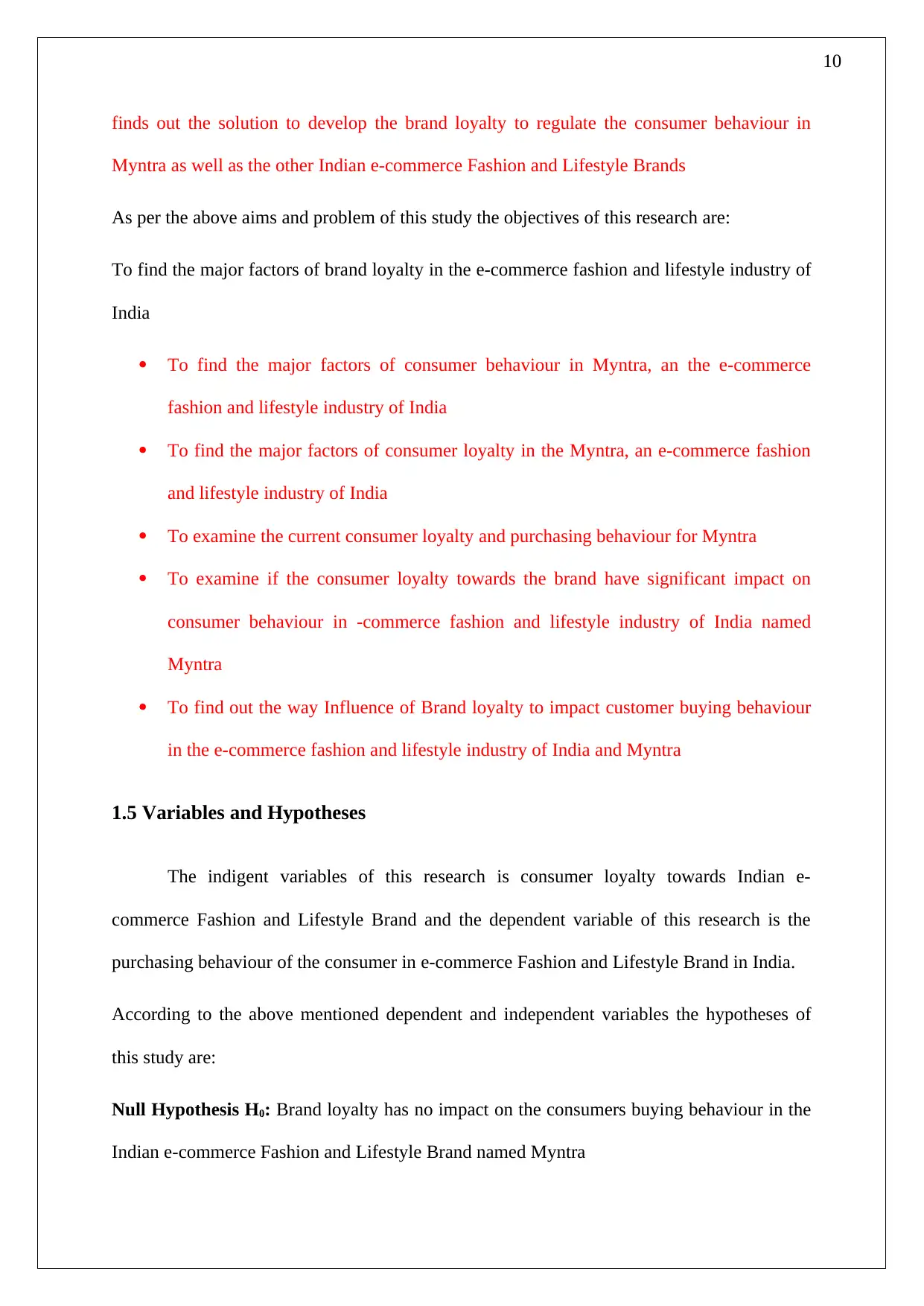
10
finds out the solution to develop the brand loyalty to regulate the consumer behaviour in
Myntra as well as the other Indian e-commerce Fashion and Lifestyle Brands
As per the above aims and problem of this study the objectives of this research are:
To find the major factors of brand loyalty in the e-commerce fashion and lifestyle industry of
India
To find the major factors of consumer behaviour in Myntra, an the e-commerce
fashion and lifestyle industry of India
To find the major factors of consumer loyalty in the Myntra, an e-commerce fashion
and lifestyle industry of India
To examine the current consumer loyalty and purchasing behaviour for Myntra
To examine if the consumer loyalty towards the brand have significant impact on
consumer behaviour in -commerce fashion and lifestyle industry of India named
Myntra
To find out the way Influence of Brand loyalty to impact customer buying behaviour
in the e-commerce fashion and lifestyle industry of India and Myntra
1.5 Variables and Hypotheses
The indigent variables of this research is consumer loyalty towards Indian e-
commerce Fashion and Lifestyle Brand and the dependent variable of this research is the
purchasing behaviour of the consumer in e-commerce Fashion and Lifestyle Brand in India.
According to the above mentioned dependent and independent variables the hypotheses of
this study are:
Null Hypothesis H0: Brand loyalty has no impact on the consumers buying behaviour in the
Indian e-commerce Fashion and Lifestyle Brand named Myntra
finds out the solution to develop the brand loyalty to regulate the consumer behaviour in
Myntra as well as the other Indian e-commerce Fashion and Lifestyle Brands
As per the above aims and problem of this study the objectives of this research are:
To find the major factors of brand loyalty in the e-commerce fashion and lifestyle industry of
India
To find the major factors of consumer behaviour in Myntra, an the e-commerce
fashion and lifestyle industry of India
To find the major factors of consumer loyalty in the Myntra, an e-commerce fashion
and lifestyle industry of India
To examine the current consumer loyalty and purchasing behaviour for Myntra
To examine if the consumer loyalty towards the brand have significant impact on
consumer behaviour in -commerce fashion and lifestyle industry of India named
Myntra
To find out the way Influence of Brand loyalty to impact customer buying behaviour
in the e-commerce fashion and lifestyle industry of India and Myntra
1.5 Variables and Hypotheses
The indigent variables of this research is consumer loyalty towards Indian e-
commerce Fashion and Lifestyle Brand and the dependent variable of this research is the
purchasing behaviour of the consumer in e-commerce Fashion and Lifestyle Brand in India.
According to the above mentioned dependent and independent variables the hypotheses of
this study are:
Null Hypothesis H0: Brand loyalty has no impact on the consumers buying behaviour in the
Indian e-commerce Fashion and Lifestyle Brand named Myntra

11
Alternative Hypothesis H1: Brand loyalty has significant impact on the consumers buying
behaviour in the Indian e-commerce Fashion and Lifestyle Brand named Myntra
1.6 Structure of the Dissertation
The introduction of the research has provided a transparent view of research background,
rationale, peruse, objectives and significance.
The second chapter is literature review chapter that will be providing a review of the brand
loyalty by considering all kinds of secondary research articles, new reports, online
journals, annual market research, books and research papers in an organized manner.
In chapter three the methodology of this paper has been discussed. The discussion will
include the conceptual part of the research method as well as the data analysis and data
collection of this research. The ethical consideration will be also discussed. In chapter four
the analysis and results will be presented through tabular and graphical format to develop
the findings of the research.
In chapter five the discussion of the findings will be conducted where the findings of this
research will be critically apprised with secondary evidences for evaluation and final
implications.
In chapter six, the conclusion and recommendation section will give a strong summary of
the entire research and will then suggest ways to improve the present loyalty for Myntra.
The last chapter chapter will also provide a future scope and problems of the research.
Chapter 2: Literature Review
2.1 Introduction
The process of literature review consists of the collecting the secondary data and
reviewing the data in an exploratory and descriptive manner. As opined by McNabb (2015) it
Alternative Hypothesis H1: Brand loyalty has significant impact on the consumers buying
behaviour in the Indian e-commerce Fashion and Lifestyle Brand named Myntra
1.6 Structure of the Dissertation
The introduction of the research has provided a transparent view of research background,
rationale, peruse, objectives and significance.
The second chapter is literature review chapter that will be providing a review of the brand
loyalty by considering all kinds of secondary research articles, new reports, online
journals, annual market research, books and research papers in an organized manner.
In chapter three the methodology of this paper has been discussed. The discussion will
include the conceptual part of the research method as well as the data analysis and data
collection of this research. The ethical consideration will be also discussed. In chapter four
the analysis and results will be presented through tabular and graphical format to develop
the findings of the research.
In chapter five the discussion of the findings will be conducted where the findings of this
research will be critically apprised with secondary evidences for evaluation and final
implications.
In chapter six, the conclusion and recommendation section will give a strong summary of
the entire research and will then suggest ways to improve the present loyalty for Myntra.
The last chapter chapter will also provide a future scope and problems of the research.
Chapter 2: Literature Review
2.1 Introduction
The process of literature review consists of the collecting the secondary data and
reviewing the data in an exploratory and descriptive manner. As opined by McNabb (2015) it
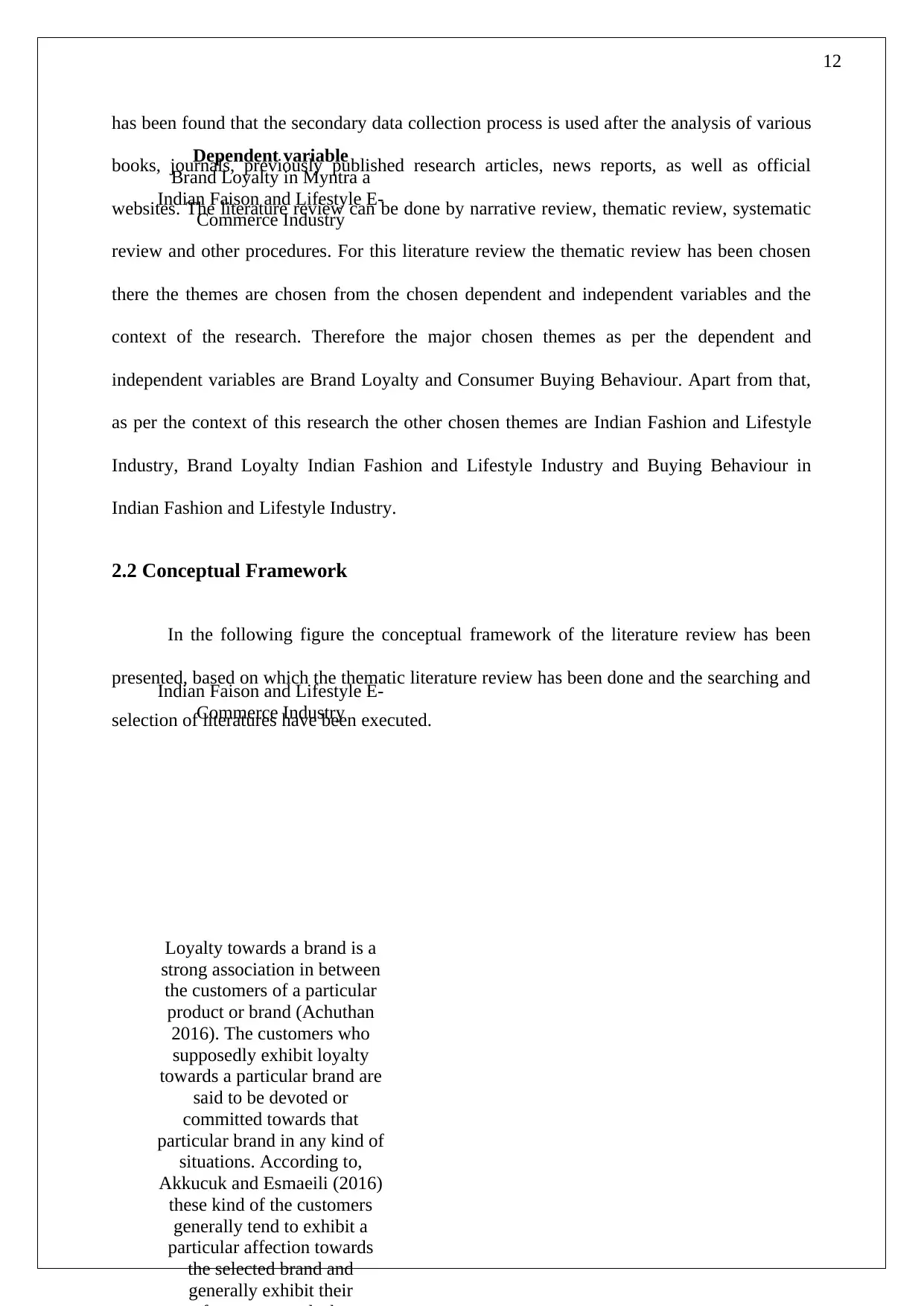
12
Dependent variable
Brand Loyalty in Myntra a
Indian Faison and Lifestyle E-
Commerce Industry
Indian Faison and Lifestyle E-
Commerce Industry
Loyalty towards a brand is a
strong association in between
the customers of a particular
product or brand (Achuthan
2016). The customers who
supposedly exhibit loyalty
towards a particular brand are
said to be devoted or
committed towards that
particular brand in any kind of
situations. According to,
Akkucuk and Esmaeili (2016)
these kind of the customers
generally tend to exhibit a
particular affection towards
the selected brand and
generally exhibit their
has been found that the secondary data collection process is used after the analysis of various
books, journals, previously published research articles, news reports, as well as official
websites. The literature review can be done by narrative review, thematic review, systematic
review and other procedures. For this literature review the thematic review has been chosen
there the themes are chosen from the chosen dependent and independent variables and the
context of the research. Therefore the major chosen themes as per the dependent and
independent variables are Brand Loyalty and Consumer Buying Behaviour. Apart from that,
as per the context of this research the other chosen themes are Indian Fashion and Lifestyle
Industry, Brand Loyalty Indian Fashion and Lifestyle Industry and Buying Behaviour in
Indian Fashion and Lifestyle Industry.
2.2 Conceptual Framework
In the following figure the conceptual framework of the literature review has been
presented, based on which the thematic literature review has been done and the searching and
selection of literatures have been executed.
Dependent variable
Brand Loyalty in Myntra a
Indian Faison and Lifestyle E-
Commerce Industry
Indian Faison and Lifestyle E-
Commerce Industry
Loyalty towards a brand is a
strong association in between
the customers of a particular
product or brand (Achuthan
2016). The customers who
supposedly exhibit loyalty
towards a particular brand are
said to be devoted or
committed towards that
particular brand in any kind of
situations. According to,
Akkucuk and Esmaeili (2016)
these kind of the customers
generally tend to exhibit a
particular affection towards
the selected brand and
generally exhibit their
has been found that the secondary data collection process is used after the analysis of various
books, journals, previously published research articles, news reports, as well as official
websites. The literature review can be done by narrative review, thematic review, systematic
review and other procedures. For this literature review the thematic review has been chosen
there the themes are chosen from the chosen dependent and independent variables and the
context of the research. Therefore the major chosen themes as per the dependent and
independent variables are Brand Loyalty and Consumer Buying Behaviour. Apart from that,
as per the context of this research the other chosen themes are Indian Fashion and Lifestyle
Industry, Brand Loyalty Indian Fashion and Lifestyle Industry and Buying Behaviour in
Indian Fashion and Lifestyle Industry.
2.2 Conceptual Framework
In the following figure the conceptual framework of the literature review has been
presented, based on which the thematic literature review has been done and the searching and
selection of literatures have been executed.
Paraphrase This Document
Need a fresh take? Get an instant paraphrase of this document with our AI Paraphraser
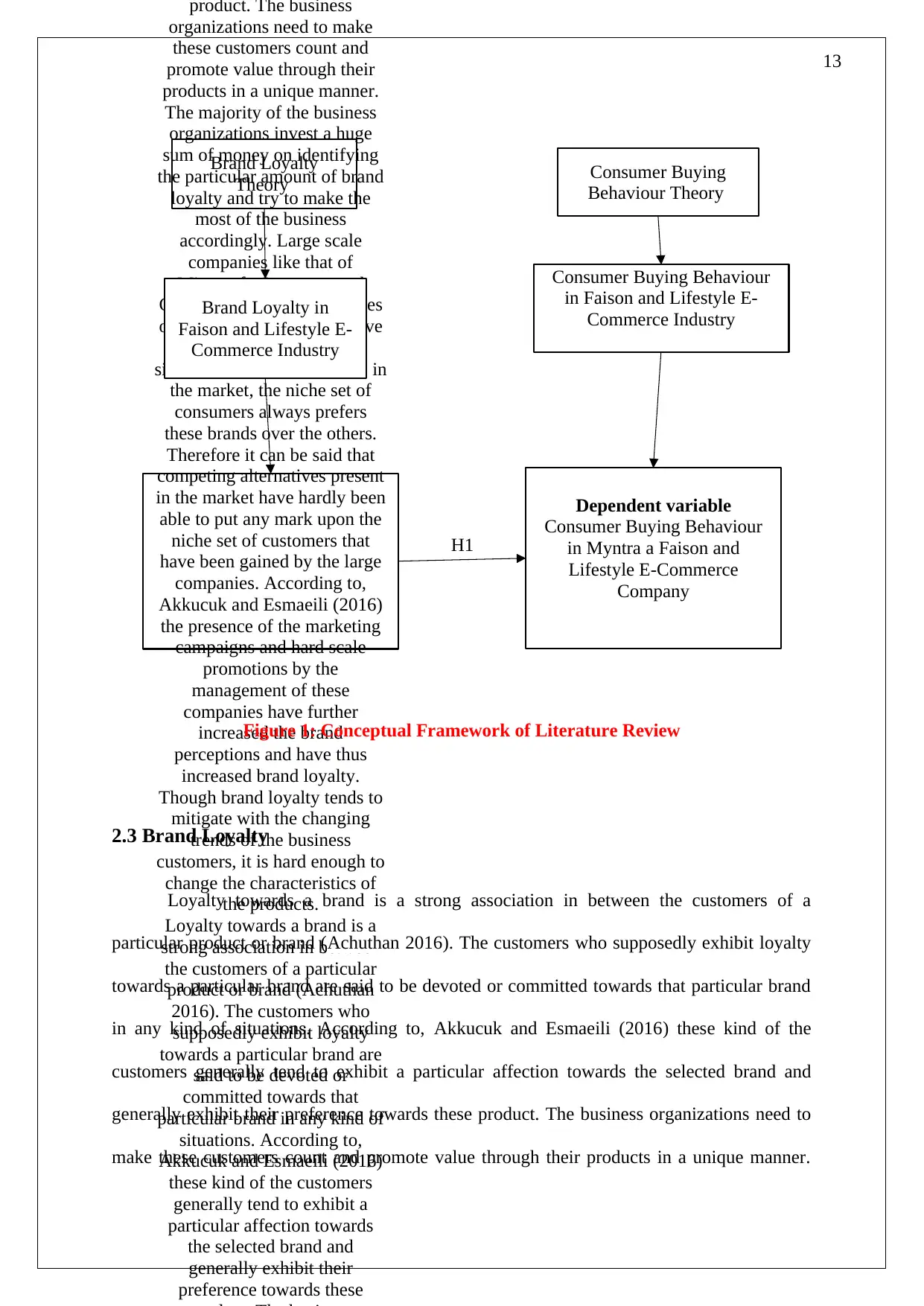
13
Brand Loyalty
Theory Consumer Buying
Behaviour Theory
Dependent variable
Consumer Buying Behaviour
in Myntra a Faison and
Lifestyle E-Commerce
Company
product. The business
organizations need to make
these customers count and
promote value through their
products in a unique manner.
The majority of the business
organizations invest a huge
sum of money on identifying
the particular amount of brand
loyalty and try to make the
most of the business
accordingly. Large scale
companies like that of
Microsoft, Samsung, and
Coca-Cola are great examples
of these particular perspective
as despite the presence of
similar and substitute brands in
the market, the niche set of
consumers always prefers
these brands over the others.
Therefore it can be said that
competing alternatives present
in the market have hardly been
able to put any mark upon the
niche set of customers that
have been gained by the large
companies. According to,
Akkucuk and Esmaeili (2016)
the presence of the marketing
campaigns and hard scale
promotions by the
management of these
companies have further
increased the brand
perceptions and have thus
increased brand loyalty.
Though brand loyalty tends to
mitigate with the changing
trends of the business
customers, it is hard enough to
change the characteristics of
the products.
Loyalty towards a brand is a
strong association in between
the customers of a particular
product or brand (Achuthan
2016). The customers who
supposedly exhibit loyalty
towards a particular brand are
said to be devoted or
committed towards that
particular brand in any kind of
situations. According to,
Akkucuk and Esmaeili (2016)
these kind of the customers
generally tend to exhibit a
particular affection towards
the selected brand and
generally exhibit their
preference towards these
Brand Loyalty in
Faison and Lifestyle E-
Commerce Industry
Consumer Buying Behaviour
in Faison and Lifestyle E-
Commerce Industry
H1
Figure 1: Conceptual Framework of Literature Review
2.3 Brand Loyalty
Loyalty towards a brand is a strong association in between the customers of a
particular product or brand (Achuthan 2016). The customers who supposedly exhibit loyalty
towards a particular brand are said to be devoted or committed towards that particular brand
in any kind of situations. According to, Akkucuk and Esmaeili (2016) these kind of the
customers generally tend to exhibit a particular affection towards the selected brand and
generally exhibit their preference towards these product. The business organizations need to
make these customers count and promote value through their products in a unique manner.
Brand Loyalty
Theory Consumer Buying
Behaviour Theory
Dependent variable
Consumer Buying Behaviour
in Myntra a Faison and
Lifestyle E-Commerce
Company
product. The business
organizations need to make
these customers count and
promote value through their
products in a unique manner.
The majority of the business
organizations invest a huge
sum of money on identifying
the particular amount of brand
loyalty and try to make the
most of the business
accordingly. Large scale
companies like that of
Microsoft, Samsung, and
Coca-Cola are great examples
of these particular perspective
as despite the presence of
similar and substitute brands in
the market, the niche set of
consumers always prefers
these brands over the others.
Therefore it can be said that
competing alternatives present
in the market have hardly been
able to put any mark upon the
niche set of customers that
have been gained by the large
companies. According to,
Akkucuk and Esmaeili (2016)
the presence of the marketing
campaigns and hard scale
promotions by the
management of these
companies have further
increased the brand
perceptions and have thus
increased brand loyalty.
Though brand loyalty tends to
mitigate with the changing
trends of the business
customers, it is hard enough to
change the characteristics of
the products.
Loyalty towards a brand is a
strong association in between
the customers of a particular
product or brand (Achuthan
2016). The customers who
supposedly exhibit loyalty
towards a particular brand are
said to be devoted or
committed towards that
particular brand in any kind of
situations. According to,
Akkucuk and Esmaeili (2016)
these kind of the customers
generally tend to exhibit a
particular affection towards
the selected brand and
generally exhibit their
preference towards these
Brand Loyalty in
Faison and Lifestyle E-
Commerce Industry
Consumer Buying Behaviour
in Faison and Lifestyle E-
Commerce Industry
H1
Figure 1: Conceptual Framework of Literature Review
2.3 Brand Loyalty
Loyalty towards a brand is a strong association in between the customers of a
particular product or brand (Achuthan 2016). The customers who supposedly exhibit loyalty
towards a particular brand are said to be devoted or committed towards that particular brand
in any kind of situations. According to, Akkucuk and Esmaeili (2016) these kind of the
customers generally tend to exhibit a particular affection towards the selected brand and
generally exhibit their preference towards these product. The business organizations need to
make these customers count and promote value through their products in a unique manner.
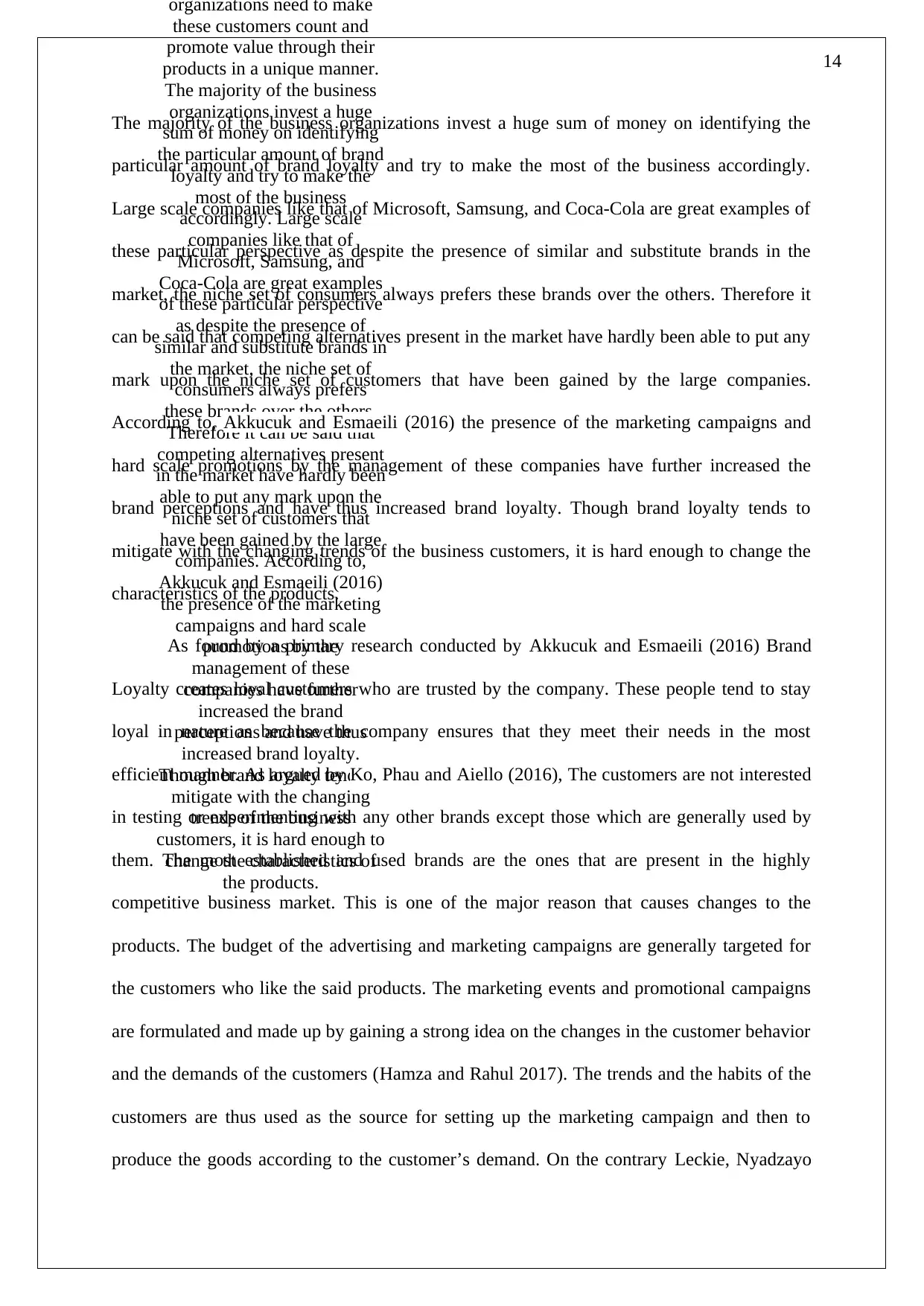
14
organizations need to make
these customers count and
promote value through their
products in a unique manner.
The majority of the business
organizations invest a huge
sum of money on identifying
the particular amount of brand
loyalty and try to make the
most of the business
accordingly. Large scale
companies like that of
Microsoft, Samsung, and
Coca-Cola are great examples
of these particular perspective
as despite the presence of
similar and substitute brands in
the market, the niche set of
consumers always prefers
these brands over the others.
Therefore it can be said that
competing alternatives present
in the market have hardly been
able to put any mark upon the
niche set of customers that
have been gained by the large
companies. According to,
Akkucuk and Esmaeili (2016)
the presence of the marketing
campaigns and hard scale
promotions by the
management of these
companies have further
increased the brand
perceptions and have thus
increased brand loyalty.
Though brand loyalty tends to
mitigate with the changing
trends of the business
customers, it is hard enough to
change the characteristics of
the products.
The majority of the business organizations invest a huge sum of money on identifying the
particular amount of brand loyalty and try to make the most of the business accordingly.
Large scale companies like that of Microsoft, Samsung, and Coca-Cola are great examples of
these particular perspective as despite the presence of similar and substitute brands in the
market, the niche set of consumers always prefers these brands over the others. Therefore it
can be said that competing alternatives present in the market have hardly been able to put any
mark upon the niche set of customers that have been gained by the large companies.
According to, Akkucuk and Esmaeili (2016) the presence of the marketing campaigns and
hard scale promotions by the management of these companies have further increased the
brand perceptions and have thus increased brand loyalty. Though brand loyalty tends to
mitigate with the changing trends of the business customers, it is hard enough to change the
characteristics of the products.
As found by a primary research conducted by Akkucuk and Esmaeili (2016) Brand
Loyalty creates loyal customers who are trusted by the company. These people tend to stay
loyal in nature as because the company ensures that they meet their needs in the most
efficient manner. As argued by Ko, Phau and Aiello (2016), The customers are not interested
in testing or experimenting with any other brands except those which are generally used by
them. The most established and used brands are the ones that are present in the highly
competitive business market. This is one of the major reason that causes changes to the
products. The budget of the advertising and marketing campaigns are generally targeted for
the customers who like the said products. The marketing events and promotional campaigns
are formulated and made up by gaining a strong idea on the changes in the customer behavior
and the demands of the customers (Hamza and Rahul 2017). The trends and the habits of the
customers are thus used as the source for setting up the marketing campaign and then to
produce the goods according to the customer’s demand. On the contrary Leckie, Nyadzayo
organizations need to make
these customers count and
promote value through their
products in a unique manner.
The majority of the business
organizations invest a huge
sum of money on identifying
the particular amount of brand
loyalty and try to make the
most of the business
accordingly. Large scale
companies like that of
Microsoft, Samsung, and
Coca-Cola are great examples
of these particular perspective
as despite the presence of
similar and substitute brands in
the market, the niche set of
consumers always prefers
these brands over the others.
Therefore it can be said that
competing alternatives present
in the market have hardly been
able to put any mark upon the
niche set of customers that
have been gained by the large
companies. According to,
Akkucuk and Esmaeili (2016)
the presence of the marketing
campaigns and hard scale
promotions by the
management of these
companies have further
increased the brand
perceptions and have thus
increased brand loyalty.
Though brand loyalty tends to
mitigate with the changing
trends of the business
customers, it is hard enough to
change the characteristics of
the products.
The majority of the business organizations invest a huge sum of money on identifying the
particular amount of brand loyalty and try to make the most of the business accordingly.
Large scale companies like that of Microsoft, Samsung, and Coca-Cola are great examples of
these particular perspective as despite the presence of similar and substitute brands in the
market, the niche set of consumers always prefers these brands over the others. Therefore it
can be said that competing alternatives present in the market have hardly been able to put any
mark upon the niche set of customers that have been gained by the large companies.
According to, Akkucuk and Esmaeili (2016) the presence of the marketing campaigns and
hard scale promotions by the management of these companies have further increased the
brand perceptions and have thus increased brand loyalty. Though brand loyalty tends to
mitigate with the changing trends of the business customers, it is hard enough to change the
characteristics of the products.
As found by a primary research conducted by Akkucuk and Esmaeili (2016) Brand
Loyalty creates loyal customers who are trusted by the company. These people tend to stay
loyal in nature as because the company ensures that they meet their needs in the most
efficient manner. As argued by Ko, Phau and Aiello (2016), The customers are not interested
in testing or experimenting with any other brands except those which are generally used by
them. The most established and used brands are the ones that are present in the highly
competitive business market. This is one of the major reason that causes changes to the
products. The budget of the advertising and marketing campaigns are generally targeted for
the customers who like the said products. The marketing events and promotional campaigns
are formulated and made up by gaining a strong idea on the changes in the customer behavior
and the demands of the customers (Hamza and Rahul 2017). The trends and the habits of the
customers are thus used as the source for setting up the marketing campaign and then to
produce the goods according to the customer’s demand. On the contrary Leckie, Nyadzayo
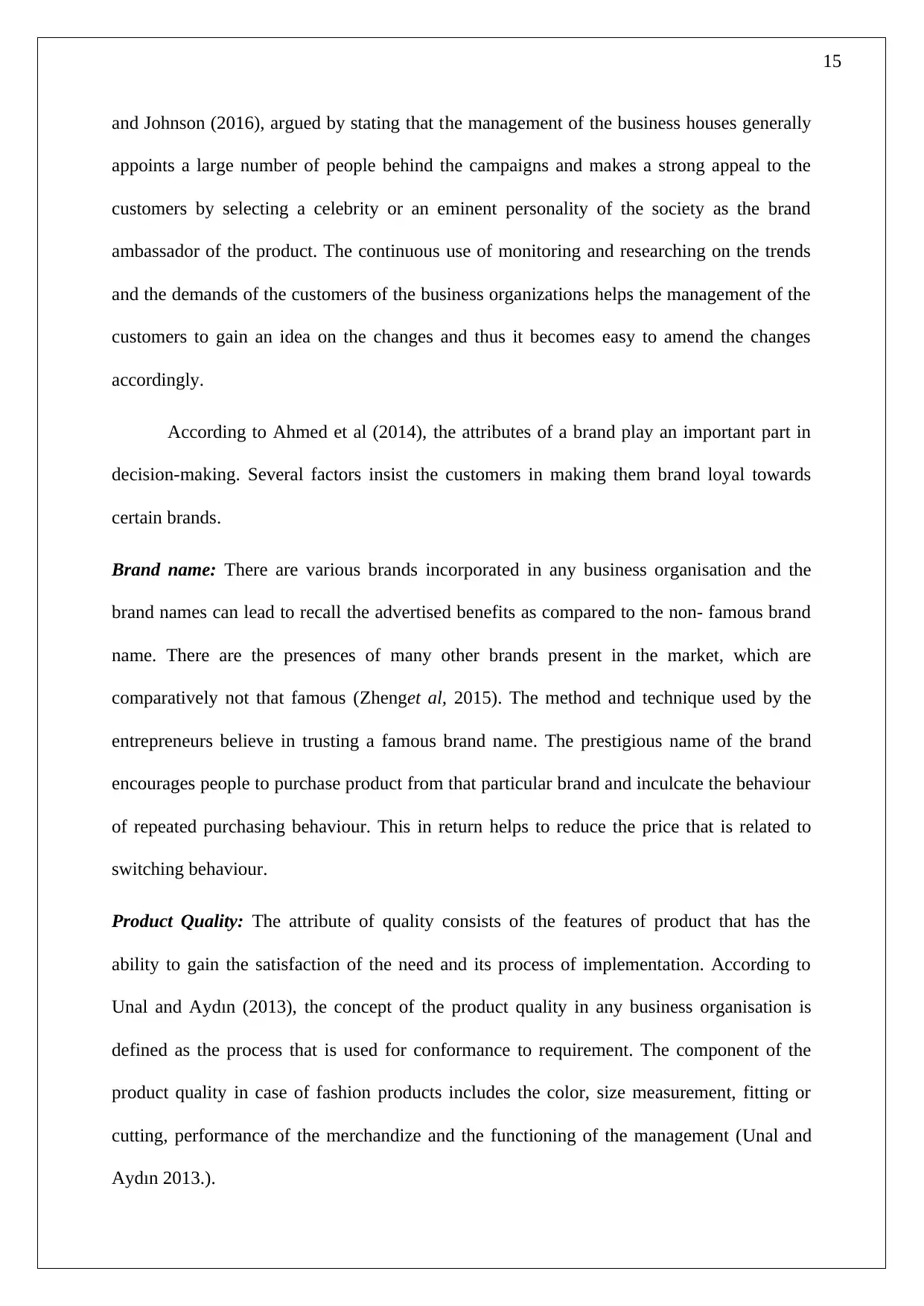
15
and Johnson (2016), argued by stating that the management of the business houses generally
appoints a large number of people behind the campaigns and makes a strong appeal to the
customers by selecting a celebrity or an eminent personality of the society as the brand
ambassador of the product. The continuous use of monitoring and researching on the trends
and the demands of the customers of the business organizations helps the management of the
customers to gain an idea on the changes and thus it becomes easy to amend the changes
accordingly.
According to Ahmed et al (2014), the attributes of a brand play an important part in
decision-making. Several factors insist the customers in making them brand loyal towards
certain brands.
Brand name: There are various brands incorporated in any business organisation and the
brand names can lead to recall the advertised benefits as compared to the non- famous brand
name. There are the presences of many other brands present in the market, which are
comparatively not that famous (Zhenget al, 2015). The method and technique used by the
entrepreneurs believe in trusting a famous brand name. The prestigious name of the brand
encourages people to purchase product from that particular brand and inculcate the behaviour
of repeated purchasing behaviour. This in return helps to reduce the price that is related to
switching behaviour.
Product Quality: The attribute of quality consists of the features of product that has the
ability to gain the satisfaction of the need and its process of implementation. According to
Unal and Aydın (2013), the concept of the product quality in any business organisation is
defined as the process that is used for conformance to requirement. The component of the
product quality in case of fashion products includes the color, size measurement, fitting or
cutting, performance of the merchandize and the functioning of the management (Unal and
Aydın 2013.).
and Johnson (2016), argued by stating that the management of the business houses generally
appoints a large number of people behind the campaigns and makes a strong appeal to the
customers by selecting a celebrity or an eminent personality of the society as the brand
ambassador of the product. The continuous use of monitoring and researching on the trends
and the demands of the customers of the business organizations helps the management of the
customers to gain an idea on the changes and thus it becomes easy to amend the changes
accordingly.
According to Ahmed et al (2014), the attributes of a brand play an important part in
decision-making. Several factors insist the customers in making them brand loyal towards
certain brands.
Brand name: There are various brands incorporated in any business organisation and the
brand names can lead to recall the advertised benefits as compared to the non- famous brand
name. There are the presences of many other brands present in the market, which are
comparatively not that famous (Zhenget al, 2015). The method and technique used by the
entrepreneurs believe in trusting a famous brand name. The prestigious name of the brand
encourages people to purchase product from that particular brand and inculcate the behaviour
of repeated purchasing behaviour. This in return helps to reduce the price that is related to
switching behaviour.
Product Quality: The attribute of quality consists of the features of product that has the
ability to gain the satisfaction of the need and its process of implementation. According to
Unal and Aydın (2013), the concept of the product quality in any business organisation is
defined as the process that is used for conformance to requirement. The component of the
product quality in case of fashion products includes the color, size measurement, fitting or
cutting, performance of the merchandize and the functioning of the management (Unal and
Aydın 2013.).
Secure Best Marks with AI Grader
Need help grading? Try our AI Grader for instant feedback on your assignments.
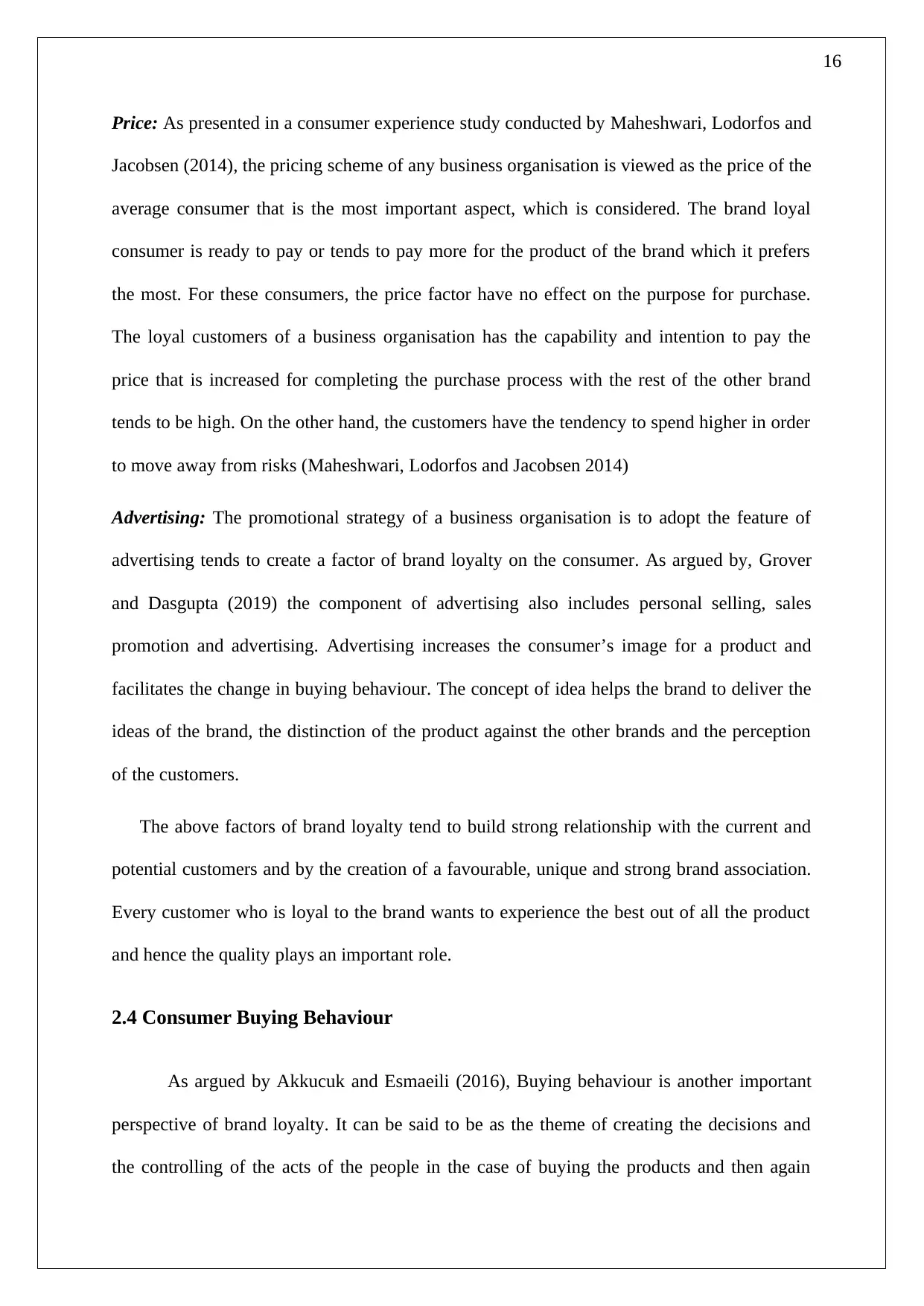
16
Price: As presented in a consumer experience study conducted by Maheshwari, Lodorfos and
Jacobsen (2014), the pricing scheme of any business organisation is viewed as the price of the
average consumer that is the most important aspect, which is considered. The brand loyal
consumer is ready to pay or tends to pay more for the product of the brand which it prefers
the most. For these consumers, the price factor have no effect on the purpose for purchase.
The loyal customers of a business organisation has the capability and intention to pay the
price that is increased for completing the purchase process with the rest of the other brand
tends to be high. On the other hand, the customers have the tendency to spend higher in order
to move away from risks (Maheshwari, Lodorfos and Jacobsen 2014)
Advertising: The promotional strategy of a business organisation is to adopt the feature of
advertising tends to create a factor of brand loyalty on the consumer. As argued by, Grover
and Dasgupta (2019) the component of advertising also includes personal selling, sales
promotion and advertising. Advertising increases the consumer’s image for a product and
facilitates the change in buying behaviour. The concept of idea helps the brand to deliver the
ideas of the brand, the distinction of the product against the other brands and the perception
of the customers.
The above factors of brand loyalty tend to build strong relationship with the current and
potential customers and by the creation of a favourable, unique and strong brand association.
Every customer who is loyal to the brand wants to experience the best out of all the product
and hence the quality plays an important role.
2.4 Consumer Buying Behaviour
As argued by Akkucuk and Esmaeili (2016), Buying behaviour is another important
perspective of brand loyalty. It can be said to be as the theme of creating the decisions and
the controlling of the acts of the people in the case of buying the products and then again
Price: As presented in a consumer experience study conducted by Maheshwari, Lodorfos and
Jacobsen (2014), the pricing scheme of any business organisation is viewed as the price of the
average consumer that is the most important aspect, which is considered. The brand loyal
consumer is ready to pay or tends to pay more for the product of the brand which it prefers
the most. For these consumers, the price factor have no effect on the purpose for purchase.
The loyal customers of a business organisation has the capability and intention to pay the
price that is increased for completing the purchase process with the rest of the other brand
tends to be high. On the other hand, the customers have the tendency to spend higher in order
to move away from risks (Maheshwari, Lodorfos and Jacobsen 2014)
Advertising: The promotional strategy of a business organisation is to adopt the feature of
advertising tends to create a factor of brand loyalty on the consumer. As argued by, Grover
and Dasgupta (2019) the component of advertising also includes personal selling, sales
promotion and advertising. Advertising increases the consumer’s image for a product and
facilitates the change in buying behaviour. The concept of idea helps the brand to deliver the
ideas of the brand, the distinction of the product against the other brands and the perception
of the customers.
The above factors of brand loyalty tend to build strong relationship with the current and
potential customers and by the creation of a favourable, unique and strong brand association.
Every customer who is loyal to the brand wants to experience the best out of all the product
and hence the quality plays an important role.
2.4 Consumer Buying Behaviour
As argued by Akkucuk and Esmaeili (2016), Buying behaviour is another important
perspective of brand loyalty. It can be said to be as the theme of creating the decisions and
the controlling of the acts of the people in the case of buying the products and then again
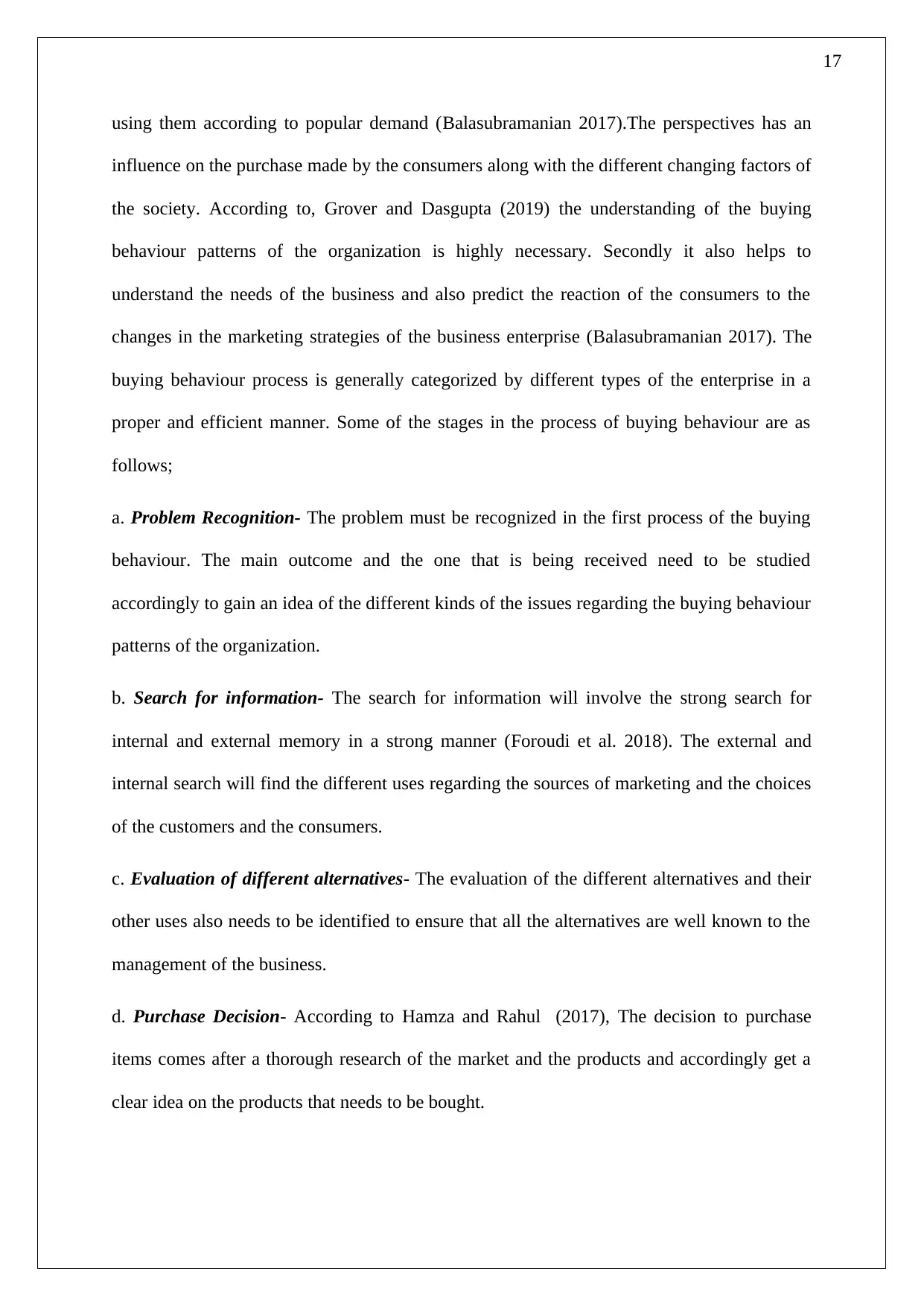
17
using them according to popular demand (Balasubramanian 2017).The perspectives has an
influence on the purchase made by the consumers along with the different changing factors of
the society. According to, Grover and Dasgupta (2019) the understanding of the buying
behaviour patterns of the organization is highly necessary. Secondly it also helps to
understand the needs of the business and also predict the reaction of the consumers to the
changes in the marketing strategies of the business enterprise (Balasubramanian 2017). The
buying behaviour process is generally categorized by different types of the enterprise in a
proper and efficient manner. Some of the stages in the process of buying behaviour are as
follows;
a. Problem Recognition- The problem must be recognized in the first process of the buying
behaviour. The main outcome and the one that is being received need to be studied
accordingly to gain an idea of the different kinds of the issues regarding the buying behaviour
patterns of the organization.
b. Search for information- The search for information will involve the strong search for
internal and external memory in a strong manner (Foroudi et al. 2018). The external and
internal search will find the different uses regarding the sources of marketing and the choices
of the customers and the consumers.
c. Evaluation of different alternatives- The evaluation of the different alternatives and their
other uses also needs to be identified to ensure that all the alternatives are well known to the
management of the business.
d. Purchase Decision- According to Hamza and Rahul (2017), The decision to purchase
items comes after a thorough research of the market and the products and accordingly get a
clear idea on the products that needs to be bought.
using them according to popular demand (Balasubramanian 2017).The perspectives has an
influence on the purchase made by the consumers along with the different changing factors of
the society. According to, Grover and Dasgupta (2019) the understanding of the buying
behaviour patterns of the organization is highly necessary. Secondly it also helps to
understand the needs of the business and also predict the reaction of the consumers to the
changes in the marketing strategies of the business enterprise (Balasubramanian 2017). The
buying behaviour process is generally categorized by different types of the enterprise in a
proper and efficient manner. Some of the stages in the process of buying behaviour are as
follows;
a. Problem Recognition- The problem must be recognized in the first process of the buying
behaviour. The main outcome and the one that is being received need to be studied
accordingly to gain an idea of the different kinds of the issues regarding the buying behaviour
patterns of the organization.
b. Search for information- The search for information will involve the strong search for
internal and external memory in a strong manner (Foroudi et al. 2018). The external and
internal search will find the different uses regarding the sources of marketing and the choices
of the customers and the consumers.
c. Evaluation of different alternatives- The evaluation of the different alternatives and their
other uses also needs to be identified to ensure that all the alternatives are well known to the
management of the business.
d. Purchase Decision- According to Hamza and Rahul (2017), The decision to purchase
items comes after a thorough research of the market and the products and accordingly get a
clear idea on the products that needs to be bought.
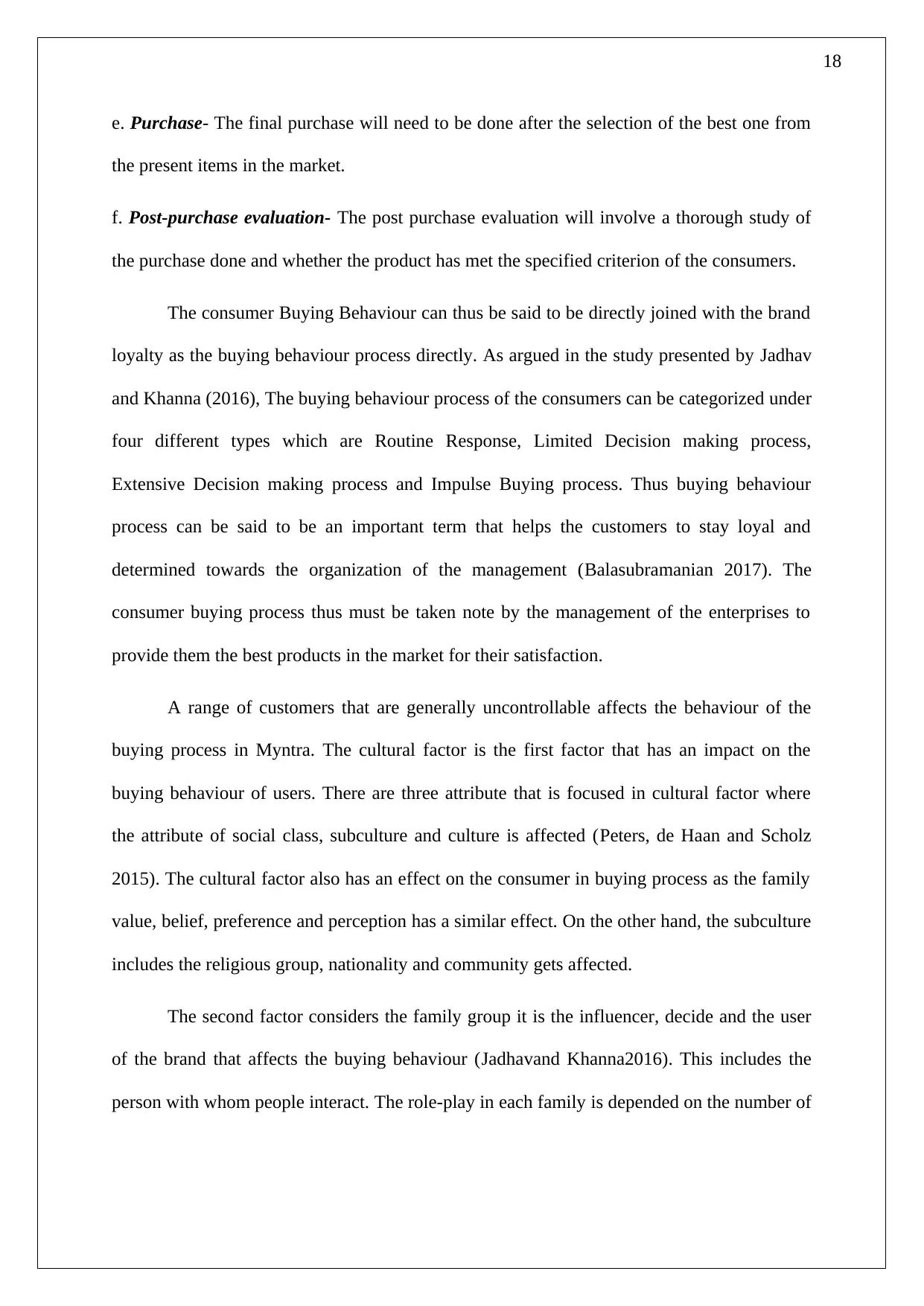
18
e. Purchase- The final purchase will need to be done after the selection of the best one from
the present items in the market.
f. Post-purchase evaluation- The post purchase evaluation will involve a thorough study of
the purchase done and whether the product has met the specified criterion of the consumers.
The consumer Buying Behaviour can thus be said to be directly joined with the brand
loyalty as the buying behaviour process directly. As argued in the study presented by Jadhav
and Khanna (2016), The buying behaviour process of the consumers can be categorized under
four different types which are Routine Response, Limited Decision making process,
Extensive Decision making process and Impulse Buying process. Thus buying behaviour
process can be said to be an important term that helps the customers to stay loyal and
determined towards the organization of the management (Balasubramanian 2017). The
consumer buying process thus must be taken note by the management of the enterprises to
provide them the best products in the market for their satisfaction.
A range of customers that are generally uncontrollable affects the behaviour of the
buying process in Myntra. The cultural factor is the first factor that has an impact on the
buying behaviour of users. There are three attribute that is focused in cultural factor where
the attribute of social class, subculture and culture is affected (Peters, de Haan and Scholz
2015). The cultural factor also has an effect on the consumer in buying process as the family
value, belief, preference and perception has a similar effect. On the other hand, the subculture
includes the religious group, nationality and community gets affected.
The second factor considers the family group it is the influencer, decide and the user
of the brand that affects the buying behaviour (Jadhavand Khanna2016). This includes the
person with whom people interact. The role-play in each family is depended on the number of
e. Purchase- The final purchase will need to be done after the selection of the best one from
the present items in the market.
f. Post-purchase evaluation- The post purchase evaluation will involve a thorough study of
the purchase done and whether the product has met the specified criterion of the consumers.
The consumer Buying Behaviour can thus be said to be directly joined with the brand
loyalty as the buying behaviour process directly. As argued in the study presented by Jadhav
and Khanna (2016), The buying behaviour process of the consumers can be categorized under
four different types which are Routine Response, Limited Decision making process,
Extensive Decision making process and Impulse Buying process. Thus buying behaviour
process can be said to be an important term that helps the customers to stay loyal and
determined towards the organization of the management (Balasubramanian 2017). The
consumer buying process thus must be taken note by the management of the enterprises to
provide them the best products in the market for their satisfaction.
A range of customers that are generally uncontrollable affects the behaviour of the
buying process in Myntra. The cultural factor is the first factor that has an impact on the
buying behaviour of users. There are three attribute that is focused in cultural factor where
the attribute of social class, subculture and culture is affected (Peters, de Haan and Scholz
2015). The cultural factor also has an effect on the consumer in buying process as the family
value, belief, preference and perception has a similar effect. On the other hand, the subculture
includes the religious group, nationality and community gets affected.
The second factor considers the family group it is the influencer, decide and the user
of the brand that affects the buying behaviour (Jadhavand Khanna2016). This includes the
person with whom people interact. The role-play in each family is depended on the number of
Paraphrase This Document
Need a fresh take? Get an instant paraphrase of this document with our AI Paraphraser
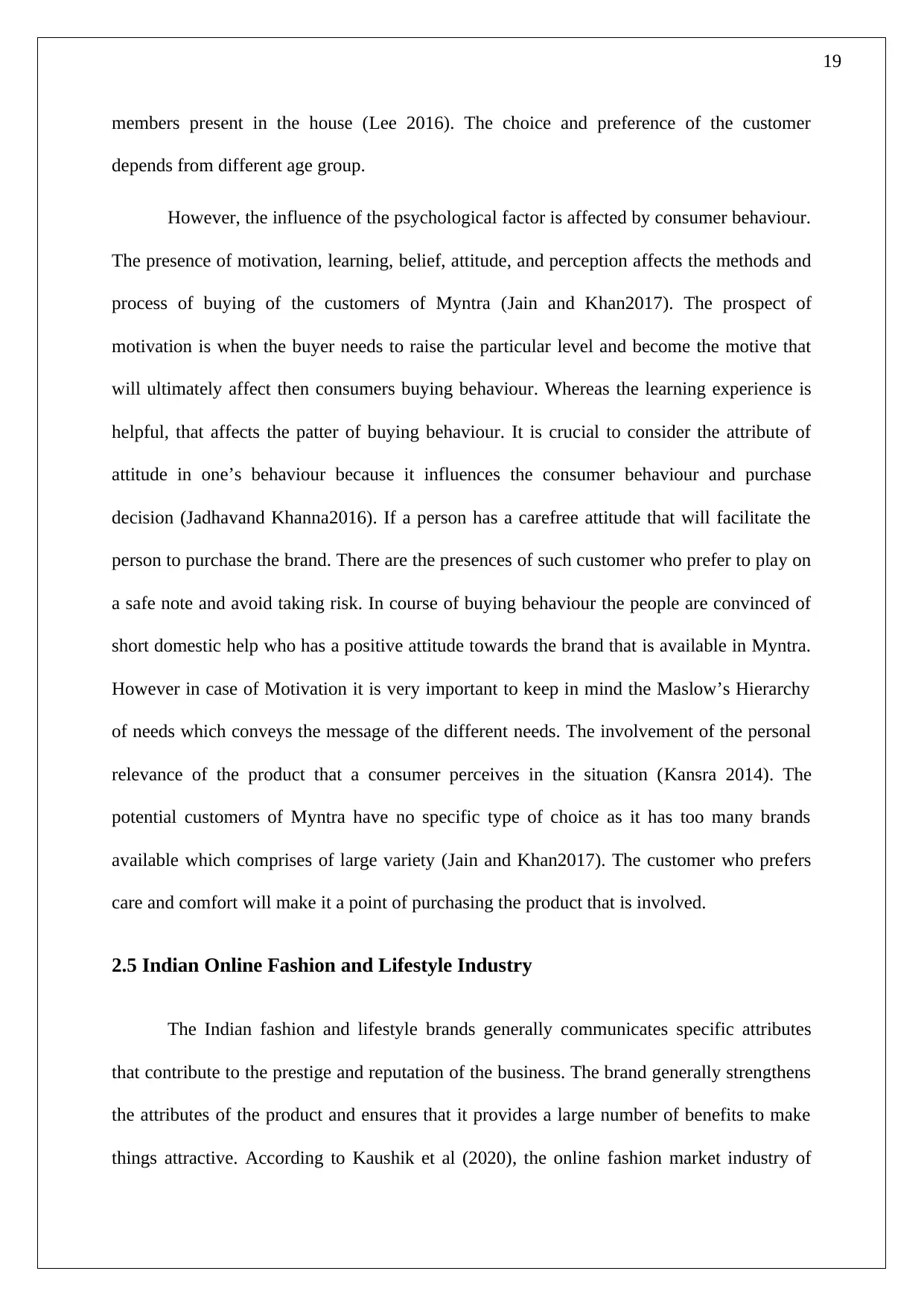
19
members present in the house (Lee 2016). The choice and preference of the customer
depends from different age group.
However, the influence of the psychological factor is affected by consumer behaviour.
The presence of motivation, learning, belief, attitude, and perception affects the methods and
process of buying of the customers of Myntra (Jain and Khan2017). The prospect of
motivation is when the buyer needs to raise the particular level and become the motive that
will ultimately affect then consumers buying behaviour. Whereas the learning experience is
helpful, that affects the patter of buying behaviour. It is crucial to consider the attribute of
attitude in one’s behaviour because it influences the consumer behaviour and purchase
decision (Jadhavand Khanna2016). If a person has a carefree attitude that will facilitate the
person to purchase the brand. There are the presences of such customer who prefer to play on
a safe note and avoid taking risk. In course of buying behaviour the people are convinced of
short domestic help who has a positive attitude towards the brand that is available in Myntra.
However in case of Motivation it is very important to keep in mind the Maslow’s Hierarchy
of needs which conveys the message of the different needs. The involvement of the personal
relevance of the product that a consumer perceives in the situation (Kansra 2014). The
potential customers of Myntra have no specific type of choice as it has too many brands
available which comprises of large variety (Jain and Khan2017). The customer who prefers
care and comfort will make it a point of purchasing the product that is involved.
2.5 Indian Online Fashion and Lifestyle Industry
The Indian fashion and lifestyle brands generally communicates specific attributes
that contribute to the prestige and reputation of the business. The brand generally strengthens
the attributes of the product and ensures that it provides a large number of benefits to make
things attractive. According to Kaushik et al (2020), the online fashion market industry of
members present in the house (Lee 2016). The choice and preference of the customer
depends from different age group.
However, the influence of the psychological factor is affected by consumer behaviour.
The presence of motivation, learning, belief, attitude, and perception affects the methods and
process of buying of the customers of Myntra (Jain and Khan2017). The prospect of
motivation is when the buyer needs to raise the particular level and become the motive that
will ultimately affect then consumers buying behaviour. Whereas the learning experience is
helpful, that affects the patter of buying behaviour. It is crucial to consider the attribute of
attitude in one’s behaviour because it influences the consumer behaviour and purchase
decision (Jadhavand Khanna2016). If a person has a carefree attitude that will facilitate the
person to purchase the brand. There are the presences of such customer who prefer to play on
a safe note and avoid taking risk. In course of buying behaviour the people are convinced of
short domestic help who has a positive attitude towards the brand that is available in Myntra.
However in case of Motivation it is very important to keep in mind the Maslow’s Hierarchy
of needs which conveys the message of the different needs. The involvement of the personal
relevance of the product that a consumer perceives in the situation (Kansra 2014). The
potential customers of Myntra have no specific type of choice as it has too many brands
available which comprises of large variety (Jain and Khan2017). The customer who prefers
care and comfort will make it a point of purchasing the product that is involved.
2.5 Indian Online Fashion and Lifestyle Industry
The Indian fashion and lifestyle brands generally communicates specific attributes
that contribute to the prestige and reputation of the business. The brand generally strengthens
the attributes of the product and ensures that it provides a large number of benefits to make
things attractive. According to Kaushik et al (2020), the online fashion market industry of
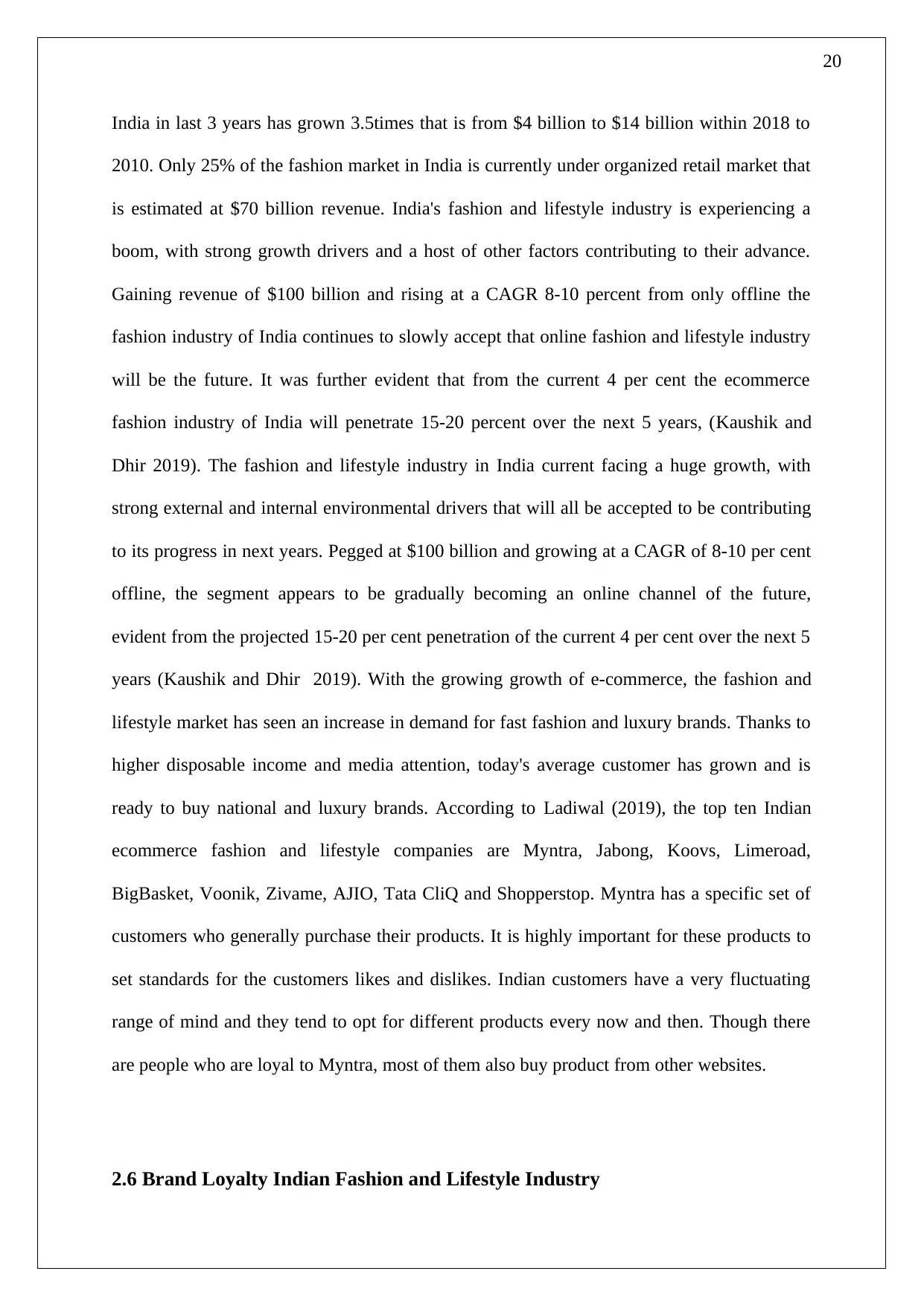
20
India in last 3 years has grown 3.5times that is from $4 billion to $14 billion within 2018 to
2010. Only 25% of the fashion market in India is currently under organized retail market that
is estimated at $70 billion revenue. India's fashion and lifestyle industry is experiencing a
boom, with strong growth drivers and a host of other factors contributing to their advance.
Gaining revenue of $100 billion and rising at a CAGR 8-10 percent from only offline the
fashion industry of India continues to slowly accept that online fashion and lifestyle industry
will be the future. It was further evident that from the current 4 per cent the ecommerce
fashion industry of India will penetrate 15-20 percent over the next 5 years, (Kaushik and
Dhir 2019). The fashion and lifestyle industry in India current facing a huge growth, with
strong external and internal environmental drivers that will all be accepted to be contributing
to its progress in next years. Pegged at $100 billion and growing at a CAGR of 8-10 per cent
offline, the segment appears to be gradually becoming an online channel of the future,
evident from the projected 15-20 per cent penetration of the current 4 per cent over the next 5
years (Kaushik and Dhir 2019). With the growing growth of e-commerce, the fashion and
lifestyle market has seen an increase in demand for fast fashion and luxury brands. Thanks to
higher disposable income and media attention, today's average customer has grown and is
ready to buy national and luxury brands. According to Ladiwal (2019), the top ten Indian
ecommerce fashion and lifestyle companies are Myntra, Jabong, Koovs, Limeroad,
BigBasket, Voonik, Zivame, AJIO, Tata CliQ and Shopperstop. Myntra has a specific set of
customers who generally purchase their products. It is highly important for these products to
set standards for the customers likes and dislikes. Indian customers have a very fluctuating
range of mind and they tend to opt for different products every now and then. Though there
are people who are loyal to Myntra, most of them also buy product from other websites.
2.6 Brand Loyalty Indian Fashion and Lifestyle Industry
India in last 3 years has grown 3.5times that is from $4 billion to $14 billion within 2018 to
2010. Only 25% of the fashion market in India is currently under organized retail market that
is estimated at $70 billion revenue. India's fashion and lifestyle industry is experiencing a
boom, with strong growth drivers and a host of other factors contributing to their advance.
Gaining revenue of $100 billion and rising at a CAGR 8-10 percent from only offline the
fashion industry of India continues to slowly accept that online fashion and lifestyle industry
will be the future. It was further evident that from the current 4 per cent the ecommerce
fashion industry of India will penetrate 15-20 percent over the next 5 years, (Kaushik and
Dhir 2019). The fashion and lifestyle industry in India current facing a huge growth, with
strong external and internal environmental drivers that will all be accepted to be contributing
to its progress in next years. Pegged at $100 billion and growing at a CAGR of 8-10 per cent
offline, the segment appears to be gradually becoming an online channel of the future,
evident from the projected 15-20 per cent penetration of the current 4 per cent over the next 5
years (Kaushik and Dhir 2019). With the growing growth of e-commerce, the fashion and
lifestyle market has seen an increase in demand for fast fashion and luxury brands. Thanks to
higher disposable income and media attention, today's average customer has grown and is
ready to buy national and luxury brands. According to Ladiwal (2019), the top ten Indian
ecommerce fashion and lifestyle companies are Myntra, Jabong, Koovs, Limeroad,
BigBasket, Voonik, Zivame, AJIO, Tata CliQ and Shopperstop. Myntra has a specific set of
customers who generally purchase their products. It is highly important for these products to
set standards for the customers likes and dislikes. Indian customers have a very fluctuating
range of mind and they tend to opt for different products every now and then. Though there
are people who are loyal to Myntra, most of them also buy product from other websites.
2.6 Brand Loyalty Indian Fashion and Lifestyle Industry
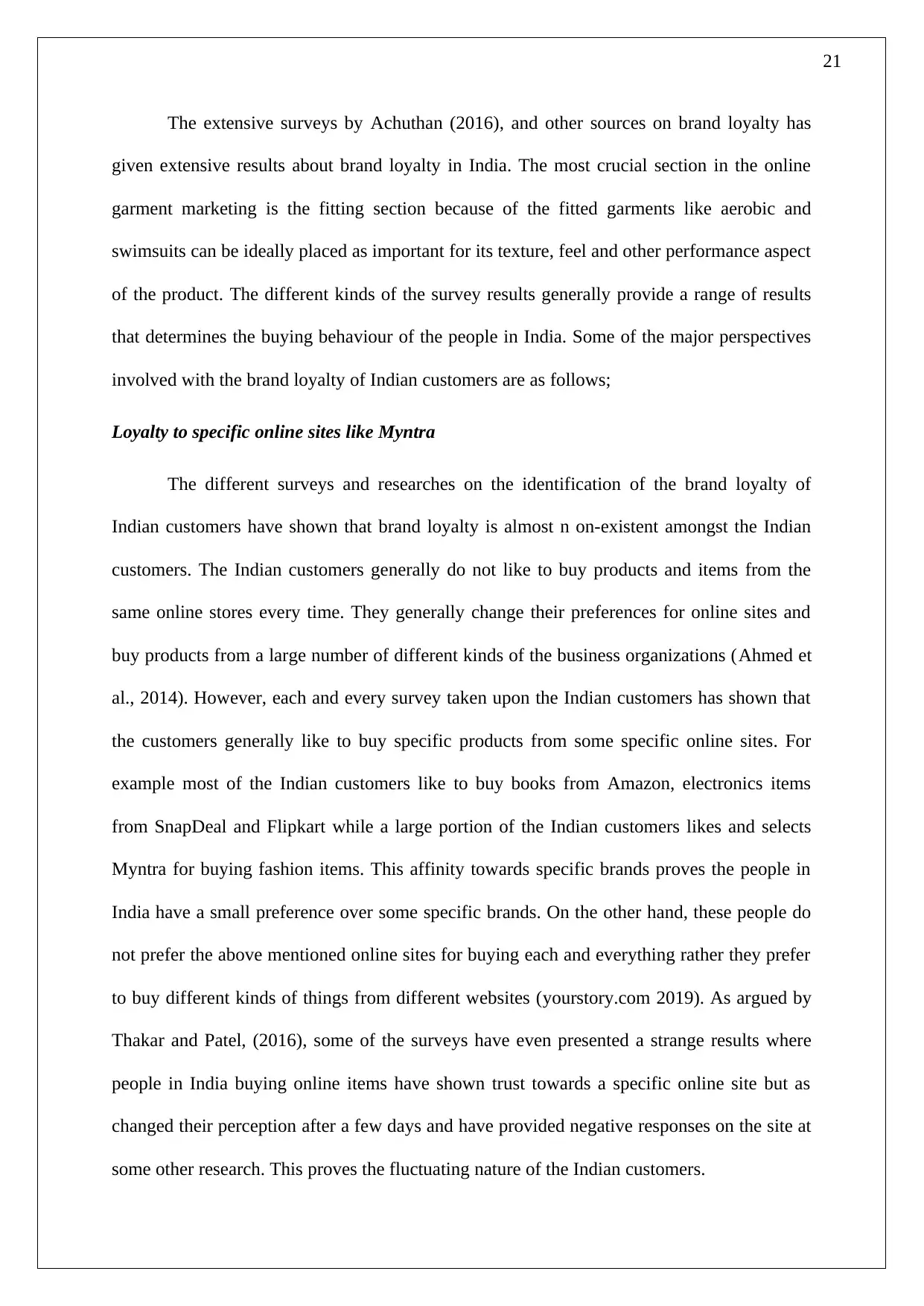
21
The extensive surveys by Achuthan (2016), and other sources on brand loyalty has
given extensive results about brand loyalty in India. The most crucial section in the online
garment marketing is the fitting section because of the fitted garments like aerobic and
swimsuits can be ideally placed as important for its texture, feel and other performance aspect
of the product. The different kinds of the survey results generally provide a range of results
that determines the buying behaviour of the people in India. Some of the major perspectives
involved with the brand loyalty of Indian customers are as follows;
Loyalty to specific online sites like Myntra
The different surveys and researches on the identification of the brand loyalty of
Indian customers have shown that brand loyalty is almost n on-existent amongst the Indian
customers. The Indian customers generally do not like to buy products and items from the
same online stores every time. They generally change their preferences for online sites and
buy products from a large number of different kinds of the business organizations (Ahmed et
al., 2014). However, each and every survey taken upon the Indian customers has shown that
the customers generally like to buy specific products from some specific online sites. For
example most of the Indian customers like to buy books from Amazon, electronics items
from SnapDeal and Flipkart while a large portion of the Indian customers likes and selects
Myntra for buying fashion items. This affinity towards specific brands proves the people in
India have a small preference over some specific brands. On the other hand, these people do
not prefer the above mentioned online sites for buying each and everything rather they prefer
to buy different kinds of things from different websites (yourstory.com 2019). As argued by
Thakar and Patel, (2016), some of the surveys have even presented a strange results where
people in India buying online items have shown trust towards a specific online site but as
changed their perception after a few days and have provided negative responses on the site at
some other research. This proves the fluctuating nature of the Indian customers.
The extensive surveys by Achuthan (2016), and other sources on brand loyalty has
given extensive results about brand loyalty in India. The most crucial section in the online
garment marketing is the fitting section because of the fitted garments like aerobic and
swimsuits can be ideally placed as important for its texture, feel and other performance aspect
of the product. The different kinds of the survey results generally provide a range of results
that determines the buying behaviour of the people in India. Some of the major perspectives
involved with the brand loyalty of Indian customers are as follows;
Loyalty to specific online sites like Myntra
The different surveys and researches on the identification of the brand loyalty of
Indian customers have shown that brand loyalty is almost n on-existent amongst the Indian
customers. The Indian customers generally do not like to buy products and items from the
same online stores every time. They generally change their preferences for online sites and
buy products from a large number of different kinds of the business organizations (Ahmed et
al., 2014). However, each and every survey taken upon the Indian customers has shown that
the customers generally like to buy specific products from some specific online sites. For
example most of the Indian customers like to buy books from Amazon, electronics items
from SnapDeal and Flipkart while a large portion of the Indian customers likes and selects
Myntra for buying fashion items. This affinity towards specific brands proves the people in
India have a small preference over some specific brands. On the other hand, these people do
not prefer the above mentioned online sites for buying each and everything rather they prefer
to buy different kinds of things from different websites (yourstory.com 2019). As argued by
Thakar and Patel, (2016), some of the surveys have even presented a strange results where
people in India buying online items have shown trust towards a specific online site but as
changed their perception after a few days and have provided negative responses on the site at
some other research. This proves the fluctuating nature of the Indian customers.
Secure Best Marks with AI Grader
Need help grading? Try our AI Grader for instant feedback on your assignments.
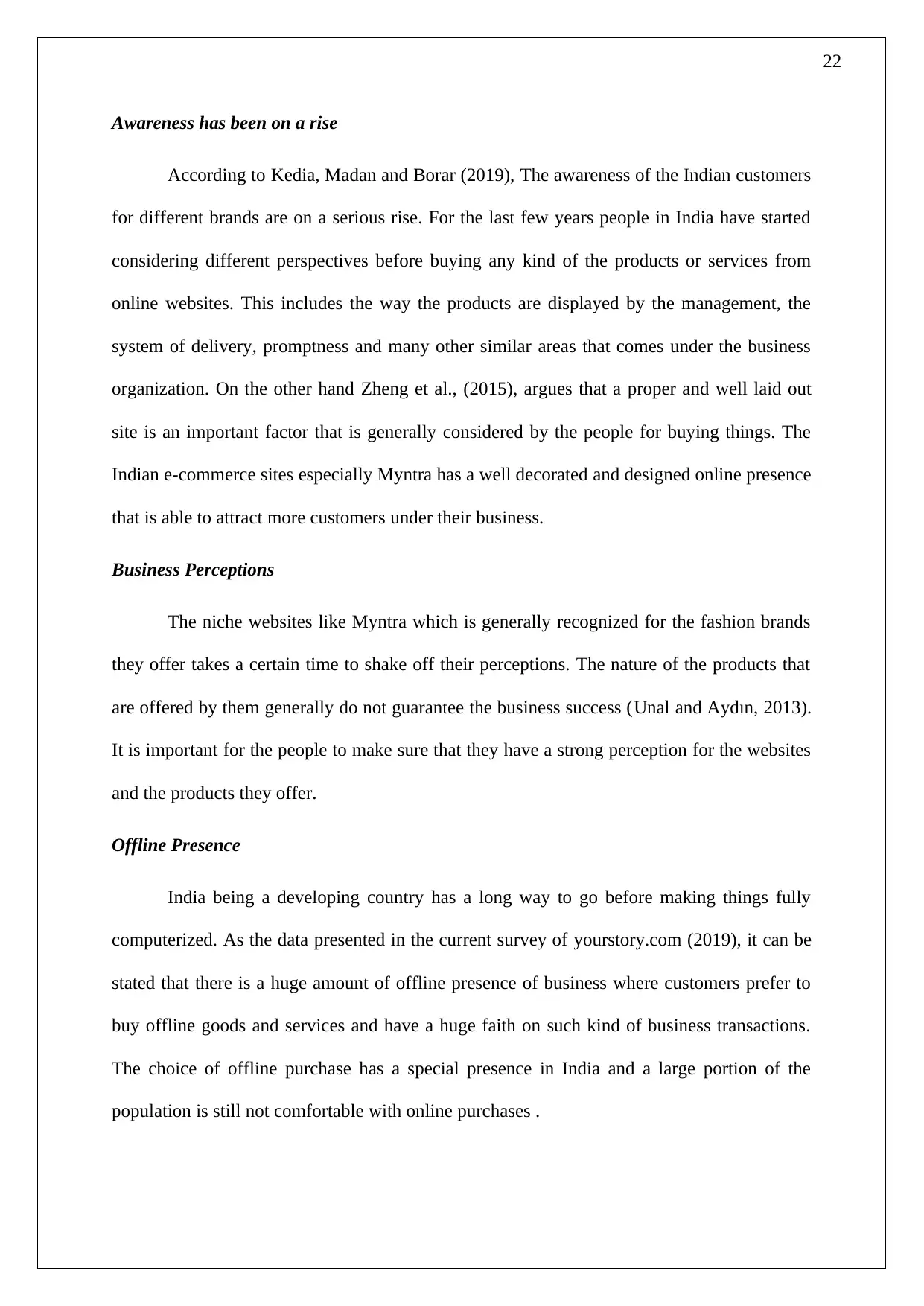
22
Awareness has been on a rise
According to Kedia, Madan and Borar (2019), The awareness of the Indian customers
for different brands are on a serious rise. For the last few years people in India have started
considering different perspectives before buying any kind of the products or services from
online websites. This includes the way the products are displayed by the management, the
system of delivery, promptness and many other similar areas that comes under the business
organization. On the other hand Zheng et al., (2015), argues that a proper and well laid out
site is an important factor that is generally considered by the people for buying things. The
Indian e-commerce sites especially Myntra has a well decorated and designed online presence
that is able to attract more customers under their business.
Business Perceptions
The niche websites like Myntra which is generally recognized for the fashion brands
they offer takes a certain time to shake off their perceptions. The nature of the products that
are offered by them generally do not guarantee the business success (Unal and Aydın, 2013).
It is important for the people to make sure that they have a strong perception for the websites
and the products they offer.
Offline Presence
India being a developing country has a long way to go before making things fully
computerized. As the data presented in the current survey of yourstory.com (2019), it can be
stated that there is a huge amount of offline presence of business where customers prefer to
buy offline goods and services and have a huge faith on such kind of business transactions.
The choice of offline purchase has a special presence in India and a large portion of the
population is still not comfortable with online purchases .
Awareness has been on a rise
According to Kedia, Madan and Borar (2019), The awareness of the Indian customers
for different brands are on a serious rise. For the last few years people in India have started
considering different perspectives before buying any kind of the products or services from
online websites. This includes the way the products are displayed by the management, the
system of delivery, promptness and many other similar areas that comes under the business
organization. On the other hand Zheng et al., (2015), argues that a proper and well laid out
site is an important factor that is generally considered by the people for buying things. The
Indian e-commerce sites especially Myntra has a well decorated and designed online presence
that is able to attract more customers under their business.
Business Perceptions
The niche websites like Myntra which is generally recognized for the fashion brands
they offer takes a certain time to shake off their perceptions. The nature of the products that
are offered by them generally do not guarantee the business success (Unal and Aydın, 2013).
It is important for the people to make sure that they have a strong perception for the websites
and the products they offer.
Offline Presence
India being a developing country has a long way to go before making things fully
computerized. As the data presented in the current survey of yourstory.com (2019), it can be
stated that there is a huge amount of offline presence of business where customers prefer to
buy offline goods and services and have a huge faith on such kind of business transactions.
The choice of offline purchase has a special presence in India and a large portion of the
population is still not comfortable with online purchases .
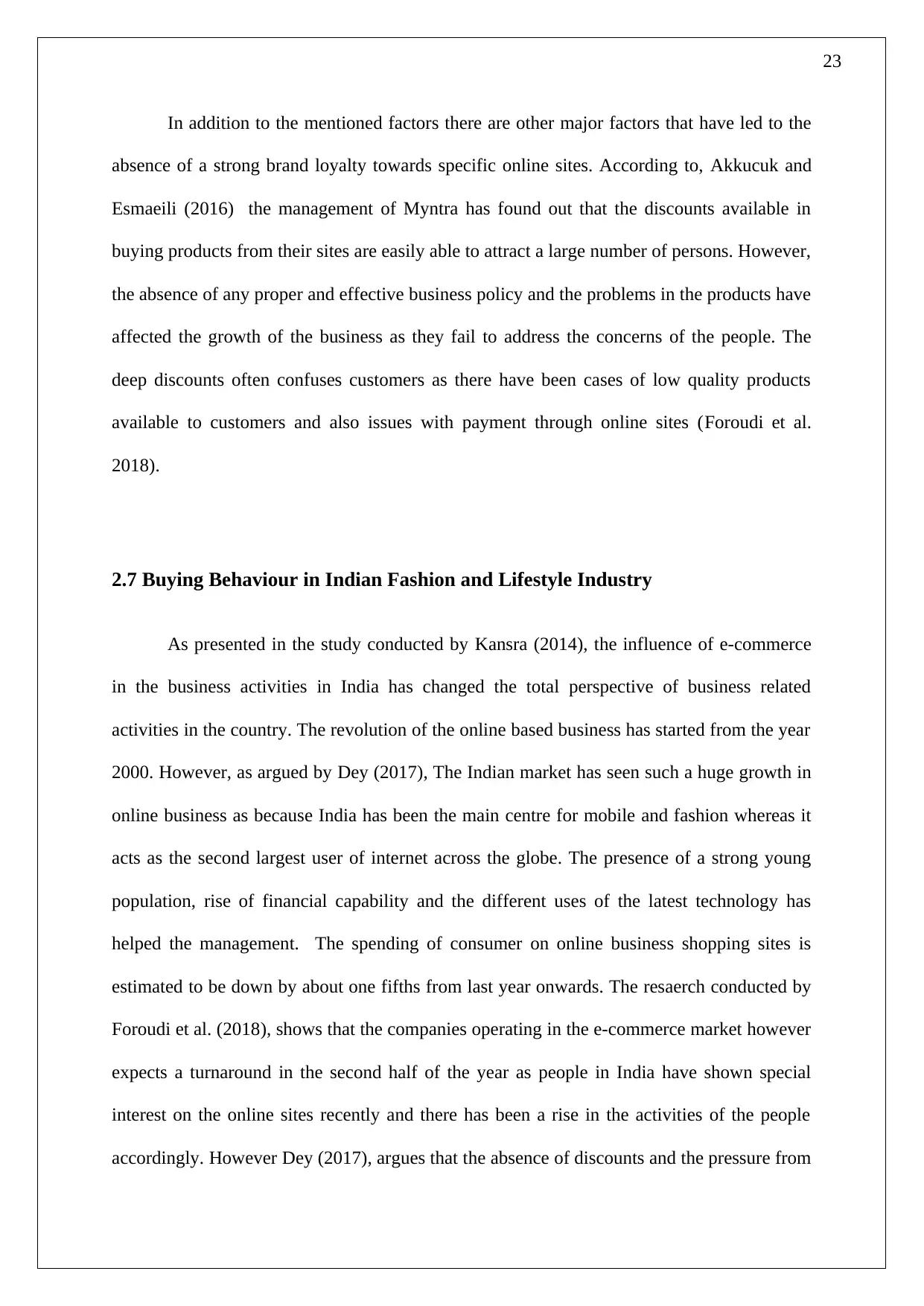
23
In addition to the mentioned factors there are other major factors that have led to the
absence of a strong brand loyalty towards specific online sites. According to, Akkucuk and
Esmaeili (2016) the management of Myntra has found out that the discounts available in
buying products from their sites are easily able to attract a large number of persons. However,
the absence of any proper and effective business policy and the problems in the products have
affected the growth of the business as they fail to address the concerns of the people. The
deep discounts often confuses customers as there have been cases of low quality products
available to customers and also issues with payment through online sites (Foroudi et al.
2018).
2.7 Buying Behaviour in Indian Fashion and Lifestyle Industry
As presented in the study conducted by Kansra (2014), the influence of e-commerce
in the business activities in India has changed the total perspective of business related
activities in the country. The revolution of the online based business has started from the year
2000. However, as argued by Dey (2017), The Indian market has seen such a huge growth in
online business as because India has been the main centre for mobile and fashion whereas it
acts as the second largest user of internet across the globe. The presence of a strong young
population, rise of financial capability and the different uses of the latest technology has
helped the management. The spending of consumer on online business shopping sites is
estimated to be down by about one fifths from last year onwards. The resaerch conducted by
Foroudi et al. (2018), shows that the companies operating in the e-commerce market however
expects a turnaround in the second half of the year as people in India have shown special
interest on the online sites recently and there has been a rise in the activities of the people
accordingly. However Dey (2017), argues that the absence of discounts and the pressure from
In addition to the mentioned factors there are other major factors that have led to the
absence of a strong brand loyalty towards specific online sites. According to, Akkucuk and
Esmaeili (2016) the management of Myntra has found out that the discounts available in
buying products from their sites are easily able to attract a large number of persons. However,
the absence of any proper and effective business policy and the problems in the products have
affected the growth of the business as they fail to address the concerns of the people. The
deep discounts often confuses customers as there have been cases of low quality products
available to customers and also issues with payment through online sites (Foroudi et al.
2018).
2.7 Buying Behaviour in Indian Fashion and Lifestyle Industry
As presented in the study conducted by Kansra (2014), the influence of e-commerce
in the business activities in India has changed the total perspective of business related
activities in the country. The revolution of the online based business has started from the year
2000. However, as argued by Dey (2017), The Indian market has seen such a huge growth in
online business as because India has been the main centre for mobile and fashion whereas it
acts as the second largest user of internet across the globe. The presence of a strong young
population, rise of financial capability and the different uses of the latest technology has
helped the management. The spending of consumer on online business shopping sites is
estimated to be down by about one fifths from last year onwards. The resaerch conducted by
Foroudi et al. (2018), shows that the companies operating in the e-commerce market however
expects a turnaround in the second half of the year as people in India have shown special
interest on the online sites recently and there has been a rise in the activities of the people
accordingly. However Dey (2017), argues that the absence of discounts and the pressure from
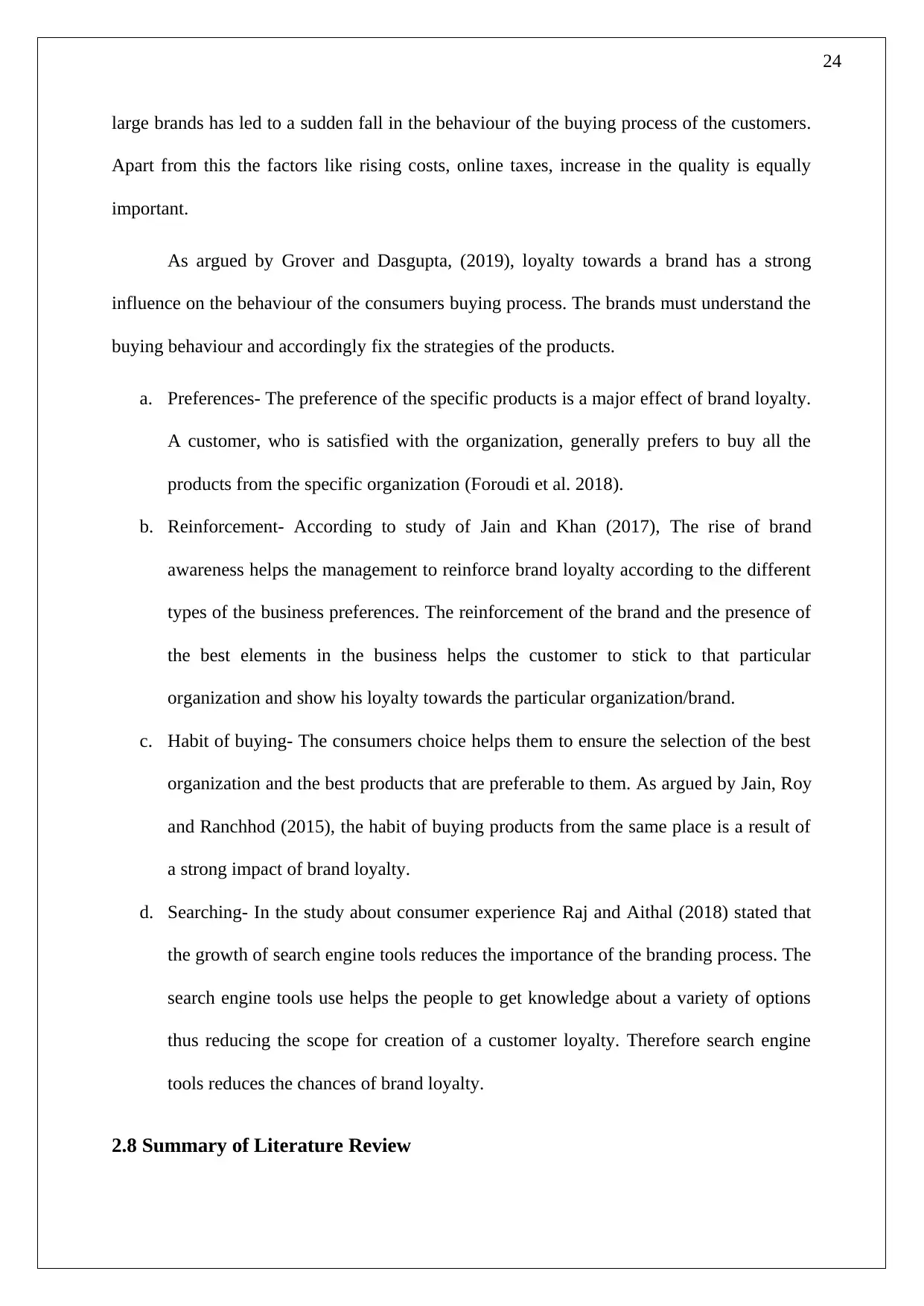
24
large brands has led to a sudden fall in the behaviour of the buying process of the customers.
Apart from this the factors like rising costs, online taxes, increase in the quality is equally
important.
As argued by Grover and Dasgupta, (2019), loyalty towards a brand has a strong
influence on the behaviour of the consumers buying process. The brands must understand the
buying behaviour and accordingly fix the strategies of the products.
a. Preferences- The preference of the specific products is a major effect of brand loyalty.
A customer, who is satisfied with the organization, generally prefers to buy all the
products from the specific organization (Foroudi et al. 2018).
b. Reinforcement- According to study of Jain and Khan (2017), The rise of brand
awareness helps the management to reinforce brand loyalty according to the different
types of the business preferences. The reinforcement of the brand and the presence of
the best elements in the business helps the customer to stick to that particular
organization and show his loyalty towards the particular organization/brand.
c. Habit of buying- The consumers choice helps them to ensure the selection of the best
organization and the best products that are preferable to them. As argued by Jain, Roy
and Ranchhod (2015), the habit of buying products from the same place is a result of
a strong impact of brand loyalty.
d. Searching- In the study about consumer experience Raj and Aithal (2018) stated that
the growth of search engine tools reduces the importance of the branding process. The
search engine tools use helps the people to get knowledge about a variety of options
thus reducing the scope for creation of a customer loyalty. Therefore search engine
tools reduces the chances of brand loyalty.
2.8 Summary of Literature Review
large brands has led to a sudden fall in the behaviour of the buying process of the customers.
Apart from this the factors like rising costs, online taxes, increase in the quality is equally
important.
As argued by Grover and Dasgupta, (2019), loyalty towards a brand has a strong
influence on the behaviour of the consumers buying process. The brands must understand the
buying behaviour and accordingly fix the strategies of the products.
a. Preferences- The preference of the specific products is a major effect of brand loyalty.
A customer, who is satisfied with the organization, generally prefers to buy all the
products from the specific organization (Foroudi et al. 2018).
b. Reinforcement- According to study of Jain and Khan (2017), The rise of brand
awareness helps the management to reinforce brand loyalty according to the different
types of the business preferences. The reinforcement of the brand and the presence of
the best elements in the business helps the customer to stick to that particular
organization and show his loyalty towards the particular organization/brand.
c. Habit of buying- The consumers choice helps them to ensure the selection of the best
organization and the best products that are preferable to them. As argued by Jain, Roy
and Ranchhod (2015), the habit of buying products from the same place is a result of
a strong impact of brand loyalty.
d. Searching- In the study about consumer experience Raj and Aithal (2018) stated that
the growth of search engine tools reduces the importance of the branding process. The
search engine tools use helps the people to get knowledge about a variety of options
thus reducing the scope for creation of a customer loyalty. Therefore search engine
tools reduces the chances of brand loyalty.
2.8 Summary of Literature Review
Paraphrase This Document
Need a fresh take? Get an instant paraphrase of this document with our AI Paraphraser
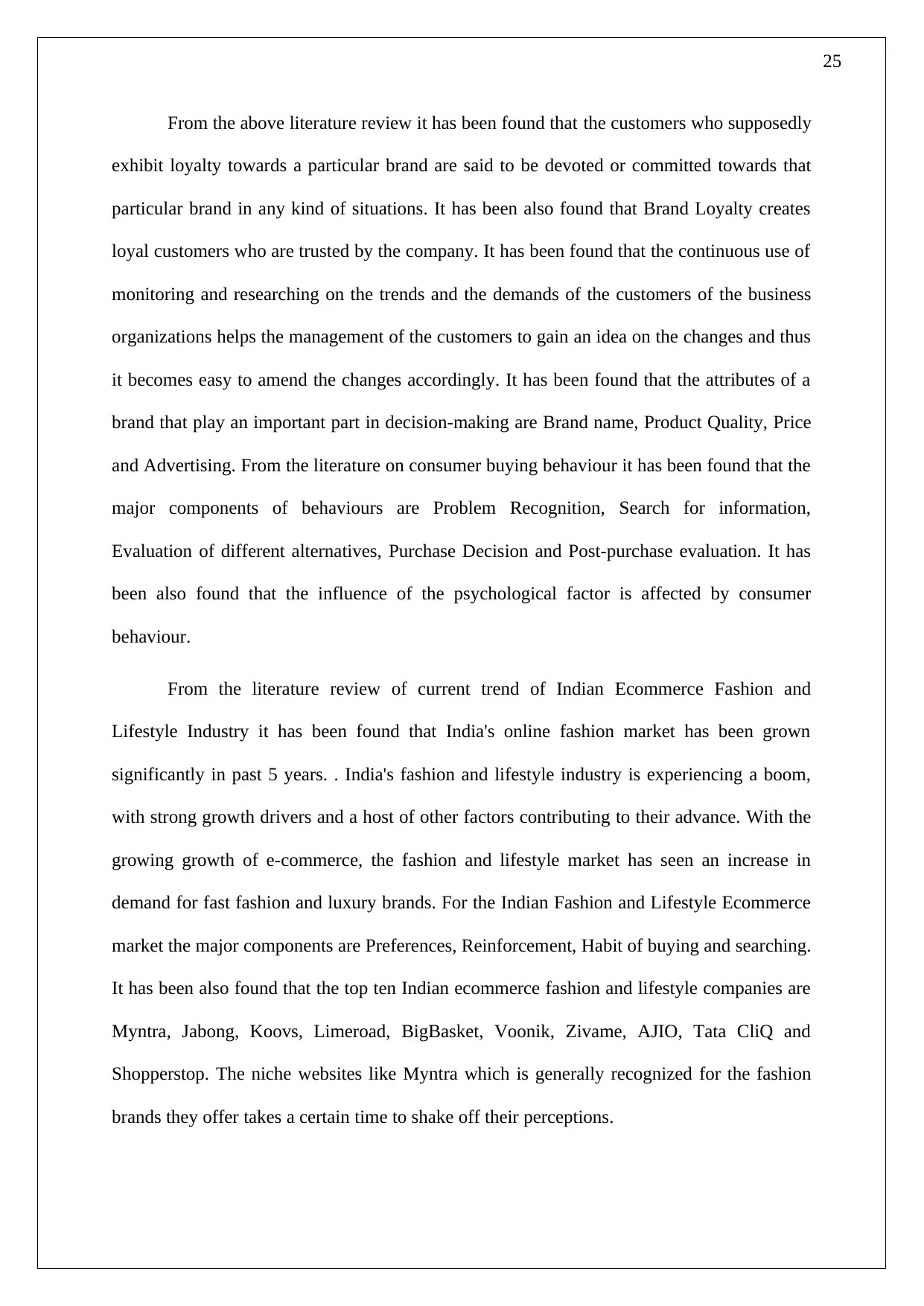
25
From the above literature review it has been found that the customers who supposedly
exhibit loyalty towards a particular brand are said to be devoted or committed towards that
particular brand in any kind of situations. It has been also found that Brand Loyalty creates
loyal customers who are trusted by the company. It has been found that the continuous use of
monitoring and researching on the trends and the demands of the customers of the business
organizations helps the management of the customers to gain an idea on the changes and thus
it becomes easy to amend the changes accordingly. It has been found that the attributes of a
brand that play an important part in decision-making are Brand name, Product Quality, Price
and Advertising. From the literature on consumer buying behaviour it has been found that the
major components of behaviours are Problem Recognition, Search for information,
Evaluation of different alternatives, Purchase Decision and Post-purchase evaluation. It has
been also found that the influence of the psychological factor is affected by consumer
behaviour.
From the literature review of current trend of Indian Ecommerce Fashion and
Lifestyle Industry it has been found that India's online fashion market has been grown
significantly in past 5 years. . India's fashion and lifestyle industry is experiencing a boom,
with strong growth drivers and a host of other factors contributing to their advance. With the
growing growth of e-commerce, the fashion and lifestyle market has seen an increase in
demand for fast fashion and luxury brands. For the Indian Fashion and Lifestyle Ecommerce
market the major components are Preferences, Reinforcement, Habit of buying and searching.
It has been also found that the top ten Indian ecommerce fashion and lifestyle companies are
Myntra, Jabong, Koovs, Limeroad, BigBasket, Voonik, Zivame, AJIO, Tata CliQ and
Shopperstop. The niche websites like Myntra which is generally recognized for the fashion
brands they offer takes a certain time to shake off their perceptions.
From the above literature review it has been found that the customers who supposedly
exhibit loyalty towards a particular brand are said to be devoted or committed towards that
particular brand in any kind of situations. It has been also found that Brand Loyalty creates
loyal customers who are trusted by the company. It has been found that the continuous use of
monitoring and researching on the trends and the demands of the customers of the business
organizations helps the management of the customers to gain an idea on the changes and thus
it becomes easy to amend the changes accordingly. It has been found that the attributes of a
brand that play an important part in decision-making are Brand name, Product Quality, Price
and Advertising. From the literature on consumer buying behaviour it has been found that the
major components of behaviours are Problem Recognition, Search for information,
Evaluation of different alternatives, Purchase Decision and Post-purchase evaluation. It has
been also found that the influence of the psychological factor is affected by consumer
behaviour.
From the literature review of current trend of Indian Ecommerce Fashion and
Lifestyle Industry it has been found that India's online fashion market has been grown
significantly in past 5 years. . India's fashion and lifestyle industry is experiencing a boom,
with strong growth drivers and a host of other factors contributing to their advance. With the
growing growth of e-commerce, the fashion and lifestyle market has seen an increase in
demand for fast fashion and luxury brands. For the Indian Fashion and Lifestyle Ecommerce
market the major components are Preferences, Reinforcement, Habit of buying and searching.
It has been also found that the top ten Indian ecommerce fashion and lifestyle companies are
Myntra, Jabong, Koovs, Limeroad, BigBasket, Voonik, Zivame, AJIO, Tata CliQ and
Shopperstop. The niche websites like Myntra which is generally recognized for the fashion
brands they offer takes a certain time to shake off their perceptions.
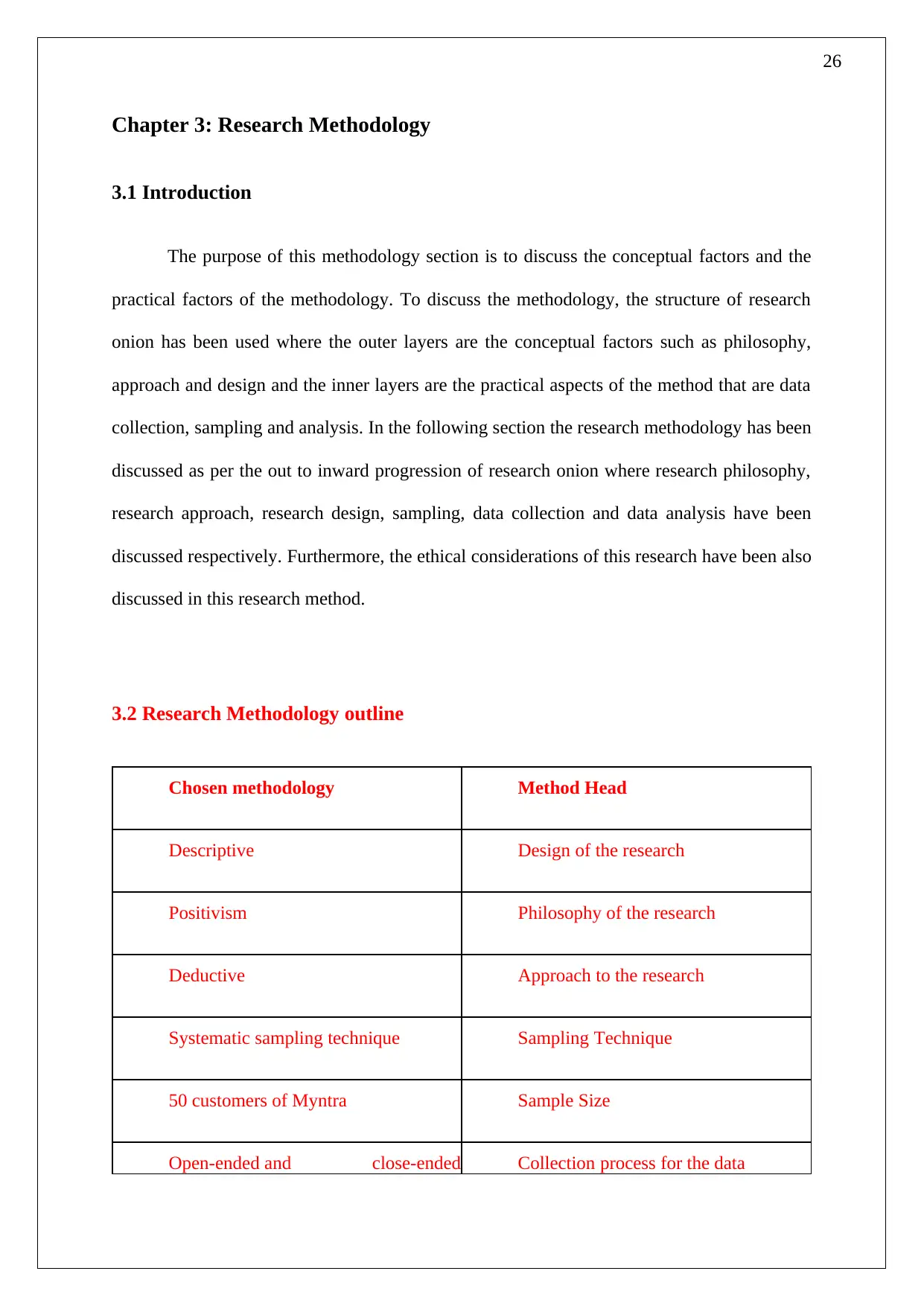
26
Chapter 3: Research Methodology
3.1 Introduction
The purpose of this methodology section is to discuss the conceptual factors and the
practical factors of the methodology. To discuss the methodology, the structure of research
onion has been used where the outer layers are the conceptual factors such as philosophy,
approach and design and the inner layers are the practical aspects of the method that are data
collection, sampling and analysis. In the following section the research methodology has been
discussed as per the out to inward progression of research onion where research philosophy,
research approach, research design, sampling, data collection and data analysis have been
discussed respectively. Furthermore, the ethical considerations of this research have been also
discussed in this research method.
3.2 Research Methodology outline
Method HeadChosen methodology
Design of the researchDescriptive
Philosophy of the researchPositivism
Approach to the researchDeductive
Sampling TechniqueSystematic sampling technique
Sample Size50 customers of Myntra
Collection process for the dataOpen-ended and close-ended
Chapter 3: Research Methodology
3.1 Introduction
The purpose of this methodology section is to discuss the conceptual factors and the
practical factors of the methodology. To discuss the methodology, the structure of research
onion has been used where the outer layers are the conceptual factors such as philosophy,
approach and design and the inner layers are the practical aspects of the method that are data
collection, sampling and analysis. In the following section the research methodology has been
discussed as per the out to inward progression of research onion where research philosophy,
research approach, research design, sampling, data collection and data analysis have been
discussed respectively. Furthermore, the ethical considerations of this research have been also
discussed in this research method.
3.2 Research Methodology outline
Method HeadChosen methodology
Design of the researchDescriptive
Philosophy of the researchPositivism
Approach to the researchDeductive
Sampling TechniqueSystematic sampling technique
Sample Size50 customers of Myntra
Collection process for the dataOpen-ended and close-ended
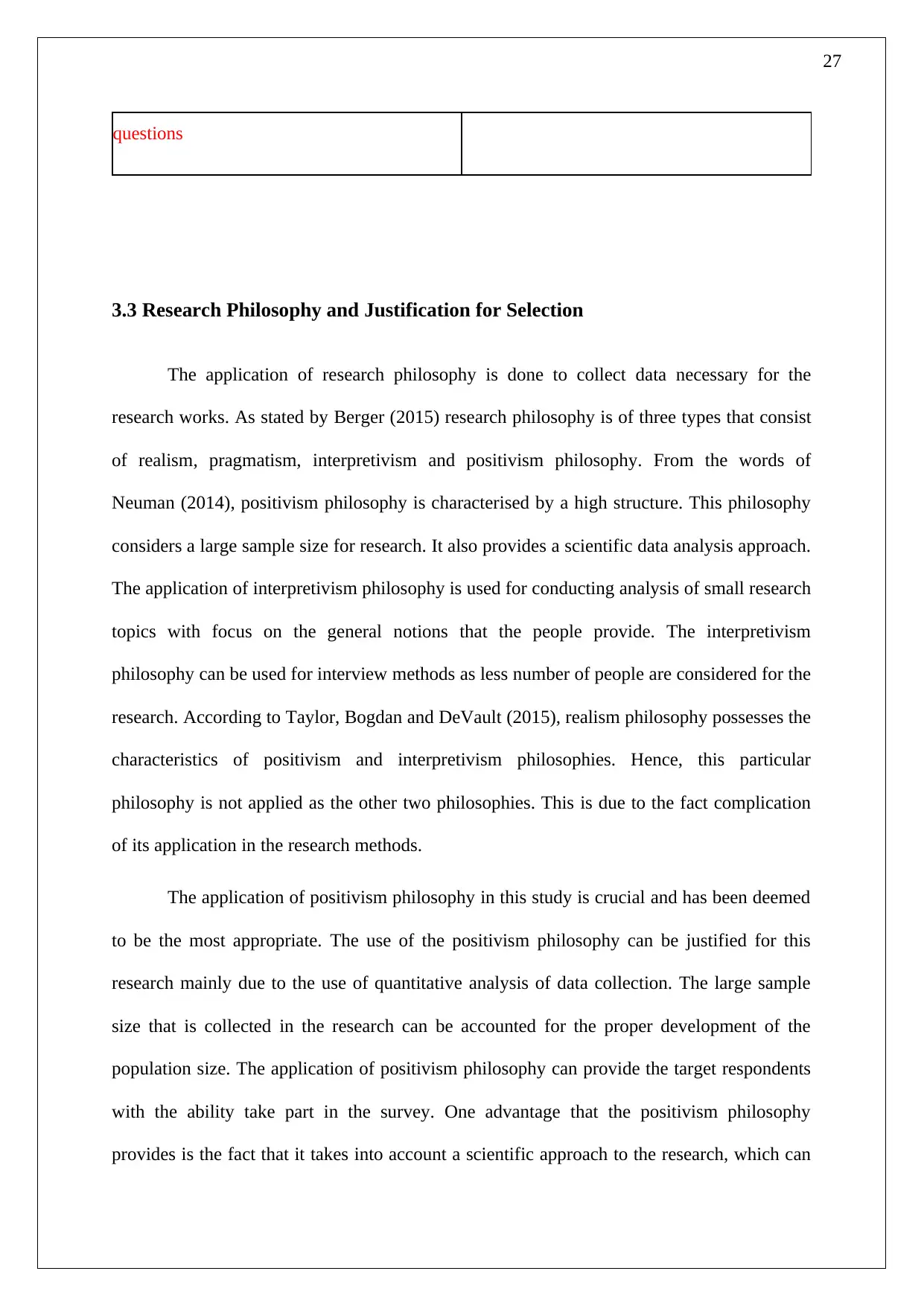
27
questions
3.3 Research Philosophy and Justification for Selection
The application of research philosophy is done to collect data necessary for the
research works. As stated by Berger (2015) research philosophy is of three types that consist
of realism, pragmatism, interpretivism and positivism philosophy. From the words of
Neuman (2014), positivism philosophy is characterised by a high structure. This philosophy
considers a large sample size for research. It also provides a scientific data analysis approach.
The application of interpretivism philosophy is used for conducting analysis of small research
topics with focus on the general notions that the people provide. The interpretivism
philosophy can be used for interview methods as less number of people are considered for the
research. According to Taylor, Bogdan and DeVault (2015), realism philosophy possesses the
characteristics of positivism and interpretivism philosophies. Hence, this particular
philosophy is not applied as the other two philosophies. This is due to the fact complication
of its application in the research methods.
The application of positivism philosophy in this study is crucial and has been deemed
to be the most appropriate. The use of the positivism philosophy can be justified for this
research mainly due to the use of quantitative analysis of data collection. The large sample
size that is collected in the research can be accounted for the proper development of the
population size. The application of positivism philosophy can provide the target respondents
with the ability take part in the survey. One advantage that the positivism philosophy
provides is the fact that it takes into account a scientific approach to the research, which can
questions
3.3 Research Philosophy and Justification for Selection
The application of research philosophy is done to collect data necessary for the
research works. As stated by Berger (2015) research philosophy is of three types that consist
of realism, pragmatism, interpretivism and positivism philosophy. From the words of
Neuman (2014), positivism philosophy is characterised by a high structure. This philosophy
considers a large sample size for research. It also provides a scientific data analysis approach.
The application of interpretivism philosophy is used for conducting analysis of small research
topics with focus on the general notions that the people provide. The interpretivism
philosophy can be used for interview methods as less number of people are considered for the
research. According to Taylor, Bogdan and DeVault (2015), realism philosophy possesses the
characteristics of positivism and interpretivism philosophies. Hence, this particular
philosophy is not applied as the other two philosophies. This is due to the fact complication
of its application in the research methods.
The application of positivism philosophy in this study is crucial and has been deemed
to be the most appropriate. The use of the positivism philosophy can be justified for this
research mainly due to the use of quantitative analysis of data collection. The large sample
size that is collected in the research can be accounted for the proper development of the
population size. The application of positivism philosophy can provide the target respondents
with the ability take part in the survey. One advantage that the positivism philosophy
provides is the fact that it takes into account a scientific approach to the research, which can
Secure Best Marks with AI Grader
Need help grading? Try our AI Grader for instant feedback on your assignments.
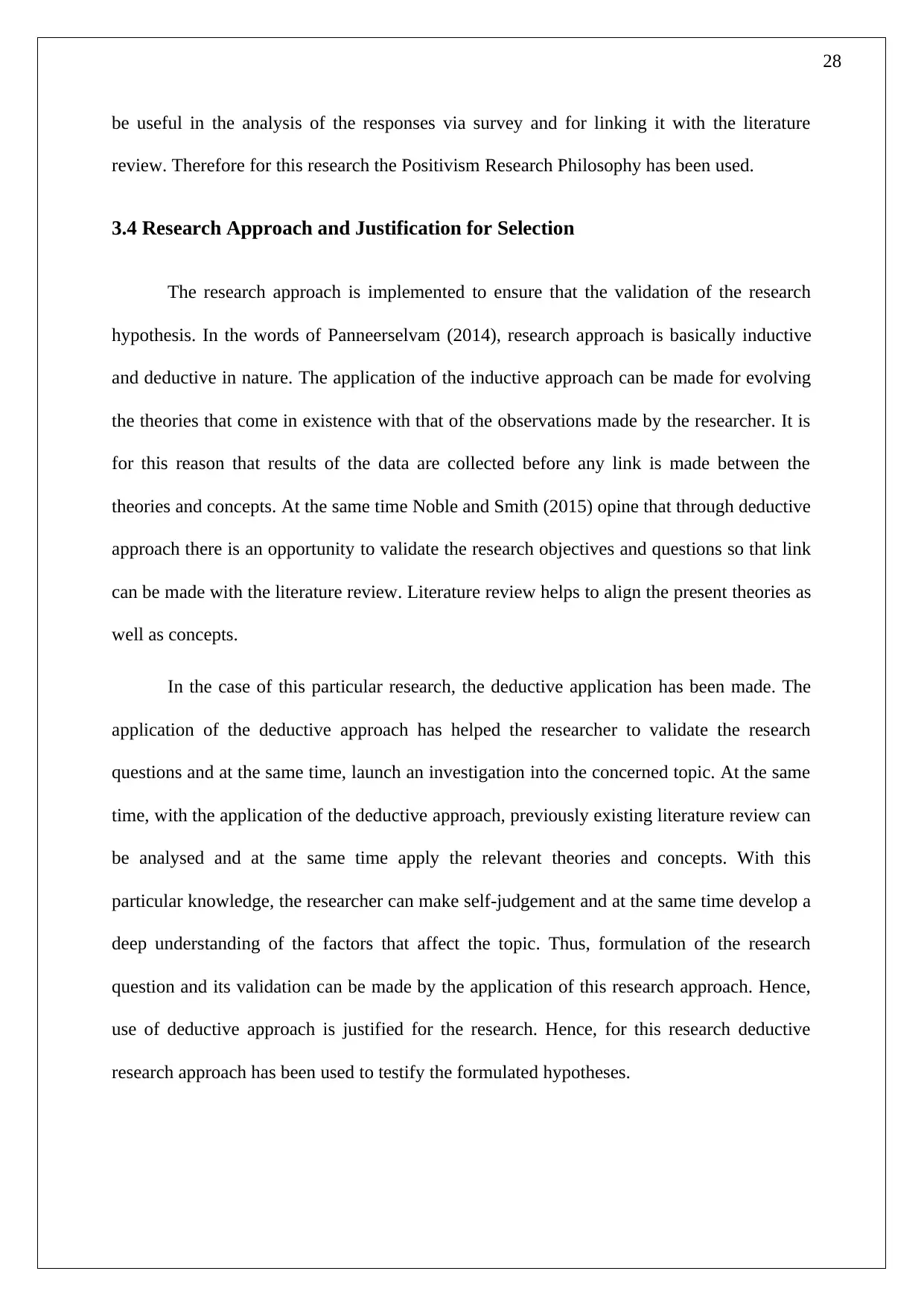
28
be useful in the analysis of the responses via survey and for linking it with the literature
review. Therefore for this research the Positivism Research Philosophy has been used.
3.4 Research Approach and Justification for Selection
The research approach is implemented to ensure that the validation of the research
hypothesis. In the words of Panneerselvam (2014), research approach is basically inductive
and deductive in nature. The application of the inductive approach can be made for evolving
the theories that come in existence with that of the observations made by the researcher. It is
for this reason that results of the data are collected before any link is made between the
theories and concepts. At the same time Noble and Smith (2015) opine that through deductive
approach there is an opportunity to validate the research objectives and questions so that link
can be made with the literature review. Literature review helps to align the present theories as
well as concepts.
In the case of this particular research, the deductive application has been made. The
application of the deductive approach has helped the researcher to validate the research
questions and at the same time, launch an investigation into the concerned topic. At the same
time, with the application of the deductive approach, previously existing literature review can
be analysed and at the same time apply the relevant theories and concepts. With this
particular knowledge, the researcher can make self-judgement and at the same time develop a
deep understanding of the factors that affect the topic. Thus, formulation of the research
question and its validation can be made by the application of this research approach. Hence,
use of deductive approach is justified for the research. Hence, for this research deductive
research approach has been used to testify the formulated hypotheses.
be useful in the analysis of the responses via survey and for linking it with the literature
review. Therefore for this research the Positivism Research Philosophy has been used.
3.4 Research Approach and Justification for Selection
The research approach is implemented to ensure that the validation of the research
hypothesis. In the words of Panneerselvam (2014), research approach is basically inductive
and deductive in nature. The application of the inductive approach can be made for evolving
the theories that come in existence with that of the observations made by the researcher. It is
for this reason that results of the data are collected before any link is made between the
theories and concepts. At the same time Noble and Smith (2015) opine that through deductive
approach there is an opportunity to validate the research objectives and questions so that link
can be made with the literature review. Literature review helps to align the present theories as
well as concepts.
In the case of this particular research, the deductive application has been made. The
application of the deductive approach has helped the researcher to validate the research
questions and at the same time, launch an investigation into the concerned topic. At the same
time, with the application of the deductive approach, previously existing literature review can
be analysed and at the same time apply the relevant theories and concepts. With this
particular knowledge, the researcher can make self-judgement and at the same time develop a
deep understanding of the factors that affect the topic. Thus, formulation of the research
question and its validation can be made by the application of this research approach. Hence,
use of deductive approach is justified for the research. Hence, for this research deductive
research approach has been used to testify the formulated hypotheses.
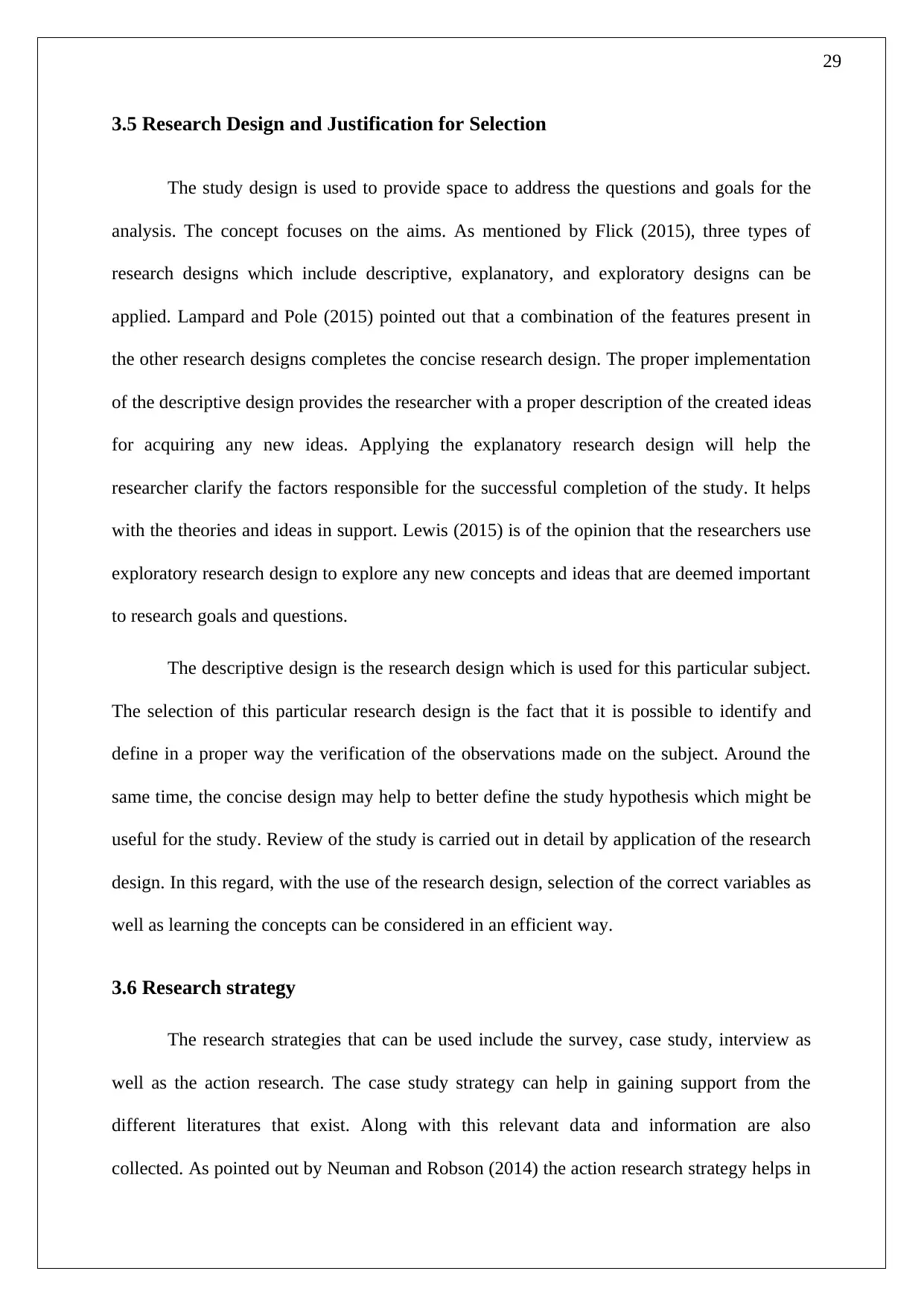
29
3.5 Research Design and Justification for Selection
The study design is used to provide space to address the questions and goals for the
analysis. The concept focuses on the aims. As mentioned by Flick (2015), three types of
research designs which include descriptive, explanatory, and exploratory designs can be
applied. Lampard and Pole (2015) pointed out that a combination of the features present in
the other research designs completes the concise research design. The proper implementation
of the descriptive design provides the researcher with a proper description of the created ideas
for acquiring any new ideas. Applying the explanatory research design will help the
researcher clarify the factors responsible for the successful completion of the study. It helps
with the theories and ideas in support. Lewis (2015) is of the opinion that the researchers use
exploratory research design to explore any new concepts and ideas that are deemed important
to research goals and questions.
The descriptive design is the research design which is used for this particular subject.
The selection of this particular research design is the fact that it is possible to identify and
define in a proper way the verification of the observations made on the subject. Around the
same time, the concise design may help to better define the study hypothesis which might be
useful for the study. Review of the study is carried out in detail by application of the research
design. In this regard, with the use of the research design, selection of the correct variables as
well as learning the concepts can be considered in an efficient way.
3.6 Research strategy
The research strategies that can be used include the survey, case study, interview as
well as the action research. The case study strategy can help in gaining support from the
different literatures that exist. Along with this relevant data and information are also
collected. As pointed out by Neuman and Robson (2014) the action research strategy helps in
3.5 Research Design and Justification for Selection
The study design is used to provide space to address the questions and goals for the
analysis. The concept focuses on the aims. As mentioned by Flick (2015), three types of
research designs which include descriptive, explanatory, and exploratory designs can be
applied. Lampard and Pole (2015) pointed out that a combination of the features present in
the other research designs completes the concise research design. The proper implementation
of the descriptive design provides the researcher with a proper description of the created ideas
for acquiring any new ideas. Applying the explanatory research design will help the
researcher clarify the factors responsible for the successful completion of the study. It helps
with the theories and ideas in support. Lewis (2015) is of the opinion that the researchers use
exploratory research design to explore any new concepts and ideas that are deemed important
to research goals and questions.
The descriptive design is the research design which is used for this particular subject.
The selection of this particular research design is the fact that it is possible to identify and
define in a proper way the verification of the observations made on the subject. Around the
same time, the concise design may help to better define the study hypothesis which might be
useful for the study. Review of the study is carried out in detail by application of the research
design. In this regard, with the use of the research design, selection of the correct variables as
well as learning the concepts can be considered in an efficient way.
3.6 Research strategy
The research strategies that can be used include the survey, case study, interview as
well as the action research. The case study strategy can help in gaining support from the
different literatures that exist. Along with this relevant data and information are also
collected. As pointed out by Neuman and Robson (2014) the action research strategy helps in
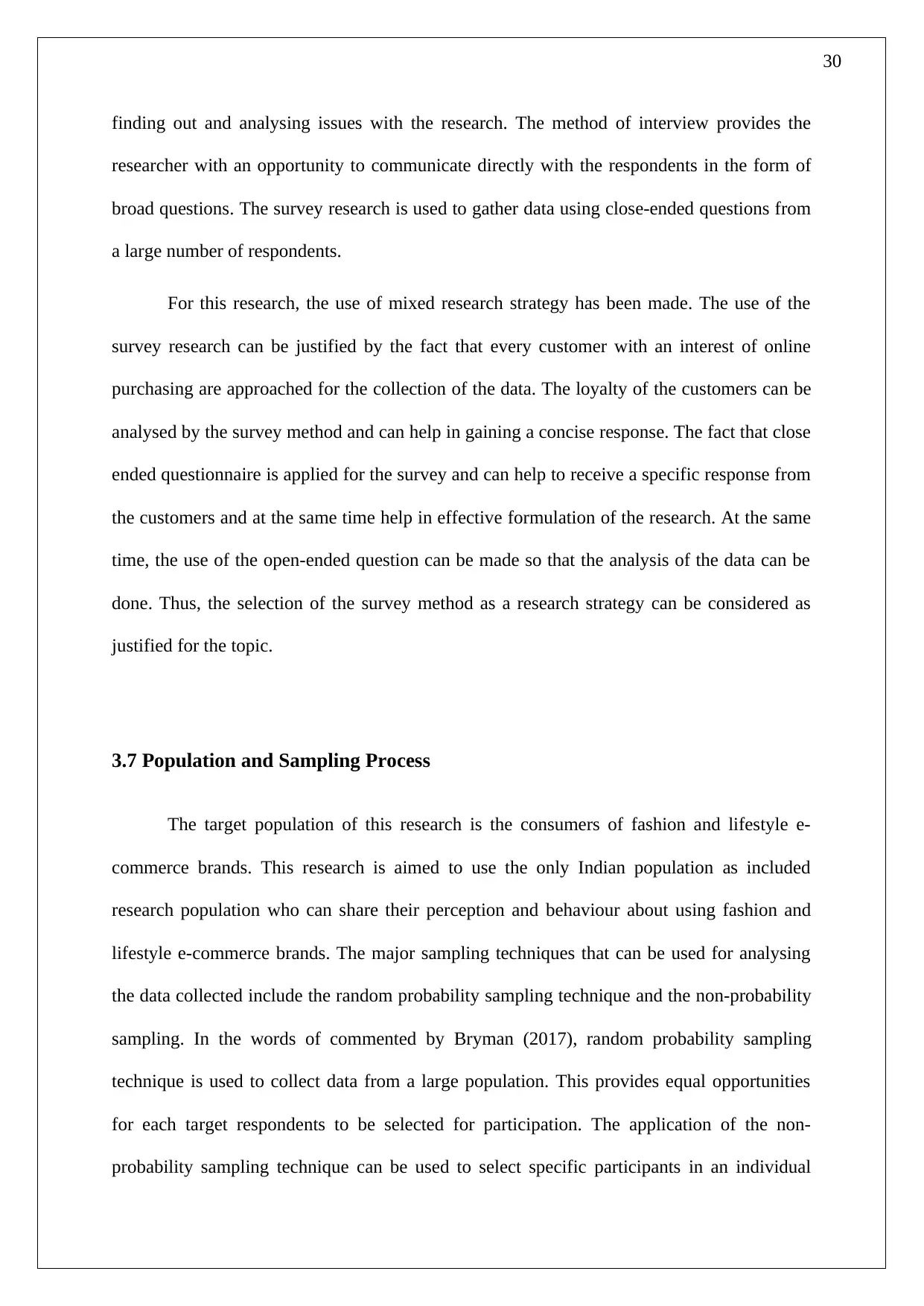
30
finding out and analysing issues with the research. The method of interview provides the
researcher with an opportunity to communicate directly with the respondents in the form of
broad questions. The survey research is used to gather data using close-ended questions from
a large number of respondents.
For this research, the use of mixed research strategy has been made. The use of the
survey research can be justified by the fact that every customer with an interest of online
purchasing are approached for the collection of the data. The loyalty of the customers can be
analysed by the survey method and can help in gaining a concise response. The fact that close
ended questionnaire is applied for the survey and can help to receive a specific response from
the customers and at the same time help in effective formulation of the research. At the same
time, the use of the open-ended question can be made so that the analysis of the data can be
done. Thus, the selection of the survey method as a research strategy can be considered as
justified for the topic.
3.7 Population and Sampling Process
The target population of this research is the consumers of fashion and lifestyle e-
commerce brands. This research is aimed to use the only Indian population as included
research population who can share their perception and behaviour about using fashion and
lifestyle e-commerce brands. The major sampling techniques that can be used for analysing
the data collected include the random probability sampling technique and the non-probability
sampling. In the words of commented by Bryman (2017), random probability sampling
technique is used to collect data from a large population. This provides equal opportunities
for each target respondents to be selected for participation. The application of the non-
probability sampling technique can be used to select specific participants in an individual
finding out and analysing issues with the research. The method of interview provides the
researcher with an opportunity to communicate directly with the respondents in the form of
broad questions. The survey research is used to gather data using close-ended questions from
a large number of respondents.
For this research, the use of mixed research strategy has been made. The use of the
survey research can be justified by the fact that every customer with an interest of online
purchasing are approached for the collection of the data. The loyalty of the customers can be
analysed by the survey method and can help in gaining a concise response. The fact that close
ended questionnaire is applied for the survey and can help to receive a specific response from
the customers and at the same time help in effective formulation of the research. At the same
time, the use of the open-ended question can be made so that the analysis of the data can be
done. Thus, the selection of the survey method as a research strategy can be considered as
justified for the topic.
3.7 Population and Sampling Process
The target population of this research is the consumers of fashion and lifestyle e-
commerce brands. This research is aimed to use the only Indian population as included
research population who can share their perception and behaviour about using fashion and
lifestyle e-commerce brands. The major sampling techniques that can be used for analysing
the data collected include the random probability sampling technique and the non-probability
sampling. In the words of commented by Bryman (2017), random probability sampling
technique is used to collect data from a large population. This provides equal opportunities
for each target respondents to be selected for participation. The application of the non-
probability sampling technique can be used to select specific participants in an individual
Paraphrase This Document
Need a fresh take? Get an instant paraphrase of this document with our AI Paraphraser
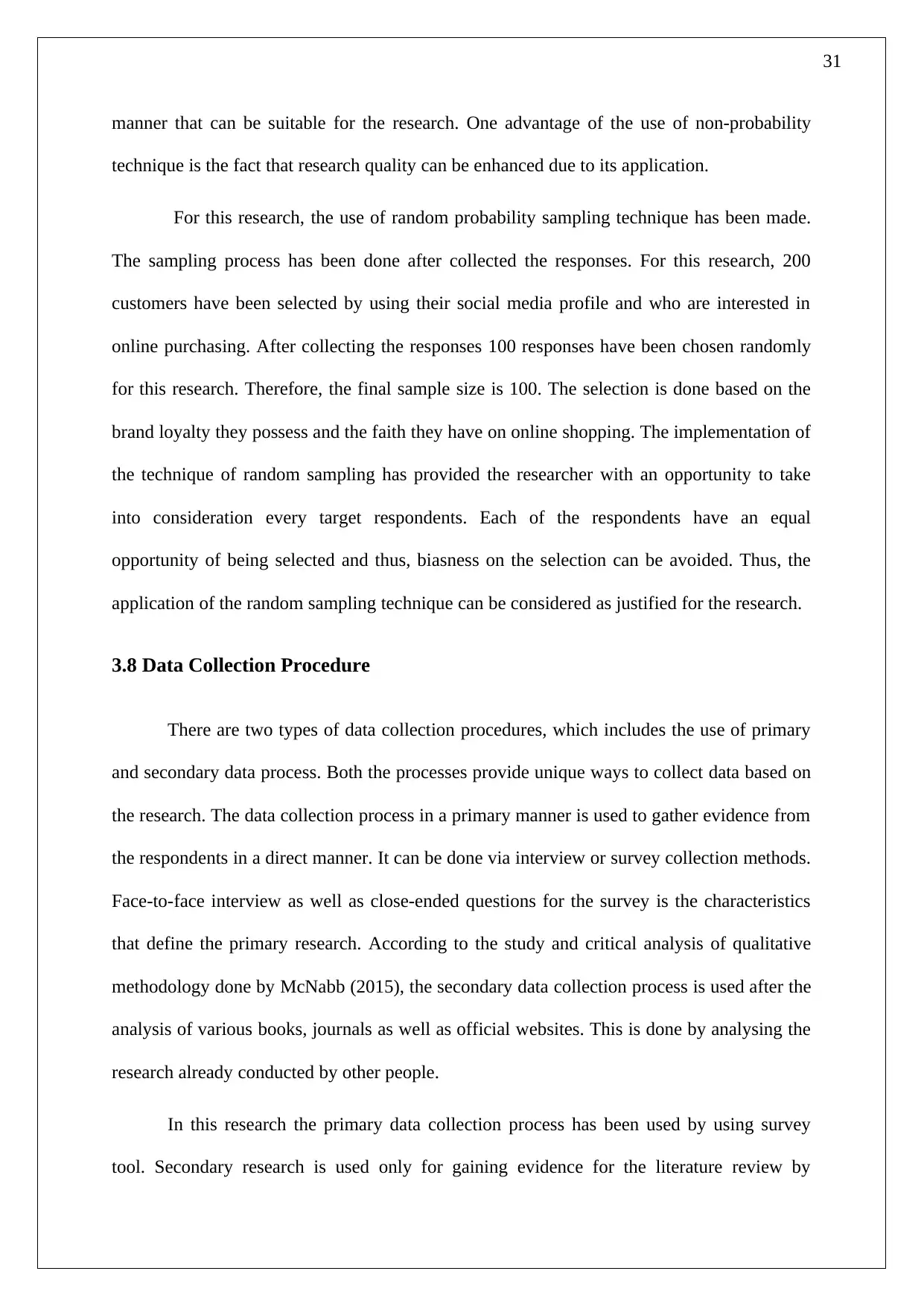
31
manner that can be suitable for the research. One advantage of the use of non-probability
technique is the fact that research quality can be enhanced due to its application.
For this research, the use of random probability sampling technique has been made.
The sampling process has been done after collected the responses. For this research, 200
customers have been selected by using their social media profile and who are interested in
online purchasing. After collecting the responses 100 responses have been chosen randomly
for this research. Therefore, the final sample size is 100. The selection is done based on the
brand loyalty they possess and the faith they have on online shopping. The implementation of
the technique of random sampling has provided the researcher with an opportunity to take
into consideration every target respondents. Each of the respondents have an equal
opportunity of being selected and thus, biasness on the selection can be avoided. Thus, the
application of the random sampling technique can be considered as justified for the research.
3.8 Data Collection Procedure
There are two types of data collection procedures, which includes the use of primary
and secondary data process. Both the processes provide unique ways to collect data based on
the research. The data collection process in a primary manner is used to gather evidence from
the respondents in a direct manner. It can be done via interview or survey collection methods.
Face-to-face interview as well as close-ended questions for the survey is the characteristics
that define the primary research. According to the study and critical analysis of qualitative
methodology done by McNabb (2015), the secondary data collection process is used after the
analysis of various books, journals as well as official websites. This is done by analysing the
research already conducted by other people.
In this research the primary data collection process has been used by using survey
tool. Secondary research is used only for gaining evidence for the literature review by
manner that can be suitable for the research. One advantage of the use of non-probability
technique is the fact that research quality can be enhanced due to its application.
For this research, the use of random probability sampling technique has been made.
The sampling process has been done after collected the responses. For this research, 200
customers have been selected by using their social media profile and who are interested in
online purchasing. After collecting the responses 100 responses have been chosen randomly
for this research. Therefore, the final sample size is 100. The selection is done based on the
brand loyalty they possess and the faith they have on online shopping. The implementation of
the technique of random sampling has provided the researcher with an opportunity to take
into consideration every target respondents. Each of the respondents have an equal
opportunity of being selected and thus, biasness on the selection can be avoided. Thus, the
application of the random sampling technique can be considered as justified for the research.
3.8 Data Collection Procedure
There are two types of data collection procedures, which includes the use of primary
and secondary data process. Both the processes provide unique ways to collect data based on
the research. The data collection process in a primary manner is used to gather evidence from
the respondents in a direct manner. It can be done via interview or survey collection methods.
Face-to-face interview as well as close-ended questions for the survey is the characteristics
that define the primary research. According to the study and critical analysis of qualitative
methodology done by McNabb (2015), the secondary data collection process is used after the
analysis of various books, journals as well as official websites. This is done by analysing the
research already conducted by other people.
In this research the primary data collection process has been used by using survey
tool. Secondary research is used only for gaining evidence for the literature review by

32
considering the works of various scholars. The application of the primary data collection can
be considered as feasible since it helps in gaining direct insight into the perspective of the
customers. Direct communication can help in understanding the changes required for
maintaining loyalty. In questionnaire both demographical questions are incorporated along
with the dependent and independent factors. The data regarding dependent variable
“Consumer behaviour” has been collected through four behavioural factor questions such as
frequency of purchase, choosing over other brand and others. The data regarding independent
variable “Consumer loyalty” has collected through four loyalty based questions such as
importance of promotional message, referral and others.
3.9 Data Analysis Procedure
The qualitative and quantitative technique of analysis is used in the research. During
the qualitative data analysis, quality data technique can be analysed. The data is analysed by
using the transcript. At the same time Taylor, Bogdan and DeVault (2015) is of the opinion
that the quantitative data analysis technique can be used for enhancing the quantity of the
data. The data collected from the survey responses are mostly ordinal and scale based and
therefore, quantitative analysis is most suitable for the collected data. For demographic
variables such as age group, income, gender other descriptive statistics has been used. For
nominal variable percentage distribution and for ordinal variable mean, standard deviation
analysis has been used. For this analysis inferential quantitative data analysis technique that
has been taken into account for this research. As per the data collection process the loyalty of
the consumers has been collected by four factors and the behaviour of the consumer has be
collected by another four factors.
considering the works of various scholars. The application of the primary data collection can
be considered as feasible since it helps in gaining direct insight into the perspective of the
customers. Direct communication can help in understanding the changes required for
maintaining loyalty. In questionnaire both demographical questions are incorporated along
with the dependent and independent factors. The data regarding dependent variable
“Consumer behaviour” has been collected through four behavioural factor questions such as
frequency of purchase, choosing over other brand and others. The data regarding independent
variable “Consumer loyalty” has collected through four loyalty based questions such as
importance of promotional message, referral and others.
3.9 Data Analysis Procedure
The qualitative and quantitative technique of analysis is used in the research. During
the qualitative data analysis, quality data technique can be analysed. The data is analysed by
using the transcript. At the same time Taylor, Bogdan and DeVault (2015) is of the opinion
that the quantitative data analysis technique can be used for enhancing the quantity of the
data. The data collected from the survey responses are mostly ordinal and scale based and
therefore, quantitative analysis is most suitable for the collected data. For demographic
variables such as age group, income, gender other descriptive statistics has been used. For
nominal variable percentage distribution and for ordinal variable mean, standard deviation
analysis has been used. For this analysis inferential quantitative data analysis technique that
has been taken into account for this research. As per the data collection process the loyalty of
the consumers has been collected by four factors and the behaviour of the consumer has be
collected by another four factors.
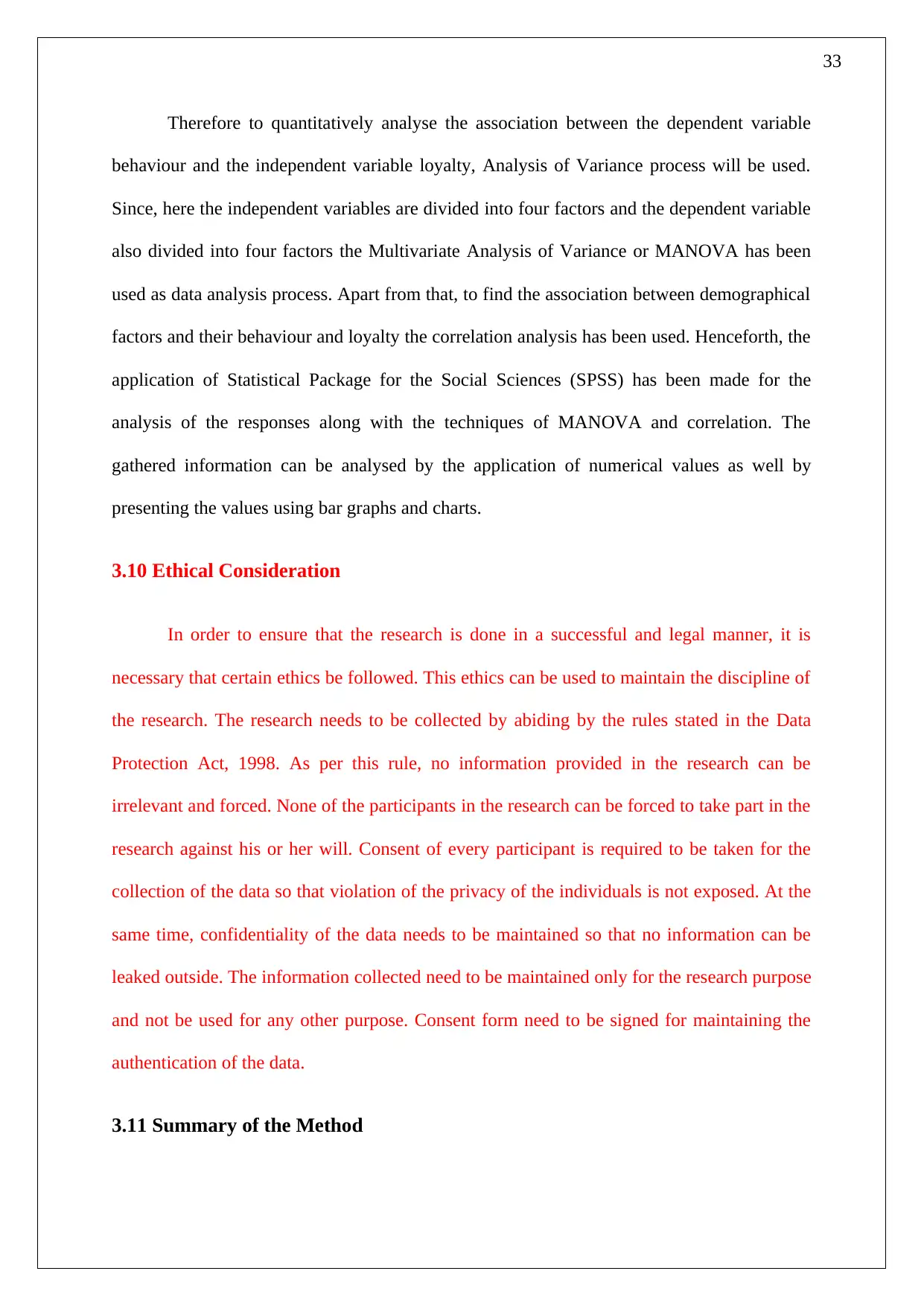
33
Therefore to quantitatively analyse the association between the dependent variable
behaviour and the independent variable loyalty, Analysis of Variance process will be used.
Since, here the independent variables are divided into four factors and the dependent variable
also divided into four factors the Multivariate Analysis of Variance or MANOVA has been
used as data analysis process. Apart from that, to find the association between demographical
factors and their behaviour and loyalty the correlation analysis has been used. Henceforth, the
application of Statistical Package for the Social Sciences (SPSS) has been made for the
analysis of the responses along with the techniques of MANOVA and correlation. The
gathered information can be analysed by the application of numerical values as well by
presenting the values using bar graphs and charts.
3.10 Ethical Consideration
In order to ensure that the research is done in a successful and legal manner, it is
necessary that certain ethics be followed. This ethics can be used to maintain the discipline of
the research. The research needs to be collected by abiding by the rules stated in the Data
Protection Act, 1998. As per this rule, no information provided in the research can be
irrelevant and forced. None of the participants in the research can be forced to take part in the
research against his or her will. Consent of every participant is required to be taken for the
collection of the data so that violation of the privacy of the individuals is not exposed. At the
same time, confidentiality of the data needs to be maintained so that no information can be
leaked outside. The information collected need to be maintained only for the research purpose
and not be used for any other purpose. Consent form need to be signed for maintaining the
authentication of the data.
3.11 Summary of the Method
Therefore to quantitatively analyse the association between the dependent variable
behaviour and the independent variable loyalty, Analysis of Variance process will be used.
Since, here the independent variables are divided into four factors and the dependent variable
also divided into four factors the Multivariate Analysis of Variance or MANOVA has been
used as data analysis process. Apart from that, to find the association between demographical
factors and their behaviour and loyalty the correlation analysis has been used. Henceforth, the
application of Statistical Package for the Social Sciences (SPSS) has been made for the
analysis of the responses along with the techniques of MANOVA and correlation. The
gathered information can be analysed by the application of numerical values as well by
presenting the values using bar graphs and charts.
3.10 Ethical Consideration
In order to ensure that the research is done in a successful and legal manner, it is
necessary that certain ethics be followed. This ethics can be used to maintain the discipline of
the research. The research needs to be collected by abiding by the rules stated in the Data
Protection Act, 1998. As per this rule, no information provided in the research can be
irrelevant and forced. None of the participants in the research can be forced to take part in the
research against his or her will. Consent of every participant is required to be taken for the
collection of the data so that violation of the privacy of the individuals is not exposed. At the
same time, confidentiality of the data needs to be maintained so that no information can be
leaked outside. The information collected need to be maintained only for the research purpose
and not be used for any other purpose. Consent form need to be signed for maintaining the
authentication of the data.
3.11 Summary of the Method
Secure Best Marks with AI Grader
Need help grading? Try our AI Grader for instant feedback on your assignments.
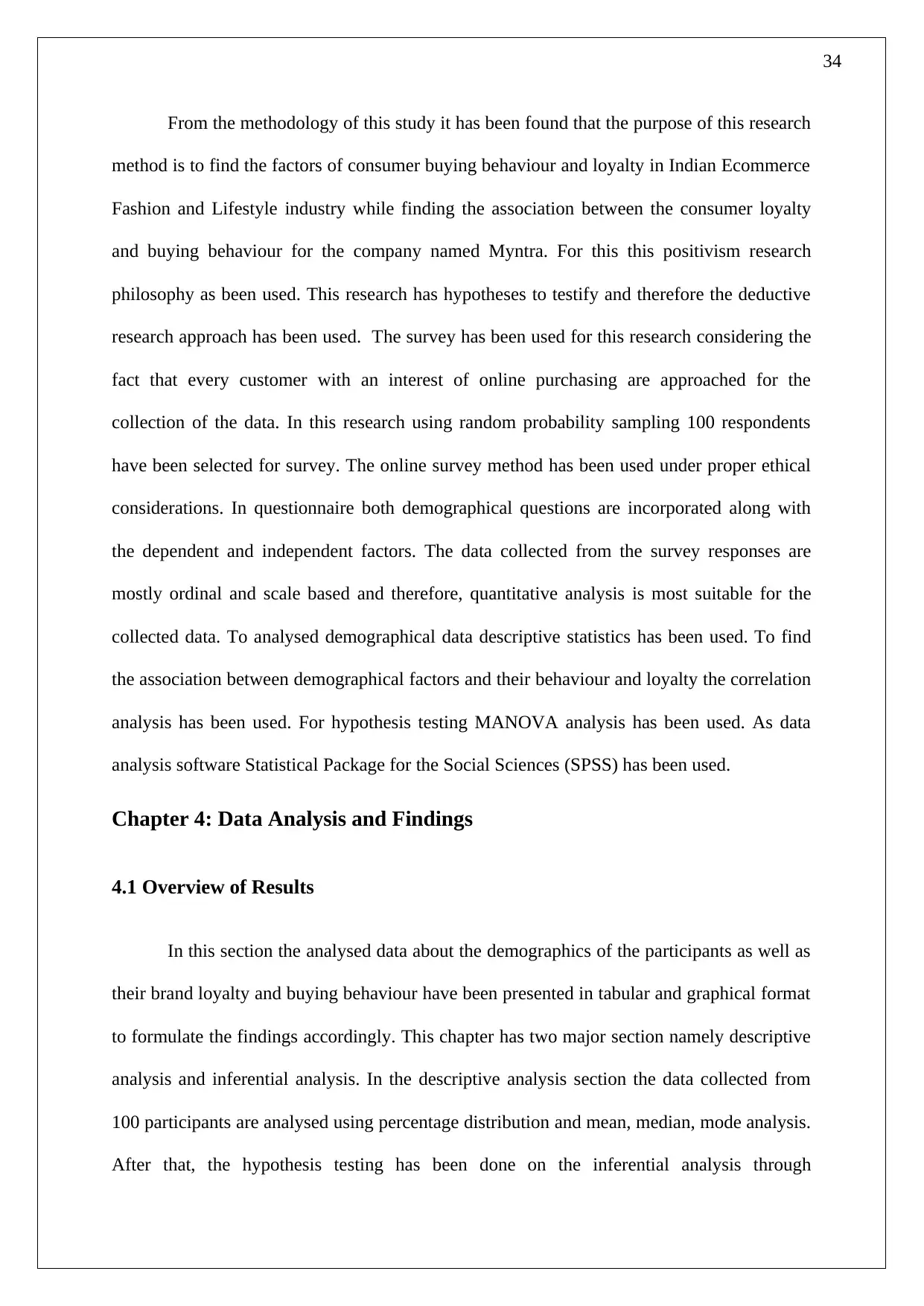
34
From the methodology of this study it has been found that the purpose of this research
method is to find the factors of consumer buying behaviour and loyalty in Indian Ecommerce
Fashion and Lifestyle industry while finding the association between the consumer loyalty
and buying behaviour for the company named Myntra. For this this positivism research
philosophy as been used. This research has hypotheses to testify and therefore the deductive
research approach has been used. The survey has been used for this research considering the
fact that every customer with an interest of online purchasing are approached for the
collection of the data. In this research using random probability sampling 100 respondents
have been selected for survey. The online survey method has been used under proper ethical
considerations. In questionnaire both demographical questions are incorporated along with
the dependent and independent factors. The data collected from the survey responses are
mostly ordinal and scale based and therefore, quantitative analysis is most suitable for the
collected data. To analysed demographical data descriptive statistics has been used. To find
the association between demographical factors and their behaviour and loyalty the correlation
analysis has been used. For hypothesis testing MANOVA analysis has been used. As data
analysis software Statistical Package for the Social Sciences (SPSS) has been used.
Chapter 4: Data Analysis and Findings
4.1 Overview of Results
In this section the analysed data about the demographics of the participants as well as
their brand loyalty and buying behaviour have been presented in tabular and graphical format
to formulate the findings accordingly. This chapter has two major section namely descriptive
analysis and inferential analysis. In the descriptive analysis section the data collected from
100 participants are analysed using percentage distribution and mean, median, mode analysis.
After that, the hypothesis testing has been done on the inferential analysis through
From the methodology of this study it has been found that the purpose of this research
method is to find the factors of consumer buying behaviour and loyalty in Indian Ecommerce
Fashion and Lifestyle industry while finding the association between the consumer loyalty
and buying behaviour for the company named Myntra. For this this positivism research
philosophy as been used. This research has hypotheses to testify and therefore the deductive
research approach has been used. The survey has been used for this research considering the
fact that every customer with an interest of online purchasing are approached for the
collection of the data. In this research using random probability sampling 100 respondents
have been selected for survey. The online survey method has been used under proper ethical
considerations. In questionnaire both demographical questions are incorporated along with
the dependent and independent factors. The data collected from the survey responses are
mostly ordinal and scale based and therefore, quantitative analysis is most suitable for the
collected data. To analysed demographical data descriptive statistics has been used. To find
the association between demographical factors and their behaviour and loyalty the correlation
analysis has been used. For hypothesis testing MANOVA analysis has been used. As data
analysis software Statistical Package for the Social Sciences (SPSS) has been used.
Chapter 4: Data Analysis and Findings
4.1 Overview of Results
In this section the analysed data about the demographics of the participants as well as
their brand loyalty and buying behaviour have been presented in tabular and graphical format
to formulate the findings accordingly. This chapter has two major section namely descriptive
analysis and inferential analysis. In the descriptive analysis section the data collected from
100 participants are analysed using percentage distribution and mean, median, mode analysis.
After that, the hypothesis testing has been done on the inferential analysis through
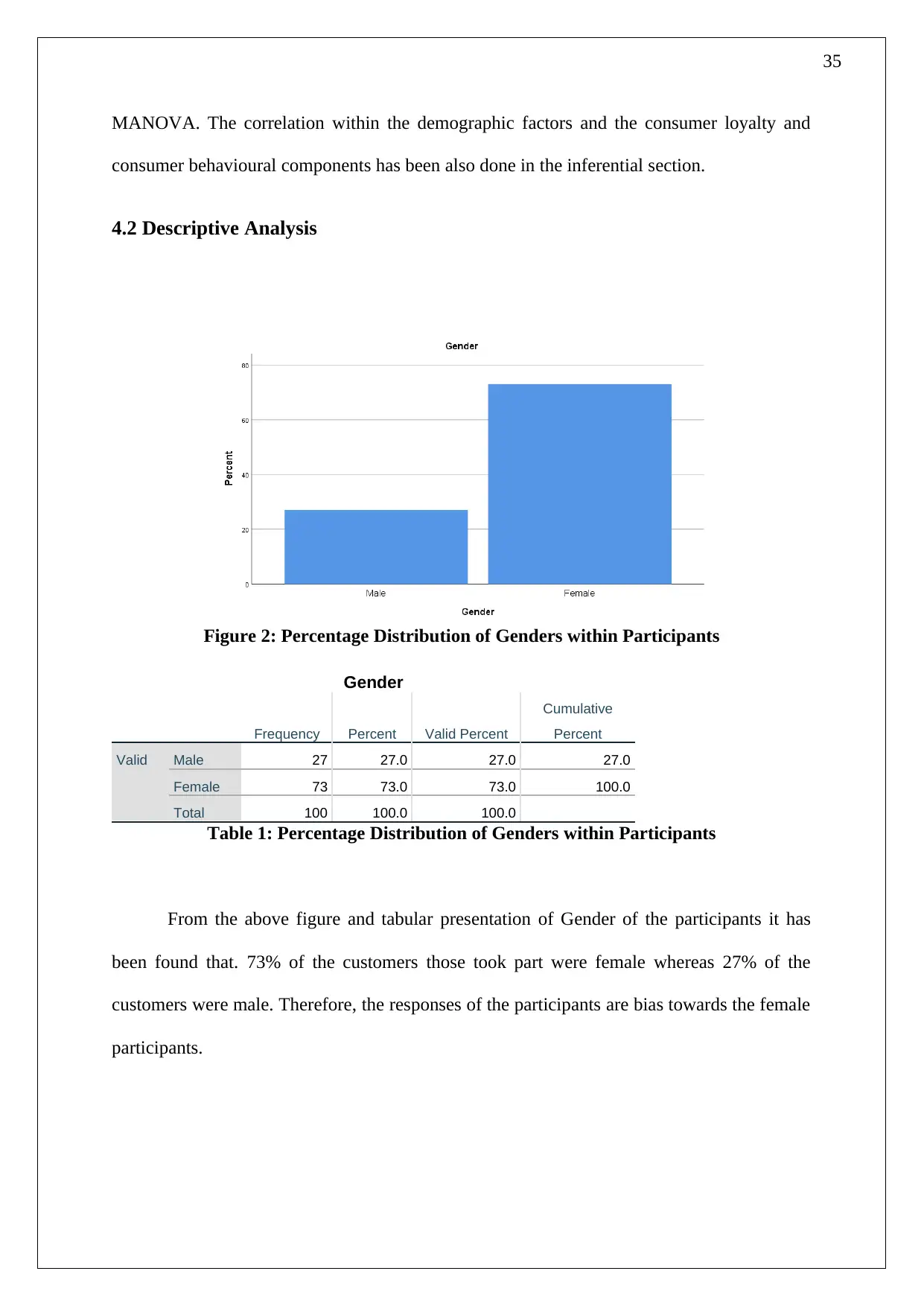
35
MANOVA. The correlation within the demographic factors and the consumer loyalty and
consumer behavioural components has been also done in the inferential section.
4.2 Descriptive Analysis
Figure 2: Percentage Distribution of Genders within Participants
Gender
Frequency Percent Valid Percent
Cumulative
Percent
Valid Male 27 27.0 27.0 27.0
Female 73 73.0 73.0 100.0
Total 100 100.0 100.0
Table 1: Percentage Distribution of Genders within Participants
From the above figure and tabular presentation of Gender of the participants it has
been found that. 73% of the customers those took part were female whereas 27% of the
customers were male. Therefore, the responses of the participants are bias towards the female
participants.
MANOVA. The correlation within the demographic factors and the consumer loyalty and
consumer behavioural components has been also done in the inferential section.
4.2 Descriptive Analysis
Figure 2: Percentage Distribution of Genders within Participants
Gender
Frequency Percent Valid Percent
Cumulative
Percent
Valid Male 27 27.0 27.0 27.0
Female 73 73.0 73.0 100.0
Total 100 100.0 100.0
Table 1: Percentage Distribution of Genders within Participants
From the above figure and tabular presentation of Gender of the participants it has
been found that. 73% of the customers those took part were female whereas 27% of the
customers were male. Therefore, the responses of the participants are bias towards the female
participants.
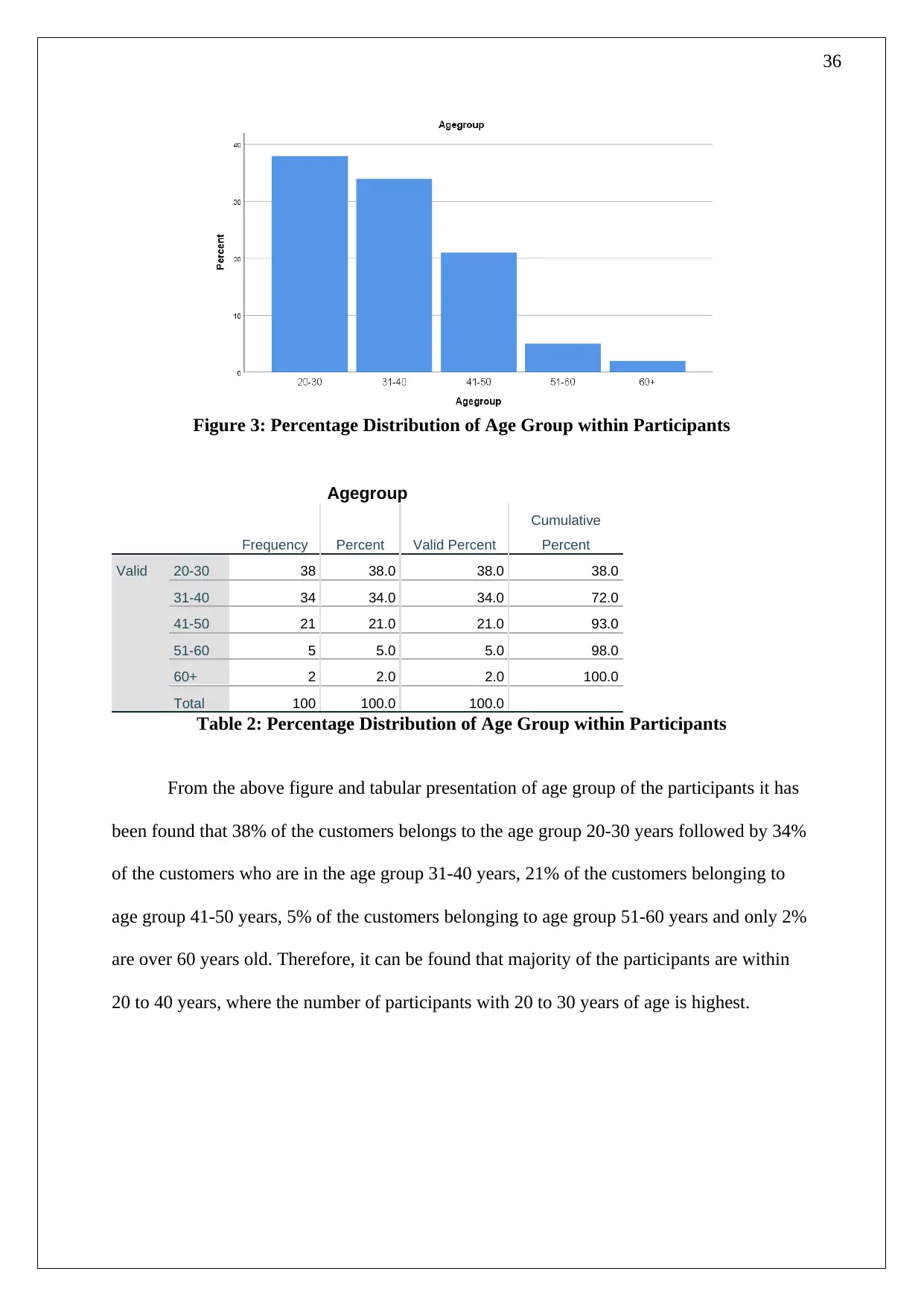
36
Figure 3: Percentage Distribution of Age Group within Participants
Agegroup
Frequency Percent Valid Percent
Cumulative
Percent
Valid 20-30 38 38.0 38.0 38.0
31-40 34 34.0 34.0 72.0
41-50 21 21.0 21.0 93.0
51-60 5 5.0 5.0 98.0
60+ 2 2.0 2.0 100.0
Total 100 100.0 100.0
Table 2: Percentage Distribution of Age Group within Participants
From the above figure and tabular presentation of age group of the participants it has
been found that 38% of the customers belongs to the age group 20-30 years followed by 34%
of the customers who are in the age group 31-40 years, 21% of the customers belonging to
age group 41-50 years, 5% of the customers belonging to age group 51-60 years and only 2%
are over 60 years old. Therefore, it can be found that majority of the participants are within
20 to 40 years, where the number of participants with 20 to 30 years of age is highest.
Figure 3: Percentage Distribution of Age Group within Participants
Agegroup
Frequency Percent Valid Percent
Cumulative
Percent
Valid 20-30 38 38.0 38.0 38.0
31-40 34 34.0 34.0 72.0
41-50 21 21.0 21.0 93.0
51-60 5 5.0 5.0 98.0
60+ 2 2.0 2.0 100.0
Total 100 100.0 100.0
Table 2: Percentage Distribution of Age Group within Participants
From the above figure and tabular presentation of age group of the participants it has
been found that 38% of the customers belongs to the age group 20-30 years followed by 34%
of the customers who are in the age group 31-40 years, 21% of the customers belonging to
age group 41-50 years, 5% of the customers belonging to age group 51-60 years and only 2%
are over 60 years old. Therefore, it can be found that majority of the participants are within
20 to 40 years, where the number of participants with 20 to 30 years of age is highest.
Paraphrase This Document
Need a fresh take? Get an instant paraphrase of this document with our AI Paraphraser
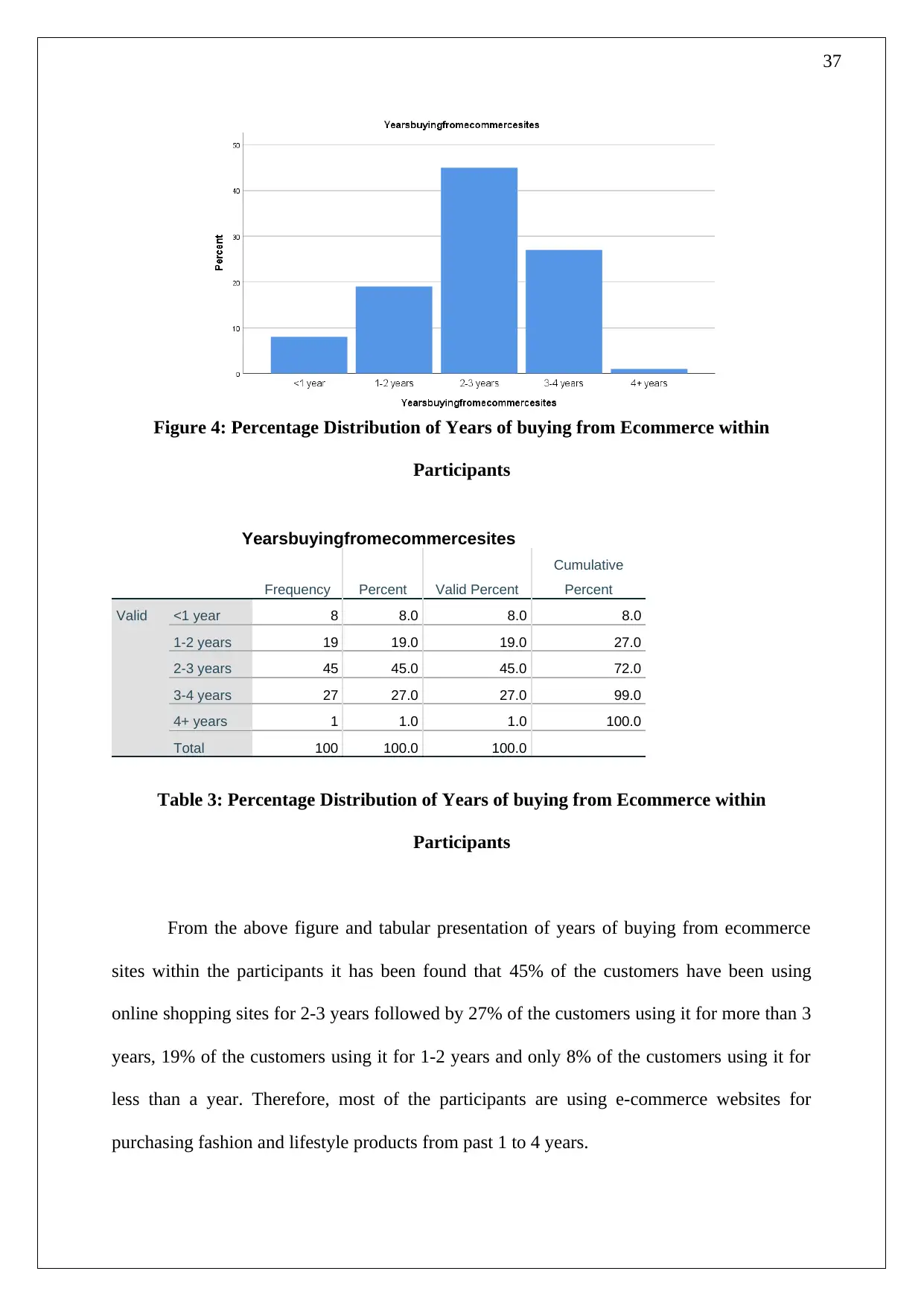
37
Figure 4: Percentage Distribution of Years of buying from Ecommerce within
Participants
Yearsbuyingfromecommercesites
Frequency Percent Valid Percent
Cumulative
Percent
Valid <1 year 8 8.0 8.0 8.0
1-2 years 19 19.0 19.0 27.0
2-3 years 45 45.0 45.0 72.0
3-4 years 27 27.0 27.0 99.0
4+ years 1 1.0 1.0 100.0
Total 100 100.0 100.0
Table 3: Percentage Distribution of Years of buying from Ecommerce within
Participants
From the above figure and tabular presentation of years of buying from ecommerce
sites within the participants it has been found that 45% of the customers have been using
online shopping sites for 2-3 years followed by 27% of the customers using it for more than 3
years, 19% of the customers using it for 1-2 years and only 8% of the customers using it for
less than a year. Therefore, most of the participants are using e-commerce websites for
purchasing fashion and lifestyle products from past 1 to 4 years.
Figure 4: Percentage Distribution of Years of buying from Ecommerce within
Participants
Yearsbuyingfromecommercesites
Frequency Percent Valid Percent
Cumulative
Percent
Valid <1 year 8 8.0 8.0 8.0
1-2 years 19 19.0 19.0 27.0
2-3 years 45 45.0 45.0 72.0
3-4 years 27 27.0 27.0 99.0
4+ years 1 1.0 1.0 100.0
Total 100 100.0 100.0
Table 3: Percentage Distribution of Years of buying from Ecommerce within
Participants
From the above figure and tabular presentation of years of buying from ecommerce
sites within the participants it has been found that 45% of the customers have been using
online shopping sites for 2-3 years followed by 27% of the customers using it for more than 3
years, 19% of the customers using it for 1-2 years and only 8% of the customers using it for
less than a year. Therefore, most of the participants are using e-commerce websites for
purchasing fashion and lifestyle products from past 1 to 4 years.
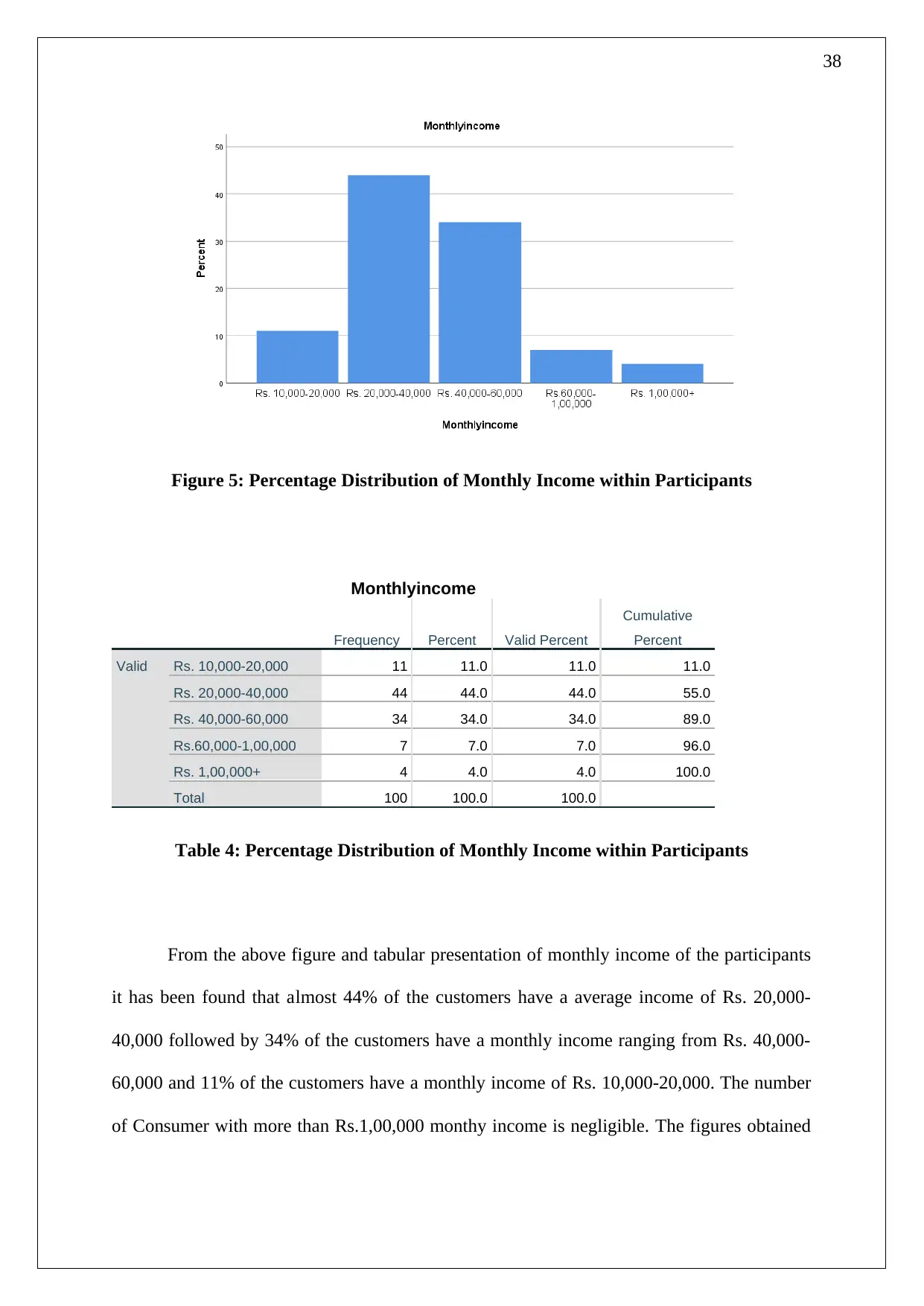
38
Figure 5: Percentage Distribution of Monthly Income within Participants
Monthlyincome
Frequency Percent Valid Percent
Cumulative
Percent
Valid Rs. 10,000-20,000 11 11.0 11.0 11.0
Rs. 20,000-40,000 44 44.0 44.0 55.0
Rs. 40,000-60,000 34 34.0 34.0 89.0
Rs.60,000-1,00,000 7 7.0 7.0 96.0
Rs. 1,00,000+ 4 4.0 4.0 100.0
Total 100 100.0 100.0
Table 4: Percentage Distribution of Monthly Income within Participants
From the above figure and tabular presentation of monthly income of the participants
it has been found that almost 44% of the customers have a average income of Rs. 20,000-
40,000 followed by 34% of the customers have a monthly income ranging from Rs. 40,000-
60,000 and 11% of the customers have a monthly income of Rs. 10,000-20,000. The number
of Consumer with more than Rs.1,00,000 monthy income is negligible. The figures obtained
Figure 5: Percentage Distribution of Monthly Income within Participants
Monthlyincome
Frequency Percent Valid Percent
Cumulative
Percent
Valid Rs. 10,000-20,000 11 11.0 11.0 11.0
Rs. 20,000-40,000 44 44.0 44.0 55.0
Rs. 40,000-60,000 34 34.0 34.0 89.0
Rs.60,000-1,00,000 7 7.0 7.0 96.0
Rs. 1,00,000+ 4 4.0 4.0 100.0
Total 100 100.0 100.0
Table 4: Percentage Distribution of Monthly Income within Participants
From the above figure and tabular presentation of monthly income of the participants
it has been found that almost 44% of the customers have a average income of Rs. 20,000-
40,000 followed by 34% of the customers have a monthly income ranging from Rs. 40,000-
60,000 and 11% of the customers have a monthly income of Rs. 10,000-20,000. The number
of Consumer with more than Rs.1,00,000 monthy income is negligible. The figures obtained
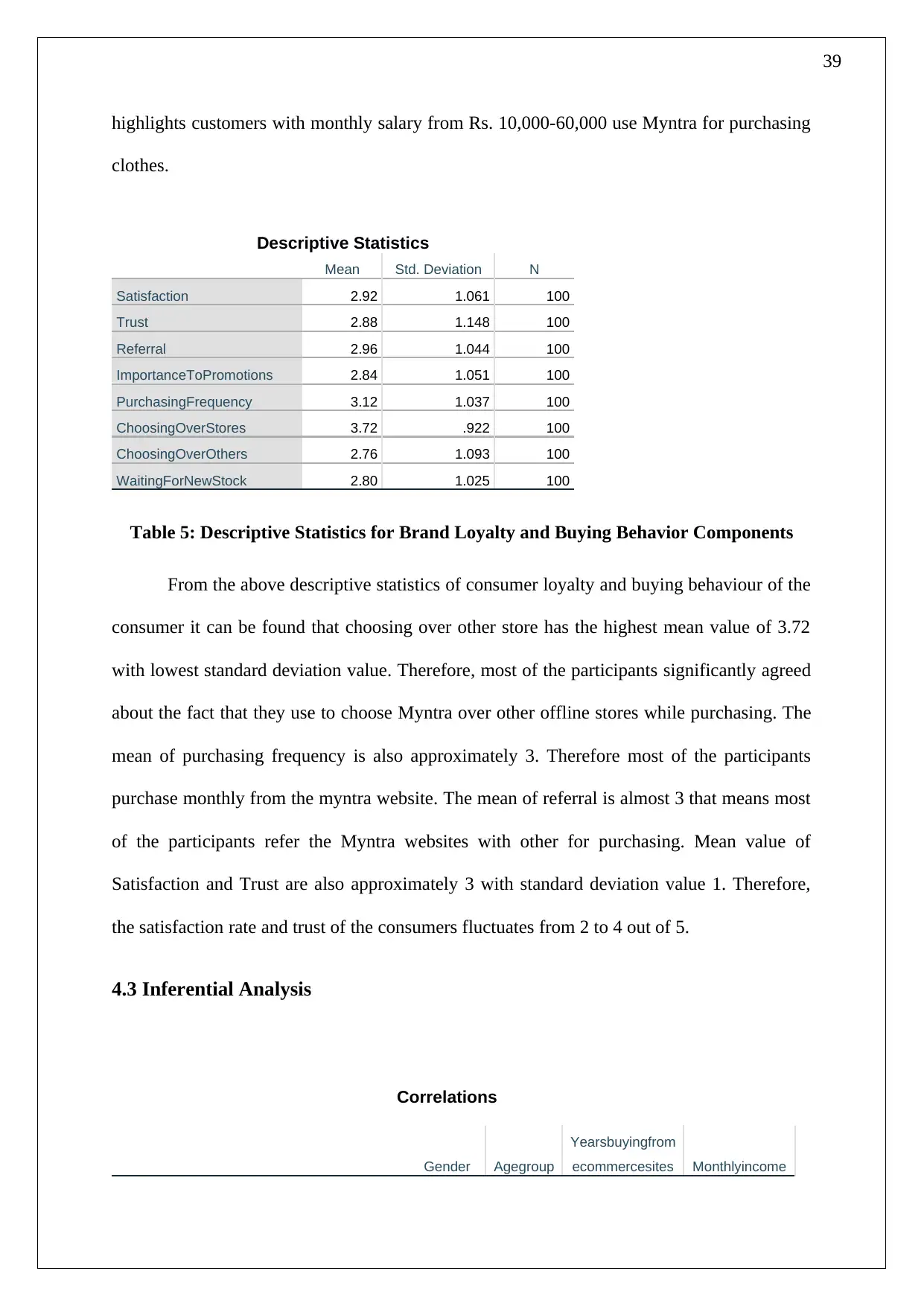
39
highlights customers with monthly salary from Rs. 10,000-60,000 use Myntra for purchasing
clothes.
Descriptive Statistics
Mean Std. Deviation N
Satisfaction 2.92 1.061 100
Trust 2.88 1.148 100
Referral 2.96 1.044 100
ImportanceToPromotions 2.84 1.051 100
PurchasingFrequency 3.12 1.037 100
ChoosingOverStores 3.72 .922 100
ChoosingOverOthers 2.76 1.093 100
WaitingForNewStock 2.80 1.025 100
Table 5: Descriptive Statistics for Brand Loyalty and Buying Behavior Components
From the above descriptive statistics of consumer loyalty and buying behaviour of the
consumer it can be found that choosing over other store has the highest mean value of 3.72
with lowest standard deviation value. Therefore, most of the participants significantly agreed
about the fact that they use to choose Myntra over other offline stores while purchasing. The
mean of purchasing frequency is also approximately 3. Therefore most of the participants
purchase monthly from the myntra website. The mean of referral is almost 3 that means most
of the participants refer the Myntra websites with other for purchasing. Mean value of
Satisfaction and Trust are also approximately 3 with standard deviation value 1. Therefore,
the satisfaction rate and trust of the consumers fluctuates from 2 to 4 out of 5.
4.3 Inferential Analysis
Correlations
Gender Agegroup
Yearsbuyingfrom
ecommercesites Monthlyincome
highlights customers with monthly salary from Rs. 10,000-60,000 use Myntra for purchasing
clothes.
Descriptive Statistics
Mean Std. Deviation N
Satisfaction 2.92 1.061 100
Trust 2.88 1.148 100
Referral 2.96 1.044 100
ImportanceToPromotions 2.84 1.051 100
PurchasingFrequency 3.12 1.037 100
ChoosingOverStores 3.72 .922 100
ChoosingOverOthers 2.76 1.093 100
WaitingForNewStock 2.80 1.025 100
Table 5: Descriptive Statistics for Brand Loyalty and Buying Behavior Components
From the above descriptive statistics of consumer loyalty and buying behaviour of the
consumer it can be found that choosing over other store has the highest mean value of 3.72
with lowest standard deviation value. Therefore, most of the participants significantly agreed
about the fact that they use to choose Myntra over other offline stores while purchasing. The
mean of purchasing frequency is also approximately 3. Therefore most of the participants
purchase monthly from the myntra website. The mean of referral is almost 3 that means most
of the participants refer the Myntra websites with other for purchasing. Mean value of
Satisfaction and Trust are also approximately 3 with standard deviation value 1. Therefore,
the satisfaction rate and trust of the consumers fluctuates from 2 to 4 out of 5.
4.3 Inferential Analysis
Correlations
Gender Agegroup
Yearsbuyingfrom
ecommercesites Monthlyincome
Secure Best Marks with AI Grader
Need help grading? Try our AI Grader for instant feedback on your assignments.
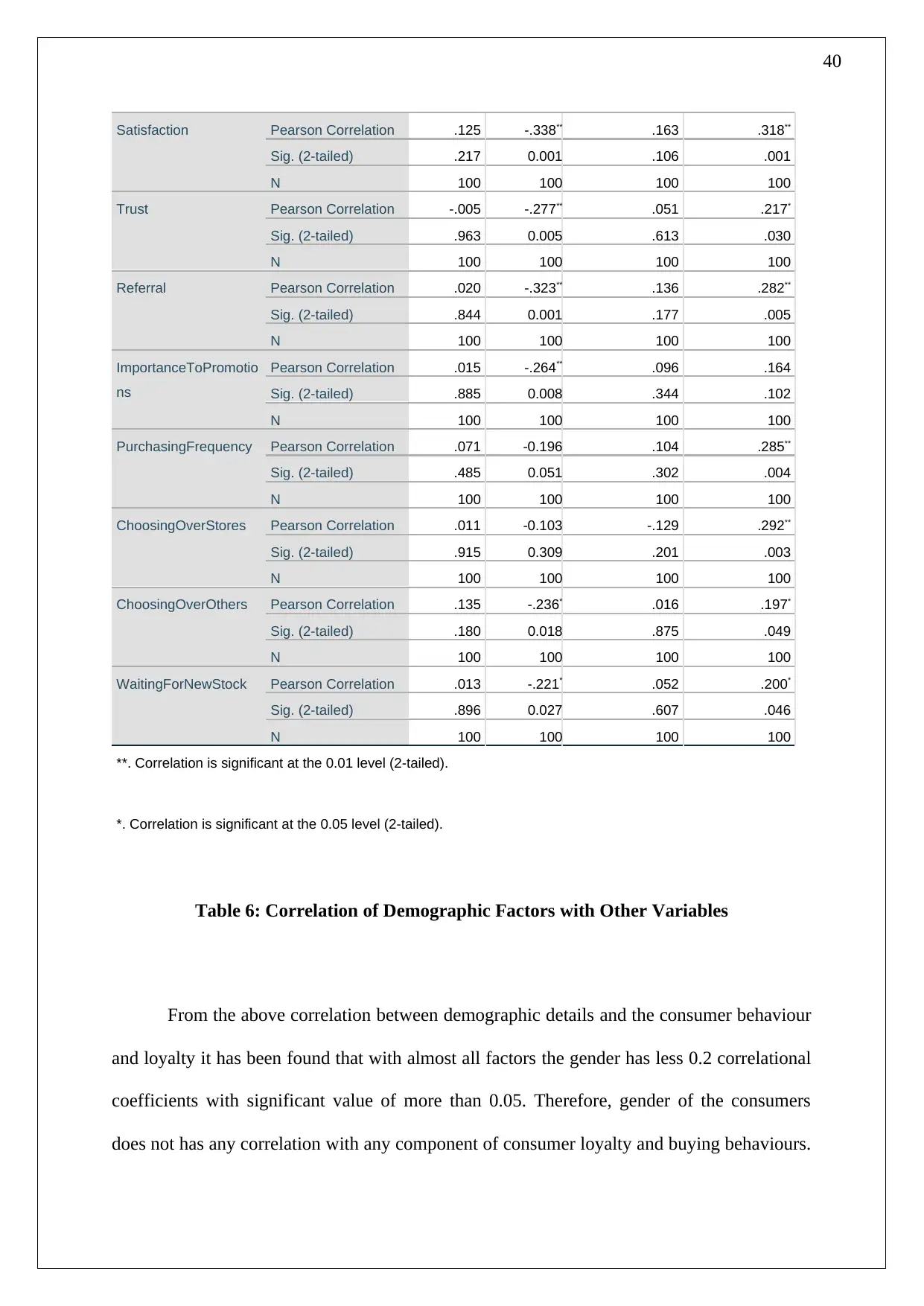
40
Satisfaction Pearson Correlation .125 -.338** .163 .318**
Sig. (2-tailed) .217 0.001 .106 .001
N 100 100 100 100
Trust Pearson Correlation -.005 -.277** .051 .217*
Sig. (2-tailed) .963 0.005 .613 .030
N 100 100 100 100
Referral Pearson Correlation .020 -.323** .136 .282**
Sig. (2-tailed) .844 0.001 .177 .005
N 100 100 100 100
ImportanceToPromotio
ns
Pearson Correlation .015 -.264** .096 .164
Sig. (2-tailed) .885 0.008 .344 .102
N 100 100 100 100
PurchasingFrequency Pearson Correlation .071 -0.196 .104 .285**
Sig. (2-tailed) .485 0.051 .302 .004
N 100 100 100 100
ChoosingOverStores Pearson Correlation .011 -0.103 -.129 .292**
Sig. (2-tailed) .915 0.309 .201 .003
N 100 100 100 100
ChoosingOverOthers Pearson Correlation .135 -.236* .016 .197*
Sig. (2-tailed) .180 0.018 .875 .049
N 100 100 100 100
WaitingForNewStock Pearson Correlation .013 -.221* .052 .200*
Sig. (2-tailed) .896 0.027 .607 .046
N 100 100 100 100
**. Correlation is significant at the 0.01 level (2-tailed).
*. Correlation is significant at the 0.05 level (2-tailed).
Table 6: Correlation of Demographic Factors with Other Variables
From the above correlation between demographic details and the consumer behaviour
and loyalty it has been found that with almost all factors the gender has less 0.2 correlational
coefficients with significant value of more than 0.05. Therefore, gender of the consumers
does not has any correlation with any component of consumer loyalty and buying behaviours.
Satisfaction Pearson Correlation .125 -.338** .163 .318**
Sig. (2-tailed) .217 0.001 .106 .001
N 100 100 100 100
Trust Pearson Correlation -.005 -.277** .051 .217*
Sig. (2-tailed) .963 0.005 .613 .030
N 100 100 100 100
Referral Pearson Correlation .020 -.323** .136 .282**
Sig. (2-tailed) .844 0.001 .177 .005
N 100 100 100 100
ImportanceToPromotio
ns
Pearson Correlation .015 -.264** .096 .164
Sig. (2-tailed) .885 0.008 .344 .102
N 100 100 100 100
PurchasingFrequency Pearson Correlation .071 -0.196 .104 .285**
Sig. (2-tailed) .485 0.051 .302 .004
N 100 100 100 100
ChoosingOverStores Pearson Correlation .011 -0.103 -.129 .292**
Sig. (2-tailed) .915 0.309 .201 .003
N 100 100 100 100
ChoosingOverOthers Pearson Correlation .135 -.236* .016 .197*
Sig. (2-tailed) .180 0.018 .875 .049
N 100 100 100 100
WaitingForNewStock Pearson Correlation .013 -.221* .052 .200*
Sig. (2-tailed) .896 0.027 .607 .046
N 100 100 100 100
**. Correlation is significant at the 0.01 level (2-tailed).
*. Correlation is significant at the 0.05 level (2-tailed).
Table 6: Correlation of Demographic Factors with Other Variables
From the above correlation between demographic details and the consumer behaviour
and loyalty it has been found that with almost all factors the gender has less 0.2 correlational
coefficients with significant value of more than 0.05. Therefore, gender of the consumers
does not has any correlation with any component of consumer loyalty and buying behaviours.
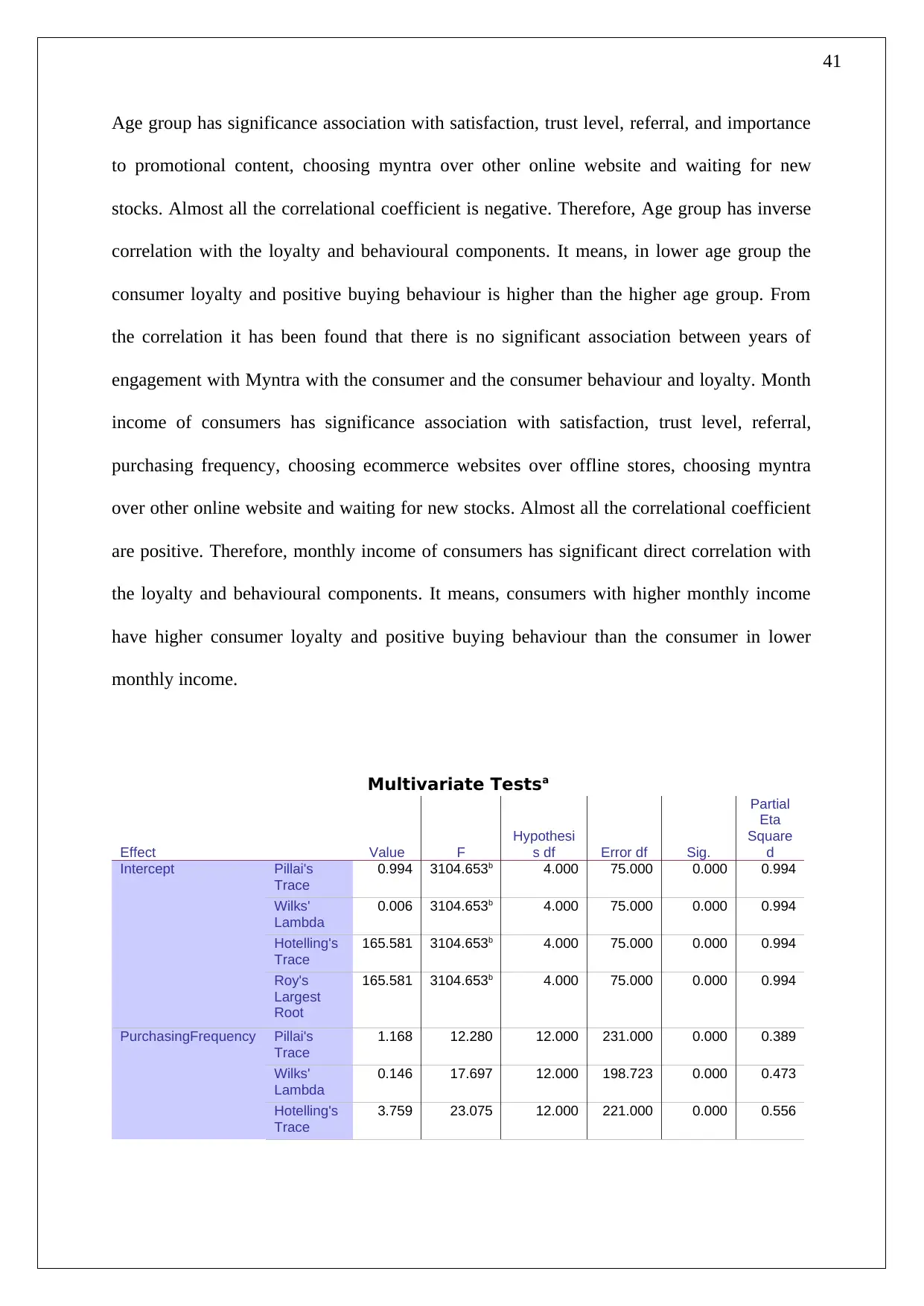
41
Age group has significance association with satisfaction, trust level, referral, and importance
to promotional content, choosing myntra over other online website and waiting for new
stocks. Almost all the correlational coefficient is negative. Therefore, Age group has inverse
correlation with the loyalty and behavioural components. It means, in lower age group the
consumer loyalty and positive buying behaviour is higher than the higher age group. From
the correlation it has been found that there is no significant association between years of
engagement with Myntra with the consumer and the consumer behaviour and loyalty. Month
income of consumers has significance association with satisfaction, trust level, referral,
purchasing frequency, choosing ecommerce websites over offline stores, choosing myntra
over other online website and waiting for new stocks. Almost all the correlational coefficient
are positive. Therefore, monthly income of consumers has significant direct correlation with
the loyalty and behavioural components. It means, consumers with higher monthly income
have higher consumer loyalty and positive buying behaviour than the consumer in lower
monthly income.
Multivariate Testsa
Effect Value F
Hypothesi
s df Error df Sig.
Partial
Eta
Square
d
Intercept Pillai's
Trace
0.994 3104.653b 4.000 75.000 0.000 0.994
Wilks'
Lambda
0.006 3104.653b 4.000 75.000 0.000 0.994
Hotelling's
Trace
165.581 3104.653b 4.000 75.000 0.000 0.994
Roy's
Largest
Root
165.581 3104.653b 4.000 75.000 0.000 0.994
PurchasingFrequency Pillai's
Trace
1.168 12.280 12.000 231.000 0.000 0.389
Wilks'
Lambda
0.146 17.697 12.000 198.723 0.000 0.473
Hotelling's
Trace
3.759 23.075 12.000 221.000 0.000 0.556
Age group has significance association with satisfaction, trust level, referral, and importance
to promotional content, choosing myntra over other online website and waiting for new
stocks. Almost all the correlational coefficient is negative. Therefore, Age group has inverse
correlation with the loyalty and behavioural components. It means, in lower age group the
consumer loyalty and positive buying behaviour is higher than the higher age group. From
the correlation it has been found that there is no significant association between years of
engagement with Myntra with the consumer and the consumer behaviour and loyalty. Month
income of consumers has significance association with satisfaction, trust level, referral,
purchasing frequency, choosing ecommerce websites over offline stores, choosing myntra
over other online website and waiting for new stocks. Almost all the correlational coefficient
are positive. Therefore, monthly income of consumers has significant direct correlation with
the loyalty and behavioural components. It means, consumers with higher monthly income
have higher consumer loyalty and positive buying behaviour than the consumer in lower
monthly income.
Multivariate Testsa
Effect Value F
Hypothesi
s df Error df Sig.
Partial
Eta
Square
d
Intercept Pillai's
Trace
0.994 3104.653b 4.000 75.000 0.000 0.994
Wilks'
Lambda
0.006 3104.653b 4.000 75.000 0.000 0.994
Hotelling's
Trace
165.581 3104.653b 4.000 75.000 0.000 0.994
Roy's
Largest
Root
165.581 3104.653b 4.000 75.000 0.000 0.994
PurchasingFrequency Pillai's
Trace
1.168 12.280 12.000 231.000 0.000 0.389
Wilks'
Lambda
0.146 17.697 12.000 198.723 0.000 0.473
Hotelling's
Trace
3.759 23.075 12.000 221.000 0.000 0.556
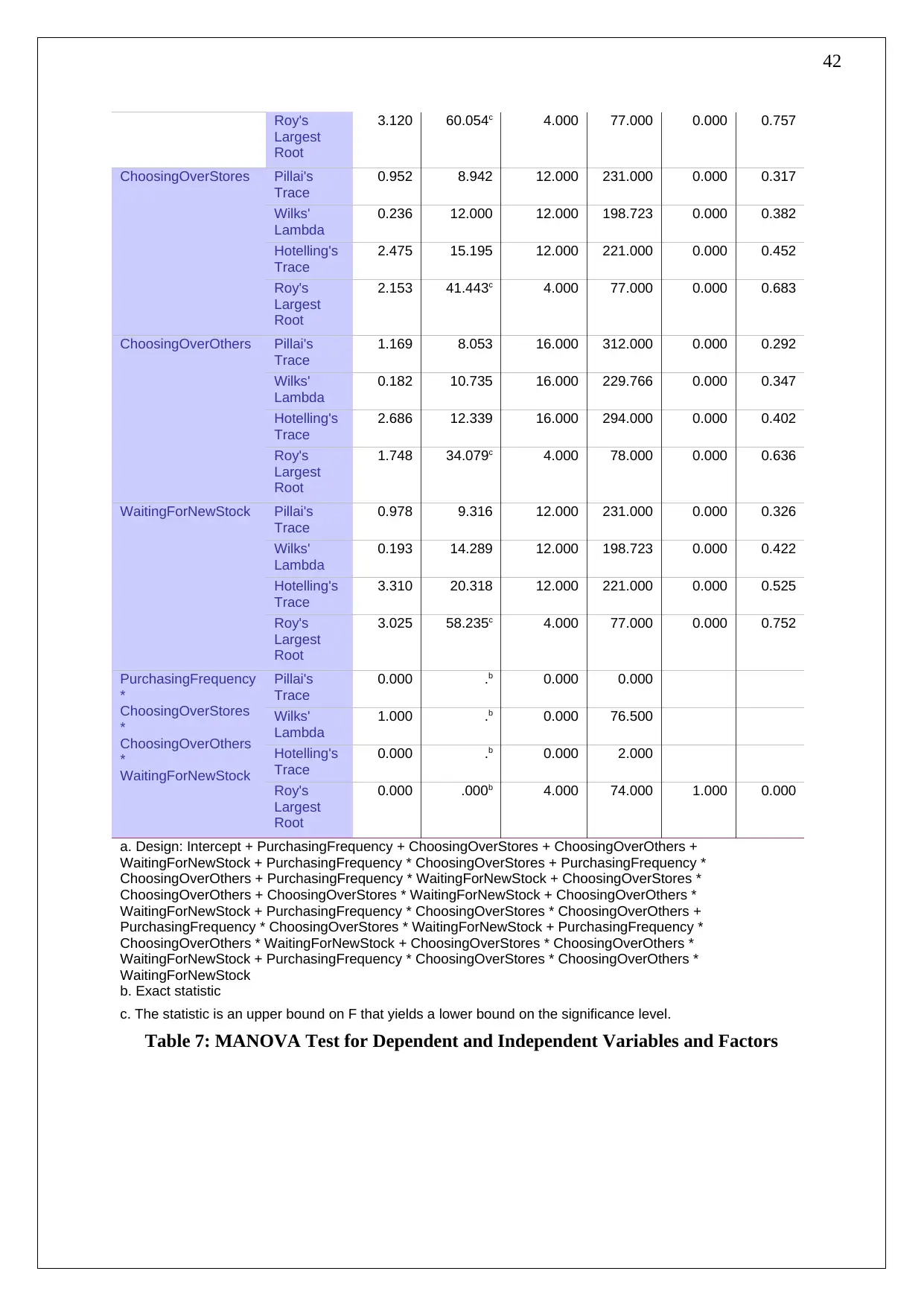
42
Roy's
Largest
Root
3.120 60.054c 4.000 77.000 0.000 0.757
ChoosingOverStores Pillai's
Trace
0.952 8.942 12.000 231.000 0.000 0.317
Wilks'
Lambda
0.236 12.000 12.000 198.723 0.000 0.382
Hotelling's
Trace
2.475 15.195 12.000 221.000 0.000 0.452
Roy's
Largest
Root
2.153 41.443c 4.000 77.000 0.000 0.683
ChoosingOverOthers Pillai's
Trace
1.169 8.053 16.000 312.000 0.000 0.292
Wilks'
Lambda
0.182 10.735 16.000 229.766 0.000 0.347
Hotelling's
Trace
2.686 12.339 16.000 294.000 0.000 0.402
Roy's
Largest
Root
1.748 34.079c 4.000 78.000 0.000 0.636
WaitingForNewStock Pillai's
Trace
0.978 9.316 12.000 231.000 0.000 0.326
Wilks'
Lambda
0.193 14.289 12.000 198.723 0.000 0.422
Hotelling's
Trace
3.310 20.318 12.000 221.000 0.000 0.525
Roy's
Largest
Root
3.025 58.235c 4.000 77.000 0.000 0.752
PurchasingFrequency
*
ChoosingOverStores
*
ChoosingOverOthers
*
WaitingForNewStock
Pillai's
Trace
0.000 .b 0.000 0.000
Wilks'
Lambda
1.000 .b 0.000 76.500
Hotelling's
Trace
0.000 .b 0.000 2.000
Roy's
Largest
Root
0.000 .000b 4.000 74.000 1.000 0.000
a. Design: Intercept + PurchasingFrequency + ChoosingOverStores + ChoosingOverOthers +
WaitingForNewStock + PurchasingFrequency * ChoosingOverStores + PurchasingFrequency *
ChoosingOverOthers + PurchasingFrequency * WaitingForNewStock + ChoosingOverStores *
ChoosingOverOthers + ChoosingOverStores * WaitingForNewStock + ChoosingOverOthers *
WaitingForNewStock + PurchasingFrequency * ChoosingOverStores * ChoosingOverOthers +
PurchasingFrequency * ChoosingOverStores * WaitingForNewStock + PurchasingFrequency *
ChoosingOverOthers * WaitingForNewStock + ChoosingOverStores * ChoosingOverOthers *
WaitingForNewStock + PurchasingFrequency * ChoosingOverStores * ChoosingOverOthers *
WaitingForNewStock
b. Exact statistic
c. The statistic is an upper bound on F that yields a lower bound on the significance level.
Table 7: MANOVA Test for Dependent and Independent Variables and Factors
Roy's
Largest
Root
3.120 60.054c 4.000 77.000 0.000 0.757
ChoosingOverStores Pillai's
Trace
0.952 8.942 12.000 231.000 0.000 0.317
Wilks'
Lambda
0.236 12.000 12.000 198.723 0.000 0.382
Hotelling's
Trace
2.475 15.195 12.000 221.000 0.000 0.452
Roy's
Largest
Root
2.153 41.443c 4.000 77.000 0.000 0.683
ChoosingOverOthers Pillai's
Trace
1.169 8.053 16.000 312.000 0.000 0.292
Wilks'
Lambda
0.182 10.735 16.000 229.766 0.000 0.347
Hotelling's
Trace
2.686 12.339 16.000 294.000 0.000 0.402
Roy's
Largest
Root
1.748 34.079c 4.000 78.000 0.000 0.636
WaitingForNewStock Pillai's
Trace
0.978 9.316 12.000 231.000 0.000 0.326
Wilks'
Lambda
0.193 14.289 12.000 198.723 0.000 0.422
Hotelling's
Trace
3.310 20.318 12.000 221.000 0.000 0.525
Roy's
Largest
Root
3.025 58.235c 4.000 77.000 0.000 0.752
PurchasingFrequency
*
ChoosingOverStores
*
ChoosingOverOthers
*
WaitingForNewStock
Pillai's
Trace
0.000 .b 0.000 0.000
Wilks'
Lambda
1.000 .b 0.000 76.500
Hotelling's
Trace
0.000 .b 0.000 2.000
Roy's
Largest
Root
0.000 .000b 4.000 74.000 1.000 0.000
a. Design: Intercept + PurchasingFrequency + ChoosingOverStores + ChoosingOverOthers +
WaitingForNewStock + PurchasingFrequency * ChoosingOverStores + PurchasingFrequency *
ChoosingOverOthers + PurchasingFrequency * WaitingForNewStock + ChoosingOverStores *
ChoosingOverOthers + ChoosingOverStores * WaitingForNewStock + ChoosingOverOthers *
WaitingForNewStock + PurchasingFrequency * ChoosingOverStores * ChoosingOverOthers +
PurchasingFrequency * ChoosingOverStores * WaitingForNewStock + PurchasingFrequency *
ChoosingOverOthers * WaitingForNewStock + ChoosingOverStores * ChoosingOverOthers *
WaitingForNewStock + PurchasingFrequency * ChoosingOverStores * ChoosingOverOthers *
WaitingForNewStock
b. Exact statistic
c. The statistic is an upper bound on F that yields a lower bound on the significance level.
Table 7: MANOVA Test for Dependent and Independent Variables and Factors
Paraphrase This Document
Need a fresh take? Get an instant paraphrase of this document with our AI Paraphraser
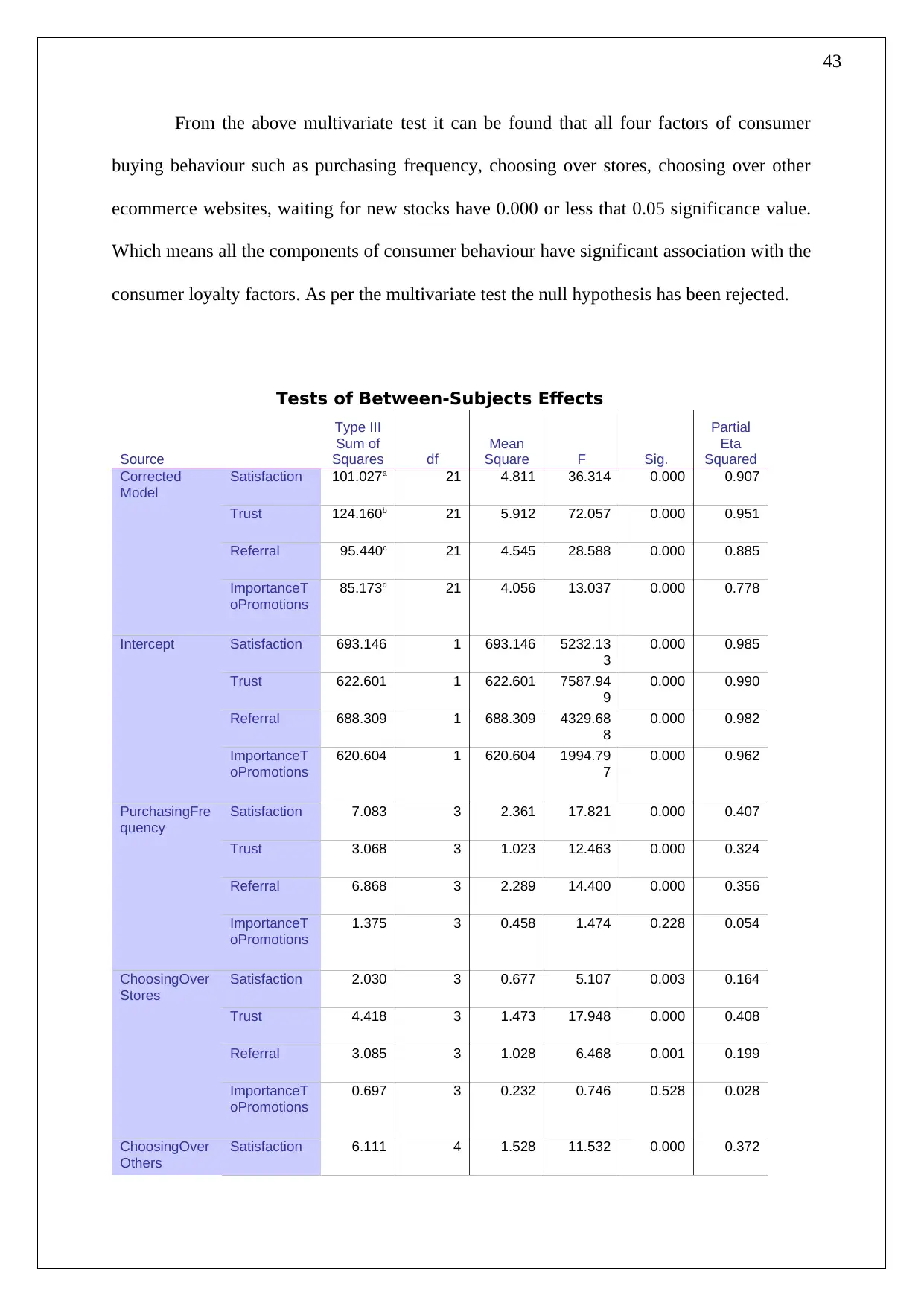
43
From the above multivariate test it can be found that all four factors of consumer
buying behaviour such as purchasing frequency, choosing over stores, choosing over other
ecommerce websites, waiting for new stocks have 0.000 or less that 0.05 significance value.
Which means all the components of consumer behaviour have significant association with the
consumer loyalty factors. As per the multivariate test the null hypothesis has been rejected.
Tests of Between-Subjects Effects
Source
Type III
Sum of
Squares df
Mean
Square F Sig.
Partial
Eta
Squared
Corrected
Model
Satisfaction 101.027a 21 4.811 36.314 0.000 0.907
Trust 124.160b 21 5.912 72.057 0.000 0.951
Referral 95.440c 21 4.545 28.588 0.000 0.885
ImportanceT
oPromotions
85.173d 21 4.056 13.037 0.000 0.778
Intercept Satisfaction 693.146 1 693.146 5232.13
3
0.000 0.985
Trust 622.601 1 622.601 7587.94
9
0.000 0.990
Referral 688.309 1 688.309 4329.68
8
0.000 0.982
ImportanceT
oPromotions
620.604 1 620.604 1994.79
7
0.000 0.962
PurchasingFre
quency
Satisfaction 7.083 3 2.361 17.821 0.000 0.407
Trust 3.068 3 1.023 12.463 0.000 0.324
Referral 6.868 3 2.289 14.400 0.000 0.356
ImportanceT
oPromotions
1.375 3 0.458 1.474 0.228 0.054
ChoosingOver
Stores
Satisfaction 2.030 3 0.677 5.107 0.003 0.164
Trust 4.418 3 1.473 17.948 0.000 0.408
Referral 3.085 3 1.028 6.468 0.001 0.199
ImportanceT
oPromotions
0.697 3 0.232 0.746 0.528 0.028
ChoosingOver
Others
Satisfaction 6.111 4 1.528 11.532 0.000 0.372
From the above multivariate test it can be found that all four factors of consumer
buying behaviour such as purchasing frequency, choosing over stores, choosing over other
ecommerce websites, waiting for new stocks have 0.000 or less that 0.05 significance value.
Which means all the components of consumer behaviour have significant association with the
consumer loyalty factors. As per the multivariate test the null hypothesis has been rejected.
Tests of Between-Subjects Effects
Source
Type III
Sum of
Squares df
Mean
Square F Sig.
Partial
Eta
Squared
Corrected
Model
Satisfaction 101.027a 21 4.811 36.314 0.000 0.907
Trust 124.160b 21 5.912 72.057 0.000 0.951
Referral 95.440c 21 4.545 28.588 0.000 0.885
ImportanceT
oPromotions
85.173d 21 4.056 13.037 0.000 0.778
Intercept Satisfaction 693.146 1 693.146 5232.13
3
0.000 0.985
Trust 622.601 1 622.601 7587.94
9
0.000 0.990
Referral 688.309 1 688.309 4329.68
8
0.000 0.982
ImportanceT
oPromotions
620.604 1 620.604 1994.79
7
0.000 0.962
PurchasingFre
quency
Satisfaction 7.083 3 2.361 17.821 0.000 0.407
Trust 3.068 3 1.023 12.463 0.000 0.324
Referral 6.868 3 2.289 14.400 0.000 0.356
ImportanceT
oPromotions
1.375 3 0.458 1.474 0.228 0.054
ChoosingOver
Stores
Satisfaction 2.030 3 0.677 5.107 0.003 0.164
Trust 4.418 3 1.473 17.948 0.000 0.408
Referral 3.085 3 1.028 6.468 0.001 0.199
ImportanceT
oPromotions
0.697 3 0.232 0.746 0.528 0.028
ChoosingOver
Others
Satisfaction 6.111 4 1.528 11.532 0.000 0.372
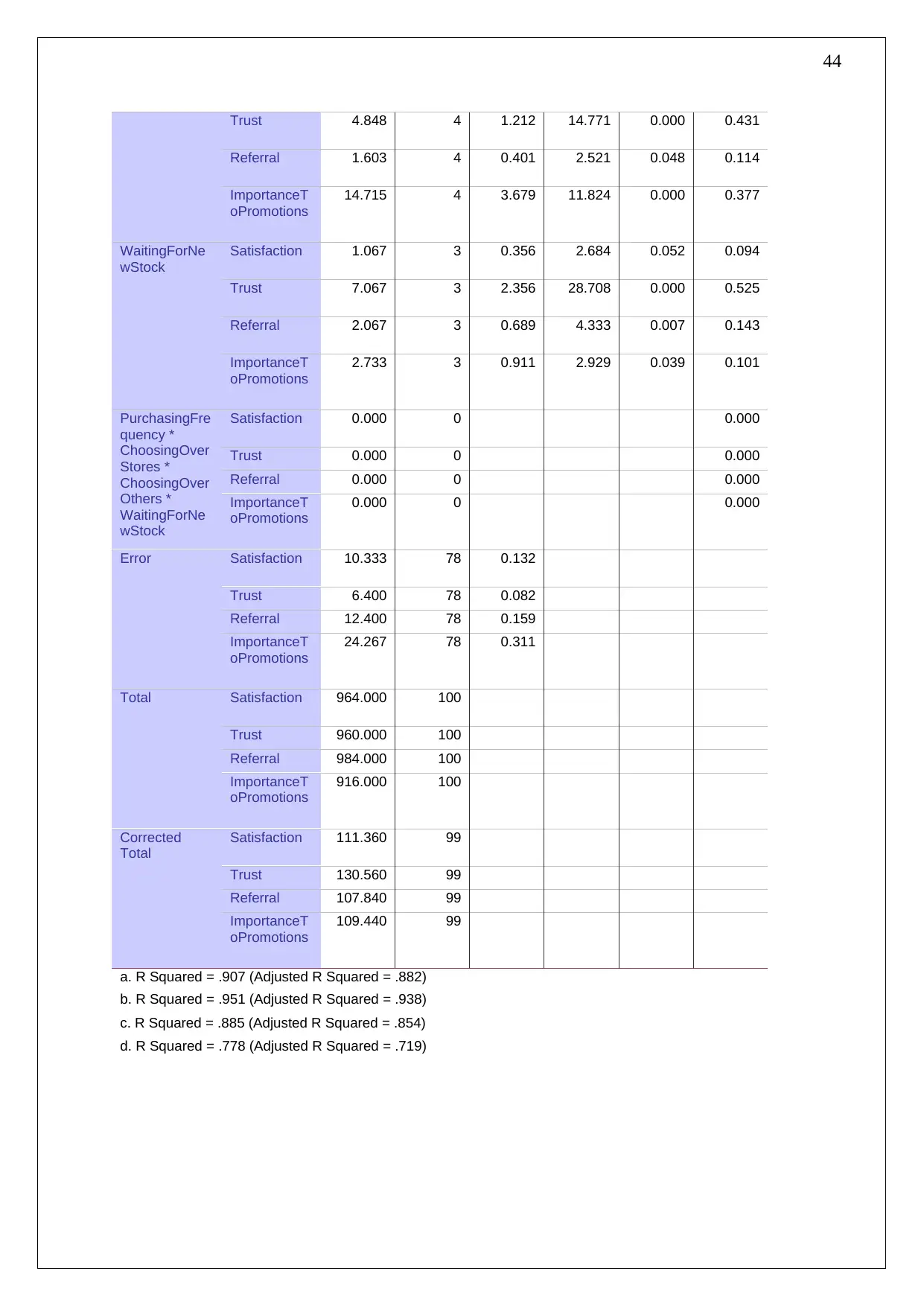
44
Trust 4.848 4 1.212 14.771 0.000 0.431
Referral 1.603 4 0.401 2.521 0.048 0.114
ImportanceT
oPromotions
14.715 4 3.679 11.824 0.000 0.377
WaitingForNe
wStock
Satisfaction 1.067 3 0.356 2.684 0.052 0.094
Trust 7.067 3 2.356 28.708 0.000 0.525
Referral 2.067 3 0.689 4.333 0.007 0.143
ImportanceT
oPromotions
2.733 3 0.911 2.929 0.039 0.101
PurchasingFre
quency *
ChoosingOver
Stores *
ChoosingOver
Others *
WaitingForNe
wStock
Satisfaction 0.000 0 0.000
Trust 0.000 0 0.000
Referral 0.000 0 0.000
ImportanceT
oPromotions
0.000 0 0.000
Error Satisfaction 10.333 78 0.132
Trust 6.400 78 0.082
Referral 12.400 78 0.159
ImportanceT
oPromotions
24.267 78 0.311
Total Satisfaction 964.000 100
Trust 960.000 100
Referral 984.000 100
ImportanceT
oPromotions
916.000 100
Corrected
Total
Satisfaction 111.360 99
Trust 130.560 99
Referral 107.840 99
ImportanceT
oPromotions
109.440 99
a. R Squared = .907 (Adjusted R Squared = .882)
b. R Squared = .951 (Adjusted R Squared = .938)
c. R Squared = .885 (Adjusted R Squared = .854)
d. R Squared = .778 (Adjusted R Squared = .719)
Trust 4.848 4 1.212 14.771 0.000 0.431
Referral 1.603 4 0.401 2.521 0.048 0.114
ImportanceT
oPromotions
14.715 4 3.679 11.824 0.000 0.377
WaitingForNe
wStock
Satisfaction 1.067 3 0.356 2.684 0.052 0.094
Trust 7.067 3 2.356 28.708 0.000 0.525
Referral 2.067 3 0.689 4.333 0.007 0.143
ImportanceT
oPromotions
2.733 3 0.911 2.929 0.039 0.101
PurchasingFre
quency *
ChoosingOver
Stores *
ChoosingOver
Others *
WaitingForNe
wStock
Satisfaction 0.000 0 0.000
Trust 0.000 0 0.000
Referral 0.000 0 0.000
ImportanceT
oPromotions
0.000 0 0.000
Error Satisfaction 10.333 78 0.132
Trust 6.400 78 0.082
Referral 12.400 78 0.159
ImportanceT
oPromotions
24.267 78 0.311
Total Satisfaction 964.000 100
Trust 960.000 100
Referral 984.000 100
ImportanceT
oPromotions
916.000 100
Corrected
Total
Satisfaction 111.360 99
Trust 130.560 99
Referral 107.840 99
ImportanceT
oPromotions
109.440 99
a. R Squared = .907 (Adjusted R Squared = .882)
b. R Squared = .951 (Adjusted R Squared = .938)
c. R Squared = .885 (Adjusted R Squared = .854)
d. R Squared = .778 (Adjusted R Squared = .719)
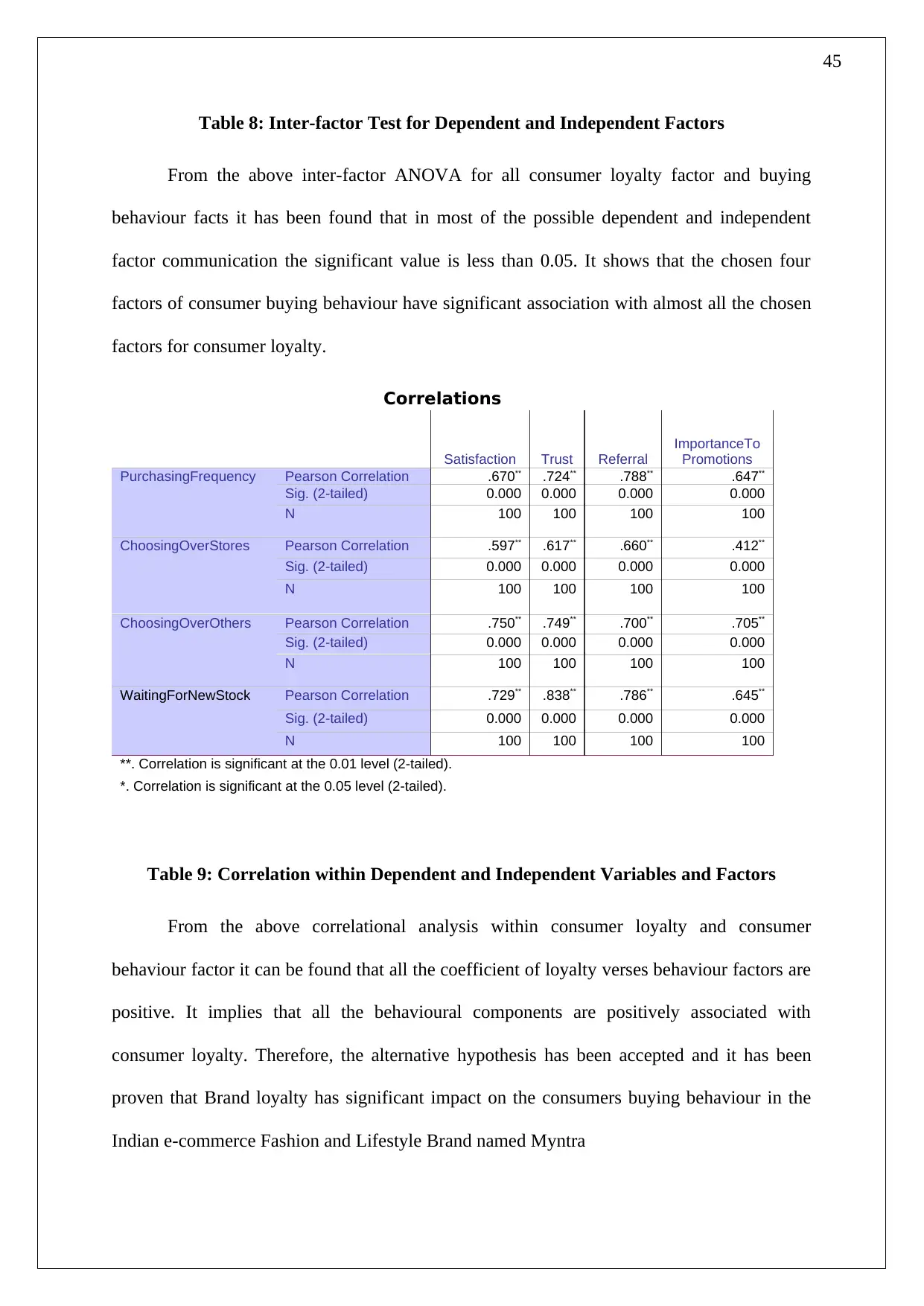
45
Table 8: Inter-factor Test for Dependent and Independent Factors
From the above inter-factor ANOVA for all consumer loyalty factor and buying
behaviour facts it has been found that in most of the possible dependent and independent
factor communication the significant value is less than 0.05. It shows that the chosen four
factors of consumer buying behaviour have significant association with almost all the chosen
factors for consumer loyalty.
Correlations
Satisfaction Trust Referral
ImportanceTo
Promotions
PurchasingFrequency Pearson Correlation .670** .724** .788** .647**
Sig. (2-tailed) 0.000 0.000 0.000 0.000
N 100 100 100 100
ChoosingOverStores Pearson Correlation .597** .617** .660** .412**
Sig. (2-tailed) 0.000 0.000 0.000 0.000
N 100 100 100 100
ChoosingOverOthers Pearson Correlation .750** .749** .700** .705**
Sig. (2-tailed) 0.000 0.000 0.000 0.000
N 100 100 100 100
WaitingForNewStock Pearson Correlation .729** .838** .786** .645**
Sig. (2-tailed) 0.000 0.000 0.000 0.000
N 100 100 100 100
**. Correlation is significant at the 0.01 level (2-tailed).
*. Correlation is significant at the 0.05 level (2-tailed).
Table 9: Correlation within Dependent and Independent Variables and Factors
From the above correlational analysis within consumer loyalty and consumer
behaviour factor it can be found that all the coefficient of loyalty verses behaviour factors are
positive. It implies that all the behavioural components are positively associated with
consumer loyalty. Therefore, the alternative hypothesis has been accepted and it has been
proven that Brand loyalty has significant impact on the consumers buying behaviour in the
Indian e-commerce Fashion and Lifestyle Brand named Myntra
Table 8: Inter-factor Test for Dependent and Independent Factors
From the above inter-factor ANOVA for all consumer loyalty factor and buying
behaviour facts it has been found that in most of the possible dependent and independent
factor communication the significant value is less than 0.05. It shows that the chosen four
factors of consumer buying behaviour have significant association with almost all the chosen
factors for consumer loyalty.
Correlations
Satisfaction Trust Referral
ImportanceTo
Promotions
PurchasingFrequency Pearson Correlation .670** .724** .788** .647**
Sig. (2-tailed) 0.000 0.000 0.000 0.000
N 100 100 100 100
ChoosingOverStores Pearson Correlation .597** .617** .660** .412**
Sig. (2-tailed) 0.000 0.000 0.000 0.000
N 100 100 100 100
ChoosingOverOthers Pearson Correlation .750** .749** .700** .705**
Sig. (2-tailed) 0.000 0.000 0.000 0.000
N 100 100 100 100
WaitingForNewStock Pearson Correlation .729** .838** .786** .645**
Sig. (2-tailed) 0.000 0.000 0.000 0.000
N 100 100 100 100
**. Correlation is significant at the 0.01 level (2-tailed).
*. Correlation is significant at the 0.05 level (2-tailed).
Table 9: Correlation within Dependent and Independent Variables and Factors
From the above correlational analysis within consumer loyalty and consumer
behaviour factor it can be found that all the coefficient of loyalty verses behaviour factors are
positive. It implies that all the behavioural components are positively associated with
consumer loyalty. Therefore, the alternative hypothesis has been accepted and it has been
proven that Brand loyalty has significant impact on the consumers buying behaviour in the
Indian e-commerce Fashion and Lifestyle Brand named Myntra
Secure Best Marks with AI Grader
Need help grading? Try our AI Grader for instant feedback on your assignments.
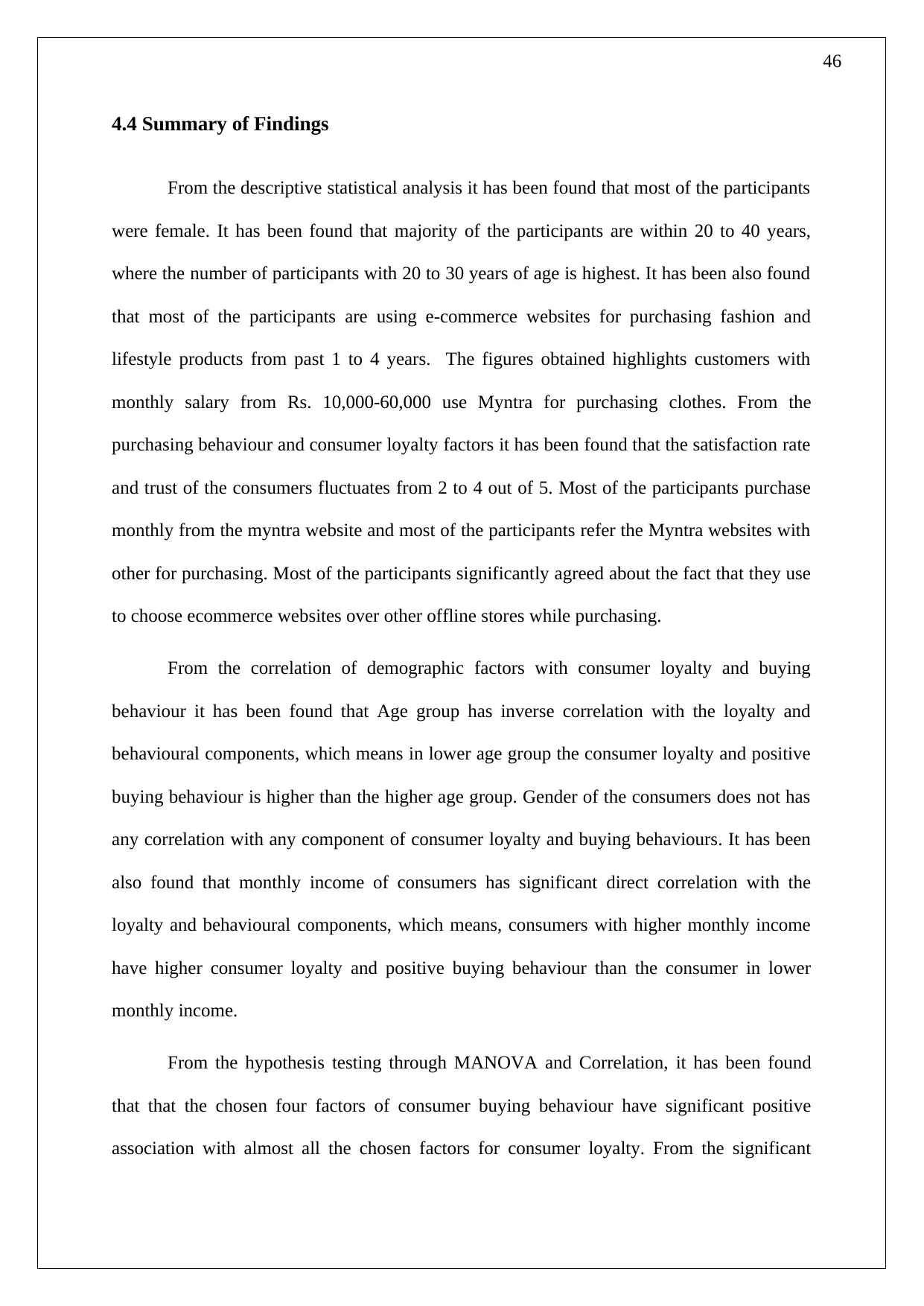
46
4.4 Summary of Findings
From the descriptive statistical analysis it has been found that most of the participants
were female. It has been found that majority of the participants are within 20 to 40 years,
where the number of participants with 20 to 30 years of age is highest. It has been also found
that most of the participants are using e-commerce websites for purchasing fashion and
lifestyle products from past 1 to 4 years. The figures obtained highlights customers with
monthly salary from Rs. 10,000-60,000 use Myntra for purchasing clothes. From the
purchasing behaviour and consumer loyalty factors it has been found that the satisfaction rate
and trust of the consumers fluctuates from 2 to 4 out of 5. Most of the participants purchase
monthly from the myntra website and most of the participants refer the Myntra websites with
other for purchasing. Most of the participants significantly agreed about the fact that they use
to choose ecommerce websites over other offline stores while purchasing.
From the correlation of demographic factors with consumer loyalty and buying
behaviour it has been found that Age group has inverse correlation with the loyalty and
behavioural components, which means in lower age group the consumer loyalty and positive
buying behaviour is higher than the higher age group. Gender of the consumers does not has
any correlation with any component of consumer loyalty and buying behaviours. It has been
also found that monthly income of consumers has significant direct correlation with the
loyalty and behavioural components, which means, consumers with higher monthly income
have higher consumer loyalty and positive buying behaviour than the consumer in lower
monthly income.
From the hypothesis testing through MANOVA and Correlation, it has been found
that that the chosen four factors of consumer buying behaviour have significant positive
association with almost all the chosen factors for consumer loyalty. From the significant
4.4 Summary of Findings
From the descriptive statistical analysis it has been found that most of the participants
were female. It has been found that majority of the participants are within 20 to 40 years,
where the number of participants with 20 to 30 years of age is highest. It has been also found
that most of the participants are using e-commerce websites for purchasing fashion and
lifestyle products from past 1 to 4 years. The figures obtained highlights customers with
monthly salary from Rs. 10,000-60,000 use Myntra for purchasing clothes. From the
purchasing behaviour and consumer loyalty factors it has been found that the satisfaction rate
and trust of the consumers fluctuates from 2 to 4 out of 5. Most of the participants purchase
monthly from the myntra website and most of the participants refer the Myntra websites with
other for purchasing. Most of the participants significantly agreed about the fact that they use
to choose ecommerce websites over other offline stores while purchasing.
From the correlation of demographic factors with consumer loyalty and buying
behaviour it has been found that Age group has inverse correlation with the loyalty and
behavioural components, which means in lower age group the consumer loyalty and positive
buying behaviour is higher than the higher age group. Gender of the consumers does not has
any correlation with any component of consumer loyalty and buying behaviours. It has been
also found that monthly income of consumers has significant direct correlation with the
loyalty and behavioural components, which means, consumers with higher monthly income
have higher consumer loyalty and positive buying behaviour than the consumer in lower
monthly income.
From the hypothesis testing through MANOVA and Correlation, it has been found
that that the chosen four factors of consumer buying behaviour have significant positive
association with almost all the chosen factors for consumer loyalty. From the significant
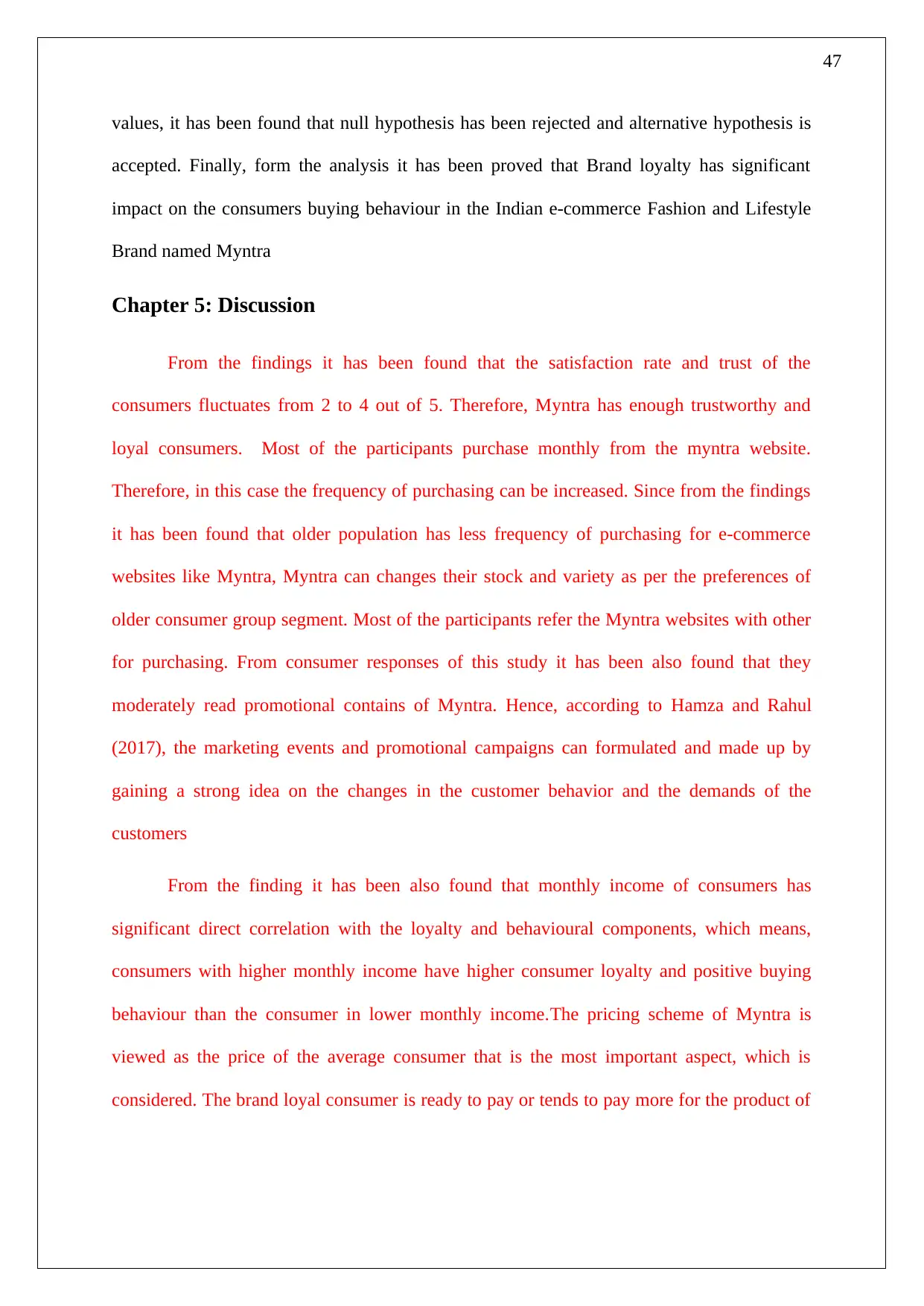
47
values, it has been found that null hypothesis has been rejected and alternative hypothesis is
accepted. Finally, form the analysis it has been proved that Brand loyalty has significant
impact on the consumers buying behaviour in the Indian e-commerce Fashion and Lifestyle
Brand named Myntra
Chapter 5: Discussion
From the findings it has been found that the satisfaction rate and trust of the
consumers fluctuates from 2 to 4 out of 5. Therefore, Myntra has enough trustworthy and
loyal consumers. Most of the participants purchase monthly from the myntra website.
Therefore, in this case the frequency of purchasing can be increased. Since from the findings
it has been found that older population has less frequency of purchasing for e-commerce
websites like Myntra, Myntra can changes their stock and variety as per the preferences of
older consumer group segment. Most of the participants refer the Myntra websites with other
for purchasing. From consumer responses of this study it has been also found that they
moderately read promotional contains of Myntra. Hence, according to Hamza and Rahul
(2017), the marketing events and promotional campaigns can formulated and made up by
gaining a strong idea on the changes in the customer behavior and the demands of the
customers
From the finding it has been also found that monthly income of consumers has
significant direct correlation with the loyalty and behavioural components, which means,
consumers with higher monthly income have higher consumer loyalty and positive buying
behaviour than the consumer in lower monthly income.The pricing scheme of Myntra is
viewed as the price of the average consumer that is the most important aspect, which is
considered. The brand loyal consumer is ready to pay or tends to pay more for the product of
values, it has been found that null hypothesis has been rejected and alternative hypothesis is
accepted. Finally, form the analysis it has been proved that Brand loyalty has significant
impact on the consumers buying behaviour in the Indian e-commerce Fashion and Lifestyle
Brand named Myntra
Chapter 5: Discussion
From the findings it has been found that the satisfaction rate and trust of the
consumers fluctuates from 2 to 4 out of 5. Therefore, Myntra has enough trustworthy and
loyal consumers. Most of the participants purchase monthly from the myntra website.
Therefore, in this case the frequency of purchasing can be increased. Since from the findings
it has been found that older population has less frequency of purchasing for e-commerce
websites like Myntra, Myntra can changes their stock and variety as per the preferences of
older consumer group segment. Most of the participants refer the Myntra websites with other
for purchasing. From consumer responses of this study it has been also found that they
moderately read promotional contains of Myntra. Hence, according to Hamza and Rahul
(2017), the marketing events and promotional campaigns can formulated and made up by
gaining a strong idea on the changes in the customer behavior and the demands of the
customers
From the finding it has been also found that monthly income of consumers has
significant direct correlation with the loyalty and behavioural components, which means,
consumers with higher monthly income have higher consumer loyalty and positive buying
behaviour than the consumer in lower monthly income.The pricing scheme of Myntra is
viewed as the price of the average consumer that is the most important aspect, which is
considered. The brand loyal consumer is ready to pay or tends to pay more for the product of
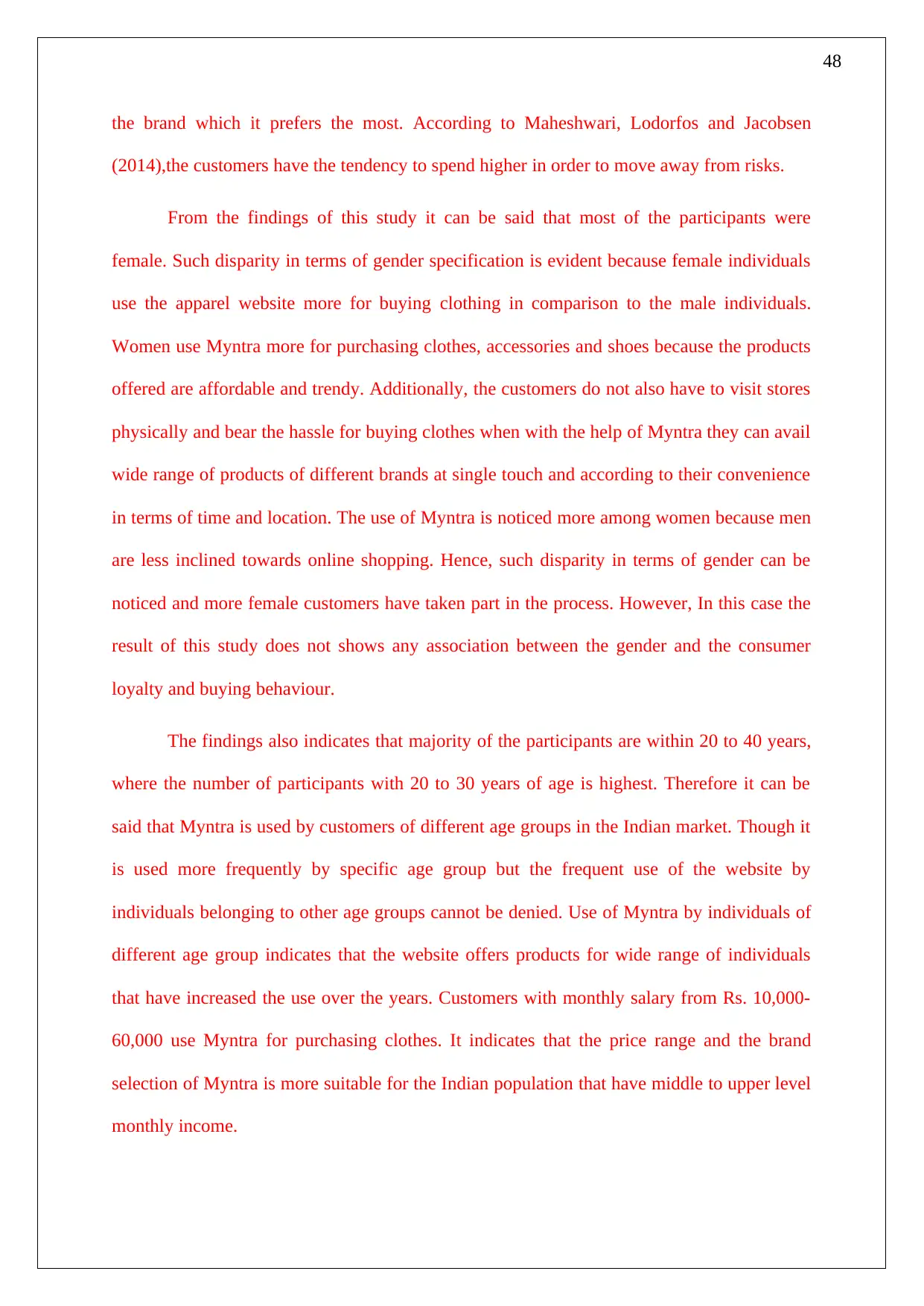
48
the brand which it prefers the most. According to Maheshwari, Lodorfos and Jacobsen
(2014),the customers have the tendency to spend higher in order to move away from risks.
From the findings of this study it can be said that most of the participants were
female. Such disparity in terms of gender specification is evident because female individuals
use the apparel website more for buying clothing in comparison to the male individuals.
Women use Myntra more for purchasing clothes, accessories and shoes because the products
offered are affordable and trendy. Additionally, the customers do not also have to visit stores
physically and bear the hassle for buying clothes when with the help of Myntra they can avail
wide range of products of different brands at single touch and according to their convenience
in terms of time and location. The use of Myntra is noticed more among women because men
are less inclined towards online shopping. Hence, such disparity in terms of gender can be
noticed and more female customers have taken part in the process. However, In this case the
result of this study does not shows any association between the gender and the consumer
loyalty and buying behaviour.
The findings also indicates that majority of the participants are within 20 to 40 years,
where the number of participants with 20 to 30 years of age is highest. Therefore it can be
said that Myntra is used by customers of different age groups in the Indian market. Though it
is used more frequently by specific age group but the frequent use of the website by
individuals belonging to other age groups cannot be denied. Use of Myntra by individuals of
different age group indicates that the website offers products for wide range of individuals
that have increased the use over the years. Customers with monthly salary from Rs. 10,000-
60,000 use Myntra for purchasing clothes. It indicates that the price range and the brand
selection of Myntra is more suitable for the Indian population that have middle to upper level
monthly income.
the brand which it prefers the most. According to Maheshwari, Lodorfos and Jacobsen
(2014),the customers have the tendency to spend higher in order to move away from risks.
From the findings of this study it can be said that most of the participants were
female. Such disparity in terms of gender specification is evident because female individuals
use the apparel website more for buying clothing in comparison to the male individuals.
Women use Myntra more for purchasing clothes, accessories and shoes because the products
offered are affordable and trendy. Additionally, the customers do not also have to visit stores
physically and bear the hassle for buying clothes when with the help of Myntra they can avail
wide range of products of different brands at single touch and according to their convenience
in terms of time and location. The use of Myntra is noticed more among women because men
are less inclined towards online shopping. Hence, such disparity in terms of gender can be
noticed and more female customers have taken part in the process. However, In this case the
result of this study does not shows any association between the gender and the consumer
loyalty and buying behaviour.
The findings also indicates that majority of the participants are within 20 to 40 years,
where the number of participants with 20 to 30 years of age is highest. Therefore it can be
said that Myntra is used by customers of different age groups in the Indian market. Though it
is used more frequently by specific age group but the frequent use of the website by
individuals belonging to other age groups cannot be denied. Use of Myntra by individuals of
different age group indicates that the website offers products for wide range of individuals
that have increased the use over the years. Customers with monthly salary from Rs. 10,000-
60,000 use Myntra for purchasing clothes. It indicates that the price range and the brand
selection of Myntra is more suitable for the Indian population that have middle to upper level
monthly income.
Paraphrase This Document
Need a fresh take? Get an instant paraphrase of this document with our AI Paraphraser
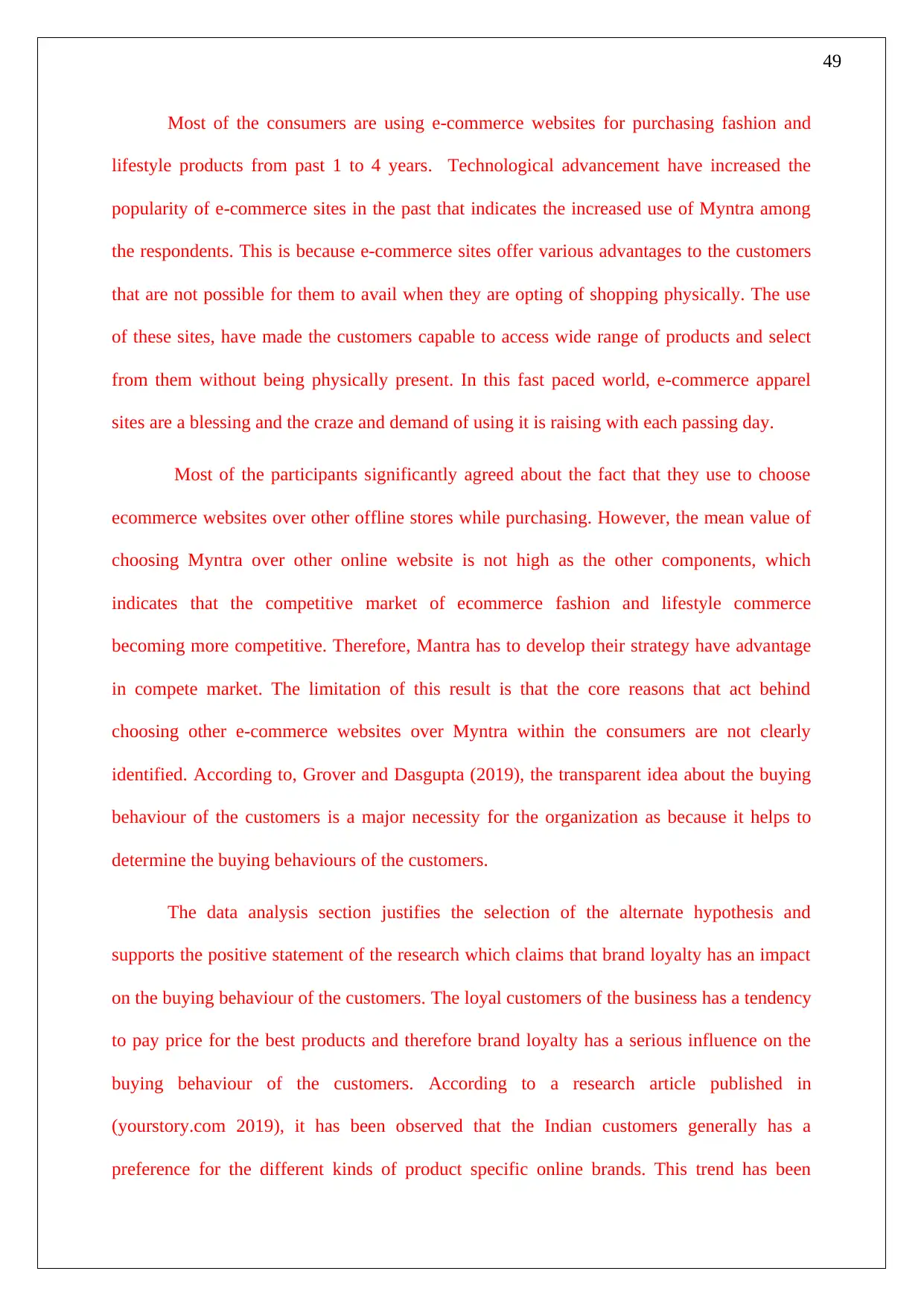
49
Most of the consumers are using e-commerce websites for purchasing fashion and
lifestyle products from past 1 to 4 years. Technological advancement have increased the
popularity of e-commerce sites in the past that indicates the increased use of Myntra among
the respondents. This is because e-commerce sites offer various advantages to the customers
that are not possible for them to avail when they are opting of shopping physically. The use
of these sites, have made the customers capable to access wide range of products and select
from them without being physically present. In this fast paced world, e-commerce apparel
sites are a blessing and the craze and demand of using it is raising with each passing day.
Most of the participants significantly agreed about the fact that they use to choose
ecommerce websites over other offline stores while purchasing. However, the mean value of
choosing Myntra over other online website is not high as the other components, which
indicates that the competitive market of ecommerce fashion and lifestyle commerce
becoming more competitive. Therefore, Mantra has to develop their strategy have advantage
in compete market. The limitation of this result is that the core reasons that act behind
choosing other e-commerce websites over Myntra within the consumers are not clearly
identified. According to, Grover and Dasgupta (2019), the transparent idea about the buying
behaviour of the customers is a major necessity for the organization as because it helps to
determine the buying behaviours of the customers.
The data analysis section justifies the selection of the alternate hypothesis and
supports the positive statement of the research which claims that brand loyalty has an impact
on the buying behaviour of the customers. The loyal customers of the business has a tendency
to pay price for the best products and therefore brand loyalty has a serious influence on the
buying behaviour of the customers. According to a research article published in
(yourstory.com 2019), it has been observed that the Indian customers generally has a
preference for the different kinds of product specific online brands. This trend has been
Most of the consumers are using e-commerce websites for purchasing fashion and
lifestyle products from past 1 to 4 years. Technological advancement have increased the
popularity of e-commerce sites in the past that indicates the increased use of Myntra among
the respondents. This is because e-commerce sites offer various advantages to the customers
that are not possible for them to avail when they are opting of shopping physically. The use
of these sites, have made the customers capable to access wide range of products and select
from them without being physically present. In this fast paced world, e-commerce apparel
sites are a blessing and the craze and demand of using it is raising with each passing day.
Most of the participants significantly agreed about the fact that they use to choose
ecommerce websites over other offline stores while purchasing. However, the mean value of
choosing Myntra over other online website is not high as the other components, which
indicates that the competitive market of ecommerce fashion and lifestyle commerce
becoming more competitive. Therefore, Mantra has to develop their strategy have advantage
in compete market. The limitation of this result is that the core reasons that act behind
choosing other e-commerce websites over Myntra within the consumers are not clearly
identified. According to, Grover and Dasgupta (2019), the transparent idea about the buying
behaviour of the customers is a major necessity for the organization as because it helps to
determine the buying behaviours of the customers.
The data analysis section justifies the selection of the alternate hypothesis and
supports the positive statement of the research which claims that brand loyalty has an impact
on the buying behaviour of the customers. The loyal customers of the business has a tendency
to pay price for the best products and therefore brand loyalty has a serious influence on the
buying behaviour of the customers. According to a research article published in
(yourstory.com 2019), it has been observed that the Indian customers generally has a
preference for the different kinds of product specific online brands. This trend has been
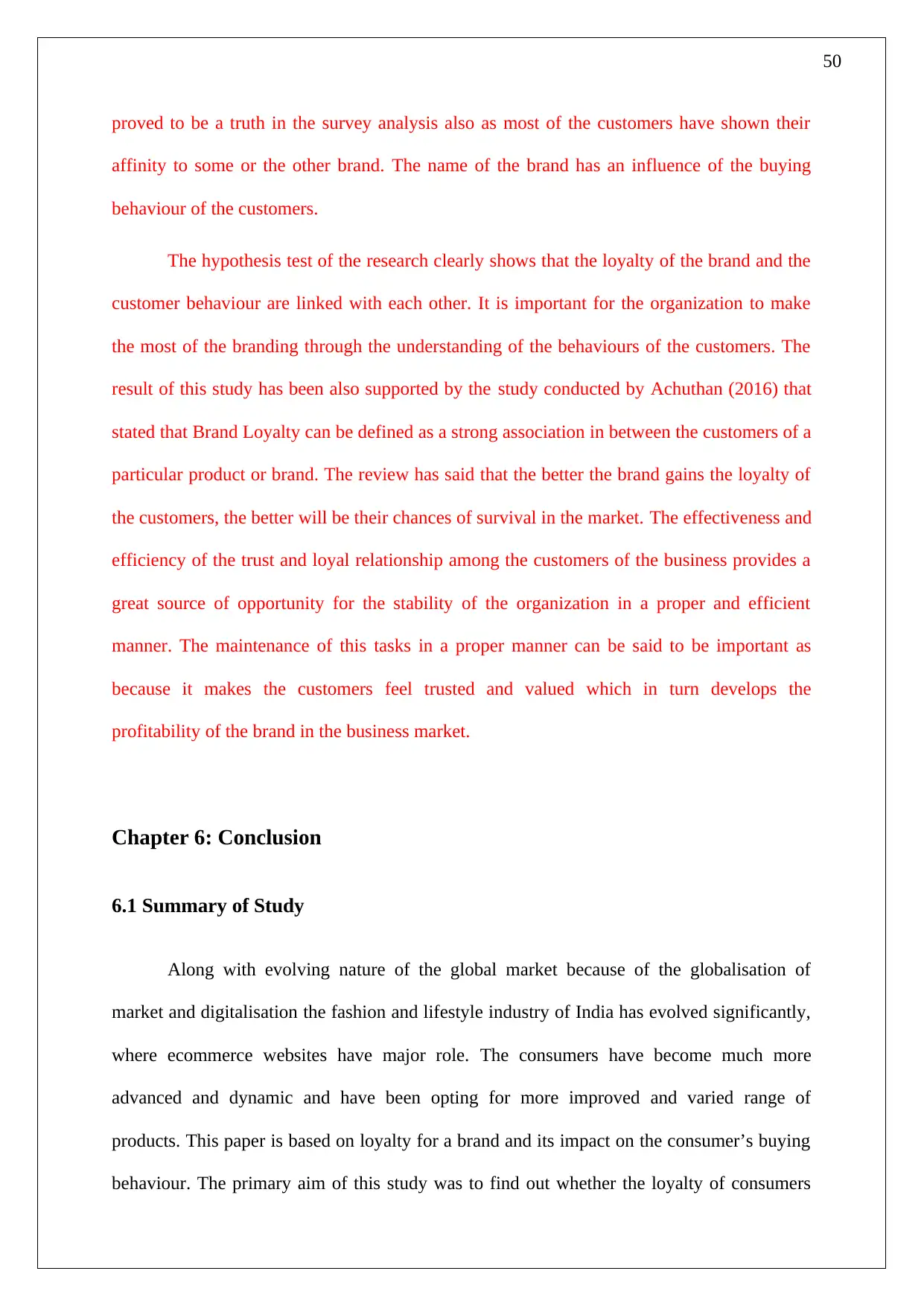
50
proved to be a truth in the survey analysis also as most of the customers have shown their
affinity to some or the other brand. The name of the brand has an influence of the buying
behaviour of the customers.
The hypothesis test of the research clearly shows that the loyalty of the brand and the
customer behaviour are linked with each other. It is important for the organization to make
the most of the branding through the understanding of the behaviours of the customers. The
result of this study has been also supported by the study conducted by Achuthan (2016) that
stated that Brand Loyalty can be defined as a strong association in between the customers of a
particular product or brand. The review has said that the better the brand gains the loyalty of
the customers, the better will be their chances of survival in the market. The effectiveness and
efficiency of the trust and loyal relationship among the customers of the business provides a
great source of opportunity for the stability of the organization in a proper and efficient
manner. The maintenance of this tasks in a proper manner can be said to be important as
because it makes the customers feel trusted and valued which in turn develops the
profitability of the brand in the business market.
Chapter 6: Conclusion
6.1 Summary of Study
Along with evolving nature of the global market because of the globalisation of
market and digitalisation the fashion and lifestyle industry of India has evolved significantly,
where ecommerce websites have major role. The consumers have become much more
advanced and dynamic and have been opting for more improved and varied range of
products. This paper is based on loyalty for a brand and its impact on the consumer’s buying
behaviour. The primary aim of this study was to find out whether the loyalty of consumers
proved to be a truth in the survey analysis also as most of the customers have shown their
affinity to some or the other brand. The name of the brand has an influence of the buying
behaviour of the customers.
The hypothesis test of the research clearly shows that the loyalty of the brand and the
customer behaviour are linked with each other. It is important for the organization to make
the most of the branding through the understanding of the behaviours of the customers. The
result of this study has been also supported by the study conducted by Achuthan (2016) that
stated that Brand Loyalty can be defined as a strong association in between the customers of a
particular product or brand. The review has said that the better the brand gains the loyalty of
the customers, the better will be their chances of survival in the market. The effectiveness and
efficiency of the trust and loyal relationship among the customers of the business provides a
great source of opportunity for the stability of the organization in a proper and efficient
manner. The maintenance of this tasks in a proper manner can be said to be important as
because it makes the customers feel trusted and valued which in turn develops the
profitability of the brand in the business market.
Chapter 6: Conclusion
6.1 Summary of Study
Along with evolving nature of the global market because of the globalisation of
market and digitalisation the fashion and lifestyle industry of India has evolved significantly,
where ecommerce websites have major role. The consumers have become much more
advanced and dynamic and have been opting for more improved and varied range of
products. This paper is based on loyalty for a brand and its impact on the consumer’s buying
behaviour. The primary aim of this study was to find out whether the loyalty of consumers
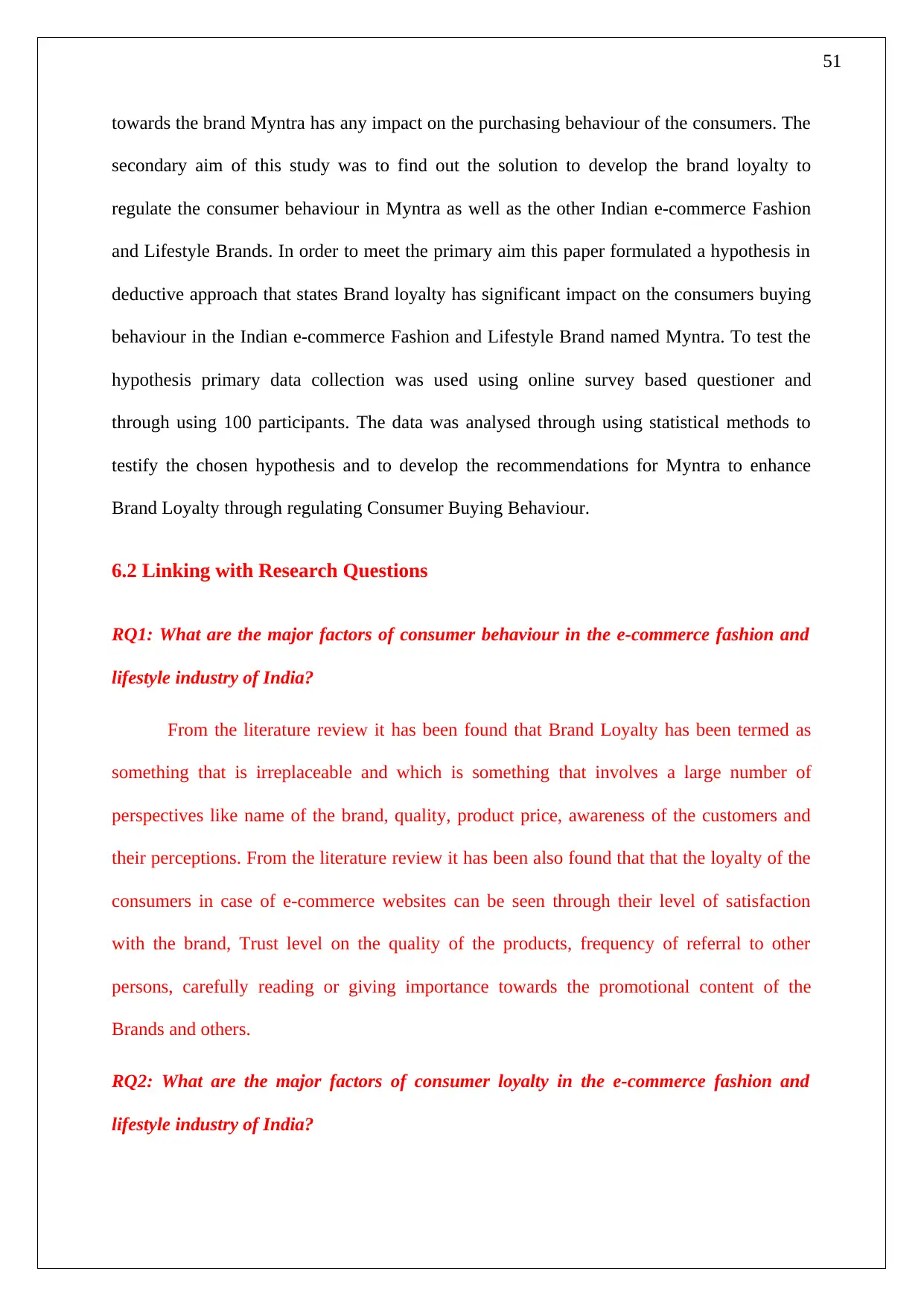
51
towards the brand Myntra has any impact on the purchasing behaviour of the consumers. The
secondary aim of this study was to find out the solution to develop the brand loyalty to
regulate the consumer behaviour in Myntra as well as the other Indian e-commerce Fashion
and Lifestyle Brands. In order to meet the primary aim this paper formulated a hypothesis in
deductive approach that states Brand loyalty has significant impact on the consumers buying
behaviour in the Indian e-commerce Fashion and Lifestyle Brand named Myntra. To test the
hypothesis primary data collection was used using online survey based questioner and
through using 100 participants. The data was analysed through using statistical methods to
testify the chosen hypothesis and to develop the recommendations for Myntra to enhance
Brand Loyalty through regulating Consumer Buying Behaviour.
6.2 Linking with Research Questions
RQ1: What are the major factors of consumer behaviour in the e-commerce fashion and
lifestyle industry of India?
From the literature review it has been found that Brand Loyalty has been termed as
something that is irreplaceable and which is something that involves a large number of
perspectives like name of the brand, quality, product price, awareness of the customers and
their perceptions. From the literature review it has been also found that that the loyalty of the
consumers in case of e-commerce websites can be seen through their level of satisfaction
with the brand, Trust level on the quality of the products, frequency of referral to other
persons, carefully reading or giving importance towards the promotional content of the
Brands and others.
RQ2: What are the major factors of consumer loyalty in the e-commerce fashion and
lifestyle industry of India?
towards the brand Myntra has any impact on the purchasing behaviour of the consumers. The
secondary aim of this study was to find out the solution to develop the brand loyalty to
regulate the consumer behaviour in Myntra as well as the other Indian e-commerce Fashion
and Lifestyle Brands. In order to meet the primary aim this paper formulated a hypothesis in
deductive approach that states Brand loyalty has significant impact on the consumers buying
behaviour in the Indian e-commerce Fashion and Lifestyle Brand named Myntra. To test the
hypothesis primary data collection was used using online survey based questioner and
through using 100 participants. The data was analysed through using statistical methods to
testify the chosen hypothesis and to develop the recommendations for Myntra to enhance
Brand Loyalty through regulating Consumer Buying Behaviour.
6.2 Linking with Research Questions
RQ1: What are the major factors of consumer behaviour in the e-commerce fashion and
lifestyle industry of India?
From the literature review it has been found that Brand Loyalty has been termed as
something that is irreplaceable and which is something that involves a large number of
perspectives like name of the brand, quality, product price, awareness of the customers and
their perceptions. From the literature review it has been also found that that the loyalty of the
consumers in case of e-commerce websites can be seen through their level of satisfaction
with the brand, Trust level on the quality of the products, frequency of referral to other
persons, carefully reading or giving importance towards the promotional content of the
Brands and others.
RQ2: What are the major factors of consumer loyalty in the e-commerce fashion and
lifestyle industry of India?
Secure Best Marks with AI Grader
Need help grading? Try our AI Grader for instant feedback on your assignments.
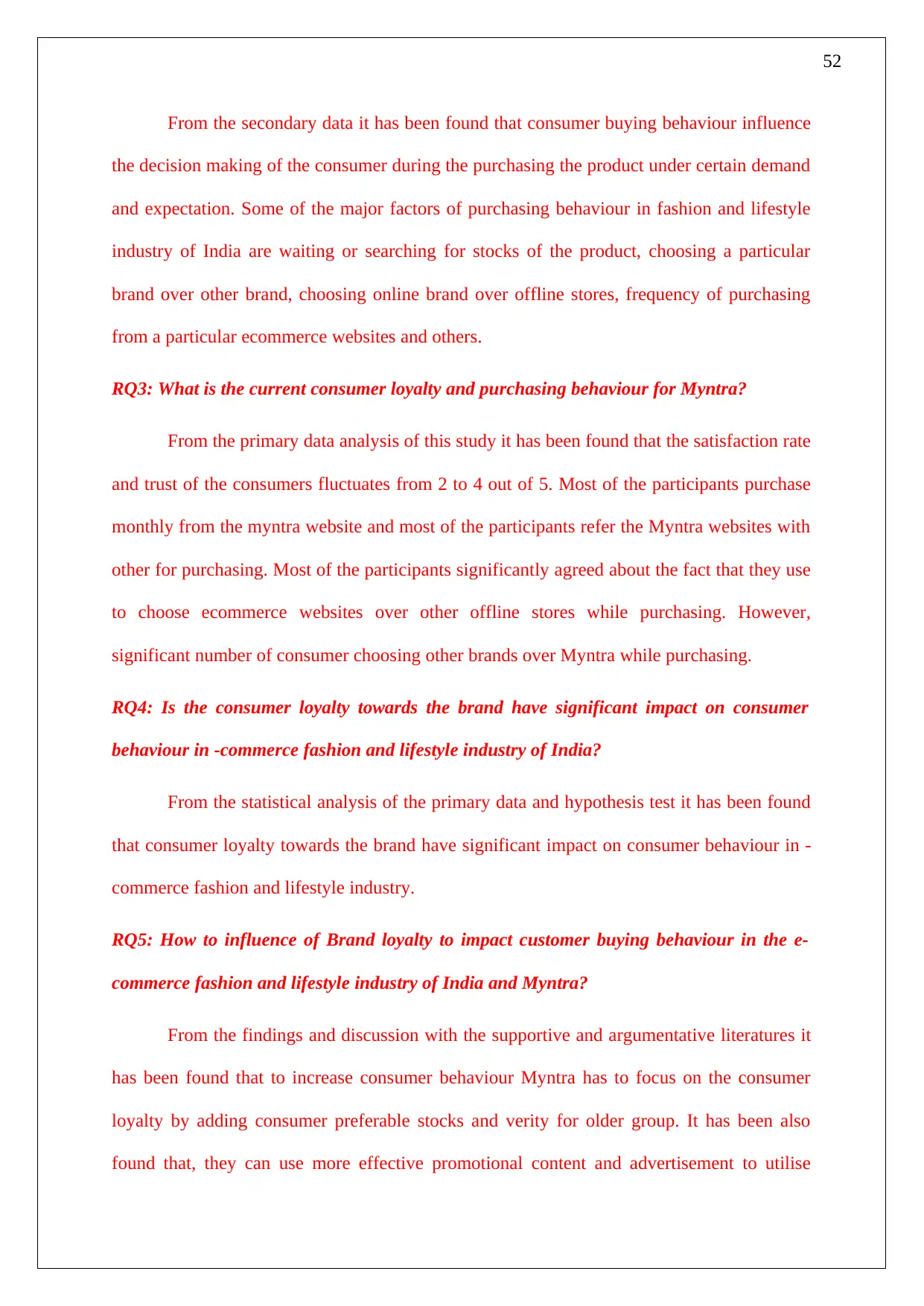
52
From the secondary data it has been found that consumer buying behaviour influence
the decision making of the consumer during the purchasing the product under certain demand
and expectation. Some of the major factors of purchasing behaviour in fashion and lifestyle
industry of India are waiting or searching for stocks of the product, choosing a particular
brand over other brand, choosing online brand over offline stores, frequency of purchasing
from a particular ecommerce websites and others.
RQ3: What is the current consumer loyalty and purchasing behaviour for Myntra?
From the primary data analysis of this study it has been found that the satisfaction rate
and trust of the consumers fluctuates from 2 to 4 out of 5. Most of the participants purchase
monthly from the myntra website and most of the participants refer the Myntra websites with
other for purchasing. Most of the participants significantly agreed about the fact that they use
to choose ecommerce websites over other offline stores while purchasing. However,
significant number of consumer choosing other brands over Myntra while purchasing.
RQ4: Is the consumer loyalty towards the brand have significant impact on consumer
behaviour in -commerce fashion and lifestyle industry of India?
From the statistical analysis of the primary data and hypothesis test it has been found
that consumer loyalty towards the brand have significant impact on consumer behaviour in -
commerce fashion and lifestyle industry.
RQ5: How to influence of Brand loyalty to impact customer buying behaviour in the e-
commerce fashion and lifestyle industry of India and Myntra?
From the findings and discussion with the supportive and argumentative literatures it
has been found that to increase consumer behaviour Myntra has to focus on the consumer
loyalty by adding consumer preferable stocks and verity for older group. It has been also
found that, they can use more effective promotional content and advertisement to utilise
From the secondary data it has been found that consumer buying behaviour influence
the decision making of the consumer during the purchasing the product under certain demand
and expectation. Some of the major factors of purchasing behaviour in fashion and lifestyle
industry of India are waiting or searching for stocks of the product, choosing a particular
brand over other brand, choosing online brand over offline stores, frequency of purchasing
from a particular ecommerce websites and others.
RQ3: What is the current consumer loyalty and purchasing behaviour for Myntra?
From the primary data analysis of this study it has been found that the satisfaction rate
and trust of the consumers fluctuates from 2 to 4 out of 5. Most of the participants purchase
monthly from the myntra website and most of the participants refer the Myntra websites with
other for purchasing. Most of the participants significantly agreed about the fact that they use
to choose ecommerce websites over other offline stores while purchasing. However,
significant number of consumer choosing other brands over Myntra while purchasing.
RQ4: Is the consumer loyalty towards the brand have significant impact on consumer
behaviour in -commerce fashion and lifestyle industry of India?
From the statistical analysis of the primary data and hypothesis test it has been found
that consumer loyalty towards the brand have significant impact on consumer behaviour in -
commerce fashion and lifestyle industry.
RQ5: How to influence of Brand loyalty to impact customer buying behaviour in the e-
commerce fashion and lifestyle industry of India and Myntra?
From the findings and discussion with the supportive and argumentative literatures it
has been found that to increase consumer behaviour Myntra has to focus on the consumer
loyalty by adding consumer preferable stocks and verity for older group. It has been also
found that, they can use more effective promotional content and advertisement to utilise
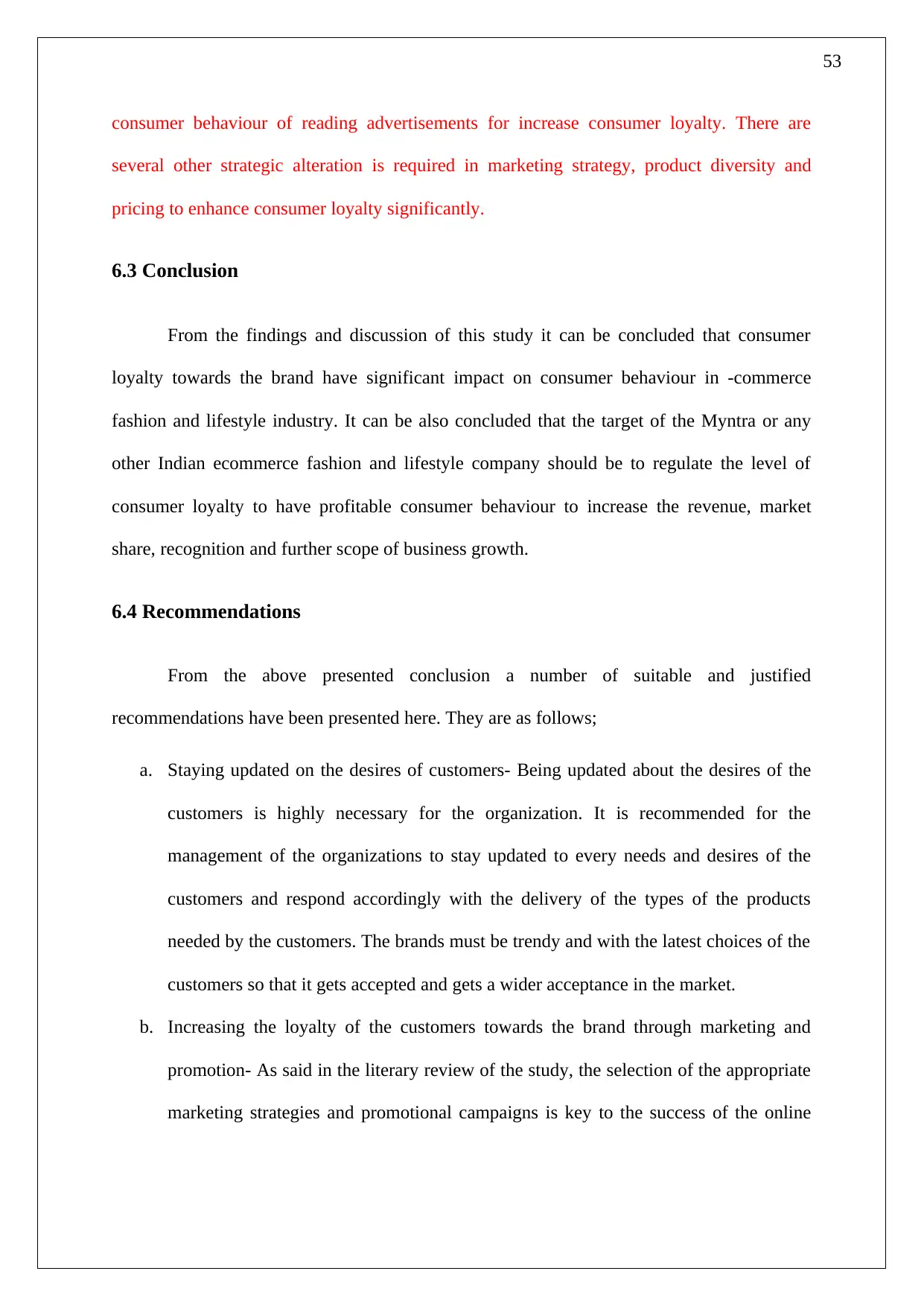
53
consumer behaviour of reading advertisements for increase consumer loyalty. There are
several other strategic alteration is required in marketing strategy, product diversity and
pricing to enhance consumer loyalty significantly.
6.3 Conclusion
From the findings and discussion of this study it can be concluded that consumer
loyalty towards the brand have significant impact on consumer behaviour in -commerce
fashion and lifestyle industry. It can be also concluded that the target of the Myntra or any
other Indian ecommerce fashion and lifestyle company should be to regulate the level of
consumer loyalty to have profitable consumer behaviour to increase the revenue, market
share, recognition and further scope of business growth.
6.4 Recommendations
From the above presented conclusion a number of suitable and justified
recommendations have been presented here. They are as follows;
a. Staying updated on the desires of customers- Being updated about the desires of the
customers is highly necessary for the organization. It is recommended for the
management of the organizations to stay updated to every needs and desires of the
customers and respond accordingly with the delivery of the types of the products
needed by the customers. The brands must be trendy and with the latest choices of the
customers so that it gets accepted and gets a wider acceptance in the market.
b. Increasing the loyalty of the customers towards the brand through marketing and
promotion- As said in the literary review of the study, the selection of the appropriate
marketing strategies and promotional campaigns is key to the success of the online
consumer behaviour of reading advertisements for increase consumer loyalty. There are
several other strategic alteration is required in marketing strategy, product diversity and
pricing to enhance consumer loyalty significantly.
6.3 Conclusion
From the findings and discussion of this study it can be concluded that consumer
loyalty towards the brand have significant impact on consumer behaviour in -commerce
fashion and lifestyle industry. It can be also concluded that the target of the Myntra or any
other Indian ecommerce fashion and lifestyle company should be to regulate the level of
consumer loyalty to have profitable consumer behaviour to increase the revenue, market
share, recognition and further scope of business growth.
6.4 Recommendations
From the above presented conclusion a number of suitable and justified
recommendations have been presented here. They are as follows;
a. Staying updated on the desires of customers- Being updated about the desires of the
customers is highly necessary for the organization. It is recommended for the
management of the organizations to stay updated to every needs and desires of the
customers and respond accordingly with the delivery of the types of the products
needed by the customers. The brands must be trendy and with the latest choices of the
customers so that it gets accepted and gets a wider acceptance in the market.
b. Increasing the loyalty of the customers towards the brand through marketing and
promotion- As said in the literary review of the study, the selection of the appropriate
marketing strategies and promotional campaigns is key to the success of the online
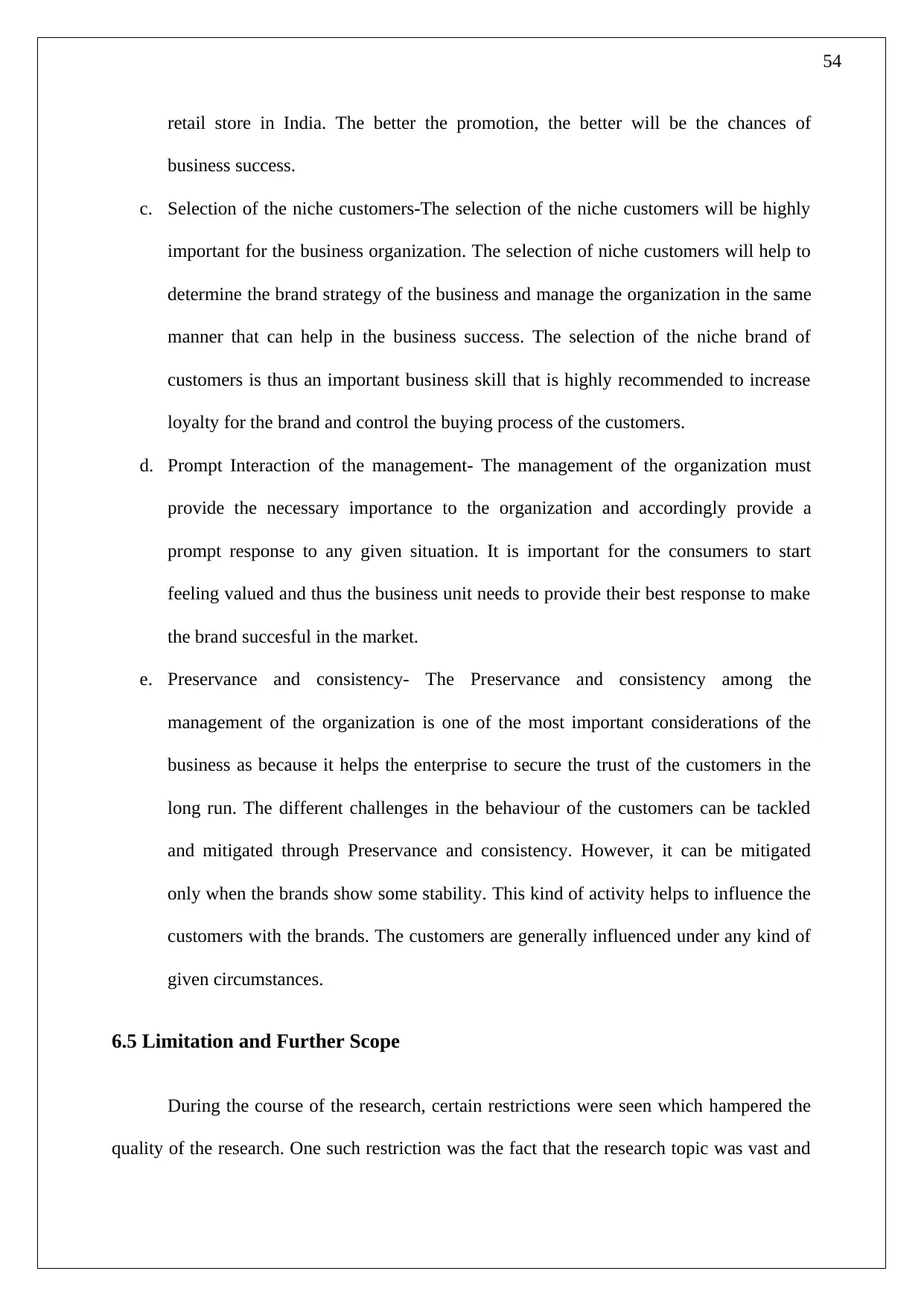
54
retail store in India. The better the promotion, the better will be the chances of
business success.
c. Selection of the niche customers-The selection of the niche customers will be highly
important for the business organization. The selection of niche customers will help to
determine the brand strategy of the business and manage the organization in the same
manner that can help in the business success. The selection of the niche brand of
customers is thus an important business skill that is highly recommended to increase
loyalty for the brand and control the buying process of the customers.
d. Prompt Interaction of the management- The management of the organization must
provide the necessary importance to the organization and accordingly provide a
prompt response to any given situation. It is important for the consumers to start
feeling valued and thus the business unit needs to provide their best response to make
the brand succesful in the market.
e. Preservance and consistency- The Preservance and consistency among the
management of the organization is one of the most important considerations of the
business as because it helps the enterprise to secure the trust of the customers in the
long run. The different challenges in the behaviour of the customers can be tackled
and mitigated through Preservance and consistency. However, it can be mitigated
only when the brands show some stability. This kind of activity helps to influence the
customers with the brands. The customers are generally influenced under any kind of
given circumstances.
6.5 Limitation and Further Scope
During the course of the research, certain restrictions were seen which hampered the
quality of the research. One such restriction was the fact that the research topic was vast and
retail store in India. The better the promotion, the better will be the chances of
business success.
c. Selection of the niche customers-The selection of the niche customers will be highly
important for the business organization. The selection of niche customers will help to
determine the brand strategy of the business and manage the organization in the same
manner that can help in the business success. The selection of the niche brand of
customers is thus an important business skill that is highly recommended to increase
loyalty for the brand and control the buying process of the customers.
d. Prompt Interaction of the management- The management of the organization must
provide the necessary importance to the organization and accordingly provide a
prompt response to any given situation. It is important for the consumers to start
feeling valued and thus the business unit needs to provide their best response to make
the brand succesful in the market.
e. Preservance and consistency- The Preservance and consistency among the
management of the organization is one of the most important considerations of the
business as because it helps the enterprise to secure the trust of the customers in the
long run. The different challenges in the behaviour of the customers can be tackled
and mitigated through Preservance and consistency. However, it can be mitigated
only when the brands show some stability. This kind of activity helps to influence the
customers with the brands. The customers are generally influenced under any kind of
given circumstances.
6.5 Limitation and Further Scope
During the course of the research, certain restrictions were seen which hampered the
quality of the research. One such restriction was the fact that the research topic was vast and
Paraphrase This Document
Need a fresh take? Get an instant paraphrase of this document with our AI Paraphraser
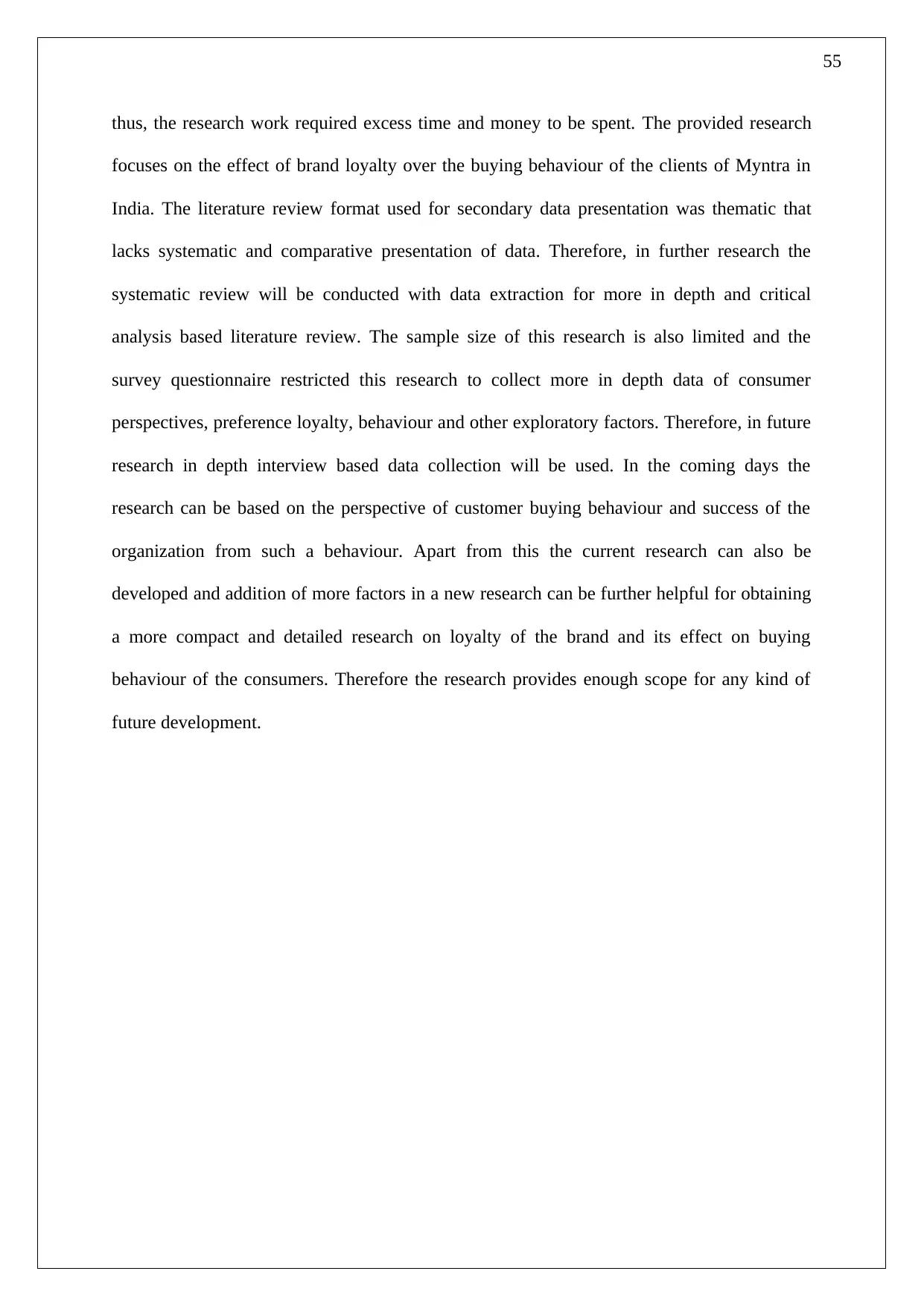
55
thus, the research work required excess time and money to be spent. The provided research
focuses on the effect of brand loyalty over the buying behaviour of the clients of Myntra in
India. The literature review format used for secondary data presentation was thematic that
lacks systematic and comparative presentation of data. Therefore, in further research the
systematic review will be conducted with data extraction for more in depth and critical
analysis based literature review. The sample size of this research is also limited and the
survey questionnaire restricted this research to collect more in depth data of consumer
perspectives, preference loyalty, behaviour and other exploratory factors. Therefore, in future
research in depth interview based data collection will be used. In the coming days the
research can be based on the perspective of customer buying behaviour and success of the
organization from such a behaviour. Apart from this the current research can also be
developed and addition of more factors in a new research can be further helpful for obtaining
a more compact and detailed research on loyalty of the brand and its effect on buying
behaviour of the consumers. Therefore the research provides enough scope for any kind of
future development.
thus, the research work required excess time and money to be spent. The provided research
focuses on the effect of brand loyalty over the buying behaviour of the clients of Myntra in
India. The literature review format used for secondary data presentation was thematic that
lacks systematic and comparative presentation of data. Therefore, in further research the
systematic review will be conducted with data extraction for more in depth and critical
analysis based literature review. The sample size of this research is also limited and the
survey questionnaire restricted this research to collect more in depth data of consumer
perspectives, preference loyalty, behaviour and other exploratory factors. Therefore, in future
research in depth interview based data collection will be used. In the coming days the
research can be based on the perspective of customer buying behaviour and success of the
organization from such a behaviour. Apart from this the current research can also be
developed and addition of more factors in a new research can be further helpful for obtaining
a more compact and detailed research on loyalty of the brand and its effect on buying
behaviour of the consumers. Therefore the research provides enough scope for any kind of
future development.
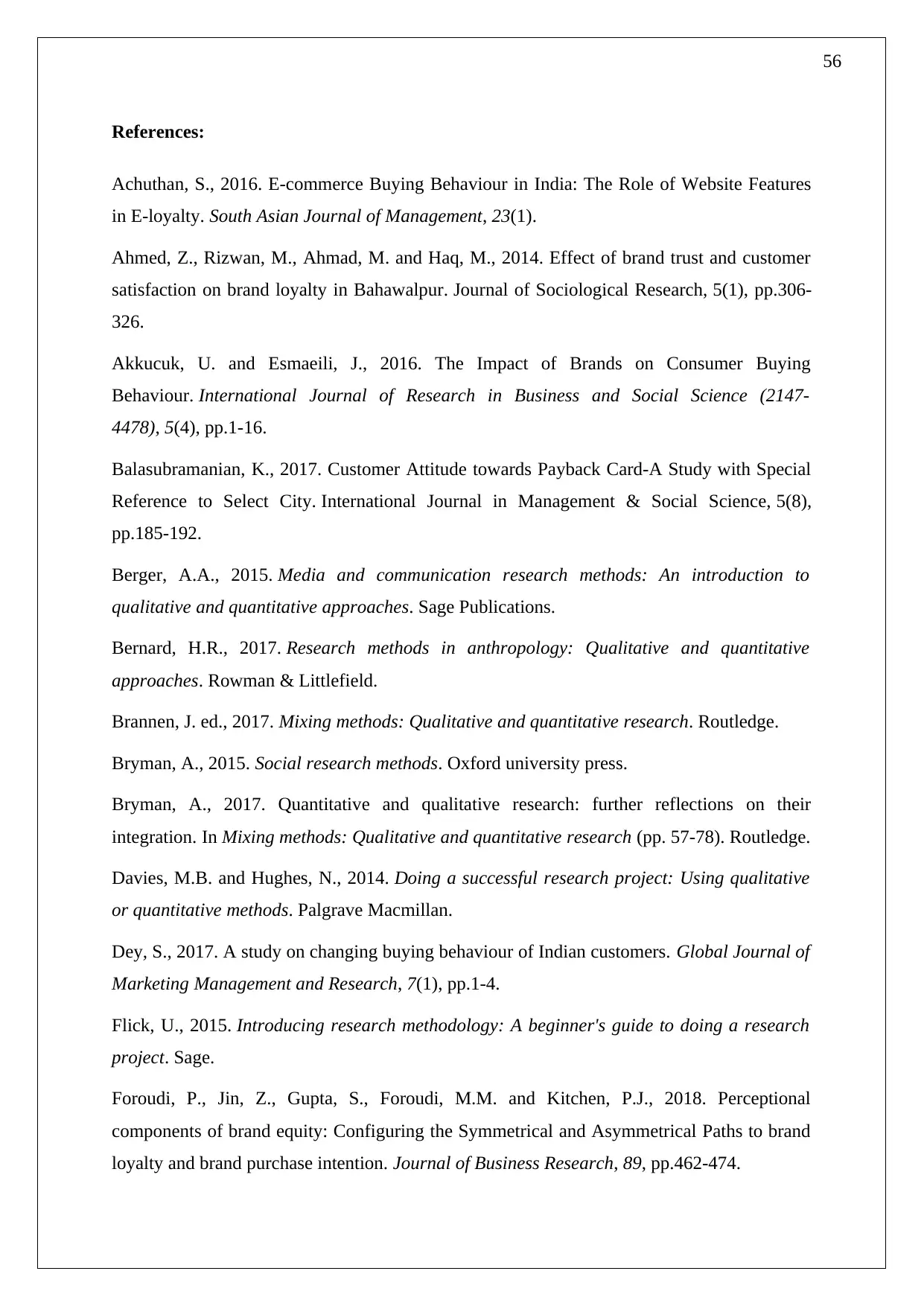
56
References:
Achuthan, S., 2016. E-commerce Buying Behaviour in India: The Role of Website Features
in E-loyalty. South Asian Journal of Management, 23(1).
Ahmed, Z., Rizwan, M., Ahmad, M. and Haq, M., 2014. Effect of brand trust and customer
satisfaction on brand loyalty in Bahawalpur. Journal of Sociological Research, 5(1), pp.306-
326.
Akkucuk, U. and Esmaeili, J., 2016. The Impact of Brands on Consumer Buying
Behaviour. International Journal of Research in Business and Social Science (2147-
4478), 5(4), pp.1-16.
Balasubramanian, K., 2017. Customer Attitude towards Payback Card-A Study with Special
Reference to Select City. International Journal in Management & Social Science, 5(8),
pp.185-192.
Berger, A.A., 2015. Media and communication research methods: An introduction to
qualitative and quantitative approaches. Sage Publications.
Bernard, H.R., 2017. Research methods in anthropology: Qualitative and quantitative
approaches. Rowman & Littlefield.
Brannen, J. ed., 2017. Mixing methods: Qualitative and quantitative research. Routledge.
Bryman, A., 2015. Social research methods. Oxford university press.
Bryman, A., 2017. Quantitative and qualitative research: further reflections on their
integration. In Mixing methods: Qualitative and quantitative research (pp. 57-78). Routledge.
Davies, M.B. and Hughes, N., 2014. Doing a successful research project: Using qualitative
or quantitative methods. Palgrave Macmillan.
Dey, S., 2017. A study on changing buying behaviour of Indian customers. Global Journal of
Marketing Management and Research, 7(1), pp.1-4.
Flick, U., 2015. Introducing research methodology: A beginner's guide to doing a research
project. Sage.
Foroudi, P., Jin, Z., Gupta, S., Foroudi, M.M. and Kitchen, P.J., 2018. Perceptional
components of brand equity: Configuring the Symmetrical and Asymmetrical Paths to brand
loyalty and brand purchase intention. Journal of Business Research, 89, pp.462-474.
References:
Achuthan, S., 2016. E-commerce Buying Behaviour in India: The Role of Website Features
in E-loyalty. South Asian Journal of Management, 23(1).
Ahmed, Z., Rizwan, M., Ahmad, M. and Haq, M., 2014. Effect of brand trust and customer
satisfaction on brand loyalty in Bahawalpur. Journal of Sociological Research, 5(1), pp.306-
326.
Akkucuk, U. and Esmaeili, J., 2016. The Impact of Brands on Consumer Buying
Behaviour. International Journal of Research in Business and Social Science (2147-
4478), 5(4), pp.1-16.
Balasubramanian, K., 2017. Customer Attitude towards Payback Card-A Study with Special
Reference to Select City. International Journal in Management & Social Science, 5(8),
pp.185-192.
Berger, A.A., 2015. Media and communication research methods: An introduction to
qualitative and quantitative approaches. Sage Publications.
Bernard, H.R., 2017. Research methods in anthropology: Qualitative and quantitative
approaches. Rowman & Littlefield.
Brannen, J. ed., 2017. Mixing methods: Qualitative and quantitative research. Routledge.
Bryman, A., 2015. Social research methods. Oxford university press.
Bryman, A., 2017. Quantitative and qualitative research: further reflections on their
integration. In Mixing methods: Qualitative and quantitative research (pp. 57-78). Routledge.
Davies, M.B. and Hughes, N., 2014. Doing a successful research project: Using qualitative
or quantitative methods. Palgrave Macmillan.
Dey, S., 2017. A study on changing buying behaviour of Indian customers. Global Journal of
Marketing Management and Research, 7(1), pp.1-4.
Flick, U., 2015. Introducing research methodology: A beginner's guide to doing a research
project. Sage.
Foroudi, P., Jin, Z., Gupta, S., Foroudi, M.M. and Kitchen, P.J., 2018. Perceptional
components of brand equity: Configuring the Symmetrical and Asymmetrical Paths to brand
loyalty and brand purchase intention. Journal of Business Research, 89, pp.462-474.
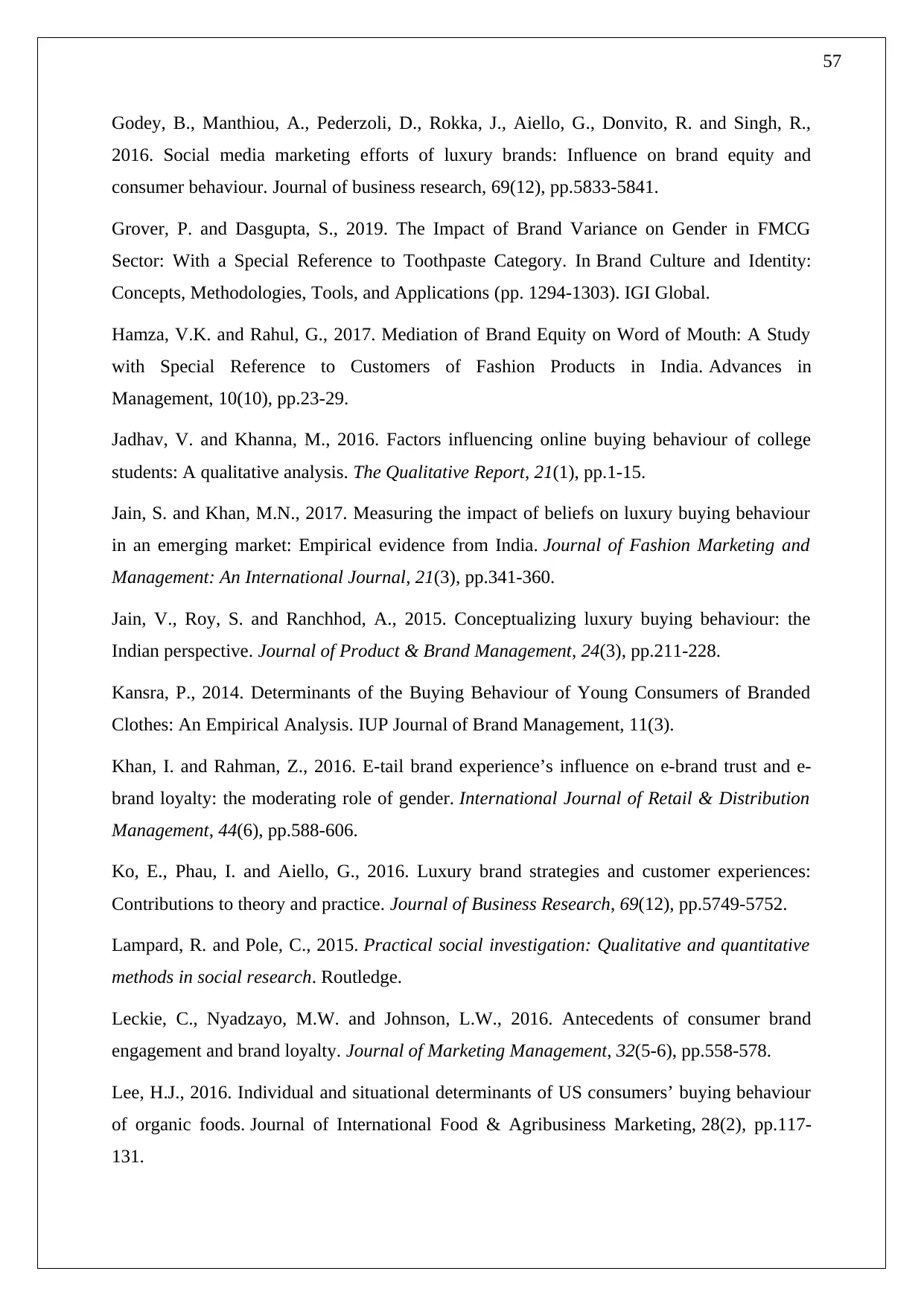
57
Godey, B., Manthiou, A., Pederzoli, D., Rokka, J., Aiello, G., Donvito, R. and Singh, R.,
2016. Social media marketing efforts of luxury brands: Influence on brand equity and
consumer behaviour. Journal of business research, 69(12), pp.5833-5841.
Grover, P. and Dasgupta, S., 2019. The Impact of Brand Variance on Gender in FMCG
Sector: With a Special Reference to Toothpaste Category. In Brand Culture and Identity:
Concepts, Methodologies, Tools, and Applications (pp. 1294-1303). IGI Global.
Hamza, V.K. and Rahul, G., 2017. Mediation of Brand Equity on Word of Mouth: A Study
with Special Reference to Customers of Fashion Products in India. Advances in
Management, 10(10), pp.23-29.
Jadhav, V. and Khanna, M., 2016. Factors influencing online buying behaviour of college
students: A qualitative analysis. The Qualitative Report, 21(1), pp.1-15.
Jain, S. and Khan, M.N., 2017. Measuring the impact of beliefs on luxury buying behaviour
in an emerging market: Empirical evidence from India. Journal of Fashion Marketing and
Management: An International Journal, 21(3), pp.341-360.
Jain, V., Roy, S. and Ranchhod, A., 2015. Conceptualizing luxury buying behaviour: the
Indian perspective. Journal of Product & Brand Management, 24(3), pp.211-228.
Kansra, P., 2014. Determinants of the Buying Behaviour of Young Consumers of Branded
Clothes: An Empirical Analysis. IUP Journal of Brand Management, 11(3).
Khan, I. and Rahman, Z., 2016. E-tail brand experience’s influence on e-brand trust and e-
brand loyalty: the moderating role of gender. International Journal of Retail & Distribution
Management, 44(6), pp.588-606.
Ko, E., Phau, I. and Aiello, G., 2016. Luxury brand strategies and customer experiences:
Contributions to theory and practice. Journal of Business Research, 69(12), pp.5749-5752.
Lampard, R. and Pole, C., 2015. Practical social investigation: Qualitative and quantitative
methods in social research. Routledge.
Leckie, C., Nyadzayo, M.W. and Johnson, L.W., 2016. Antecedents of consumer brand
engagement and brand loyalty. Journal of Marketing Management, 32(5-6), pp.558-578.
Lee, H.J., 2016. Individual and situational determinants of US consumers’ buying behaviour
of organic foods. Journal of International Food & Agribusiness Marketing, 28(2), pp.117-
131.
Godey, B., Manthiou, A., Pederzoli, D., Rokka, J., Aiello, G., Donvito, R. and Singh, R.,
2016. Social media marketing efforts of luxury brands: Influence on brand equity and
consumer behaviour. Journal of business research, 69(12), pp.5833-5841.
Grover, P. and Dasgupta, S., 2019. The Impact of Brand Variance on Gender in FMCG
Sector: With a Special Reference to Toothpaste Category. In Brand Culture and Identity:
Concepts, Methodologies, Tools, and Applications (pp. 1294-1303). IGI Global.
Hamza, V.K. and Rahul, G., 2017. Mediation of Brand Equity on Word of Mouth: A Study
with Special Reference to Customers of Fashion Products in India. Advances in
Management, 10(10), pp.23-29.
Jadhav, V. and Khanna, M., 2016. Factors influencing online buying behaviour of college
students: A qualitative analysis. The Qualitative Report, 21(1), pp.1-15.
Jain, S. and Khan, M.N., 2017. Measuring the impact of beliefs on luxury buying behaviour
in an emerging market: Empirical evidence from India. Journal of Fashion Marketing and
Management: An International Journal, 21(3), pp.341-360.
Jain, V., Roy, S. and Ranchhod, A., 2015. Conceptualizing luxury buying behaviour: the
Indian perspective. Journal of Product & Brand Management, 24(3), pp.211-228.
Kansra, P., 2014. Determinants of the Buying Behaviour of Young Consumers of Branded
Clothes: An Empirical Analysis. IUP Journal of Brand Management, 11(3).
Khan, I. and Rahman, Z., 2016. E-tail brand experience’s influence on e-brand trust and e-
brand loyalty: the moderating role of gender. International Journal of Retail & Distribution
Management, 44(6), pp.588-606.
Ko, E., Phau, I. and Aiello, G., 2016. Luxury brand strategies and customer experiences:
Contributions to theory and practice. Journal of Business Research, 69(12), pp.5749-5752.
Lampard, R. and Pole, C., 2015. Practical social investigation: Qualitative and quantitative
methods in social research. Routledge.
Leckie, C., Nyadzayo, M.W. and Johnson, L.W., 2016. Antecedents of consumer brand
engagement and brand loyalty. Journal of Marketing Management, 32(5-6), pp.558-578.
Lee, H.J., 2016. Individual and situational determinants of US consumers’ buying behaviour
of organic foods. Journal of International Food & Agribusiness Marketing, 28(2), pp.117-
131.
Secure Best Marks with AI Grader
Need help grading? Try our AI Grader for instant feedback on your assignments.
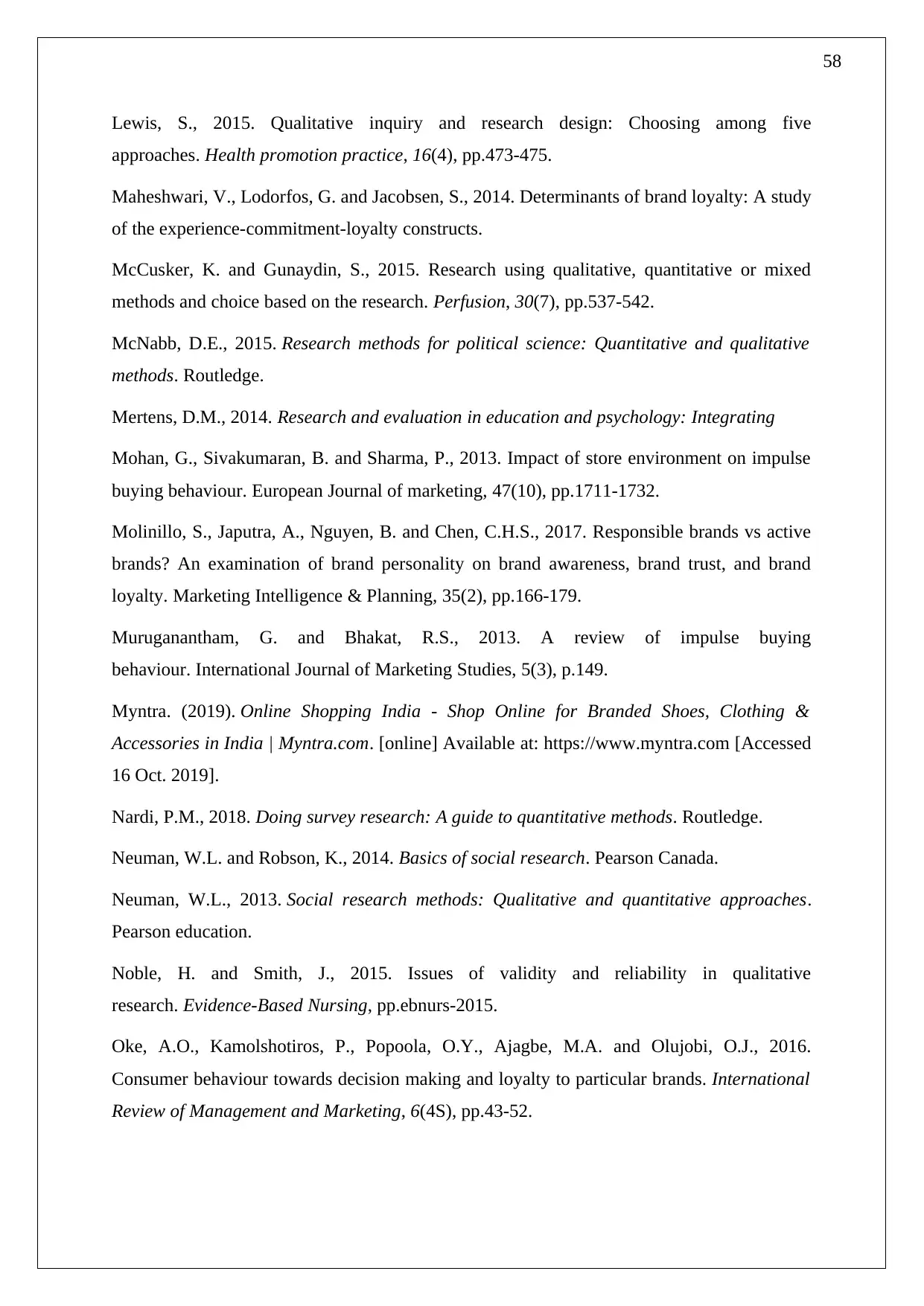
58
Lewis, S., 2015. Qualitative inquiry and research design: Choosing among five
approaches. Health promotion practice, 16(4), pp.473-475.
Maheshwari, V., Lodorfos, G. and Jacobsen, S., 2014. Determinants of brand loyalty: A study
of the experience-commitment-loyalty constructs.
McCusker, K. and Gunaydin, S., 2015. Research using qualitative, quantitative or mixed
methods and choice based on the research. Perfusion, 30(7), pp.537-542.
McNabb, D.E., 2015. Research methods for political science: Quantitative and qualitative
methods. Routledge.
Mertens, D.M., 2014. Research and evaluation in education and psychology: Integrating
Mohan, G., Sivakumaran, B. and Sharma, P., 2013. Impact of store environment on impulse
buying behaviour. European Journal of marketing, 47(10), pp.1711-1732.
Molinillo, S., Japutra, A., Nguyen, B. and Chen, C.H.S., 2017. Responsible brands vs active
brands? An examination of brand personality on brand awareness, brand trust, and brand
loyalty. Marketing Intelligence & Planning, 35(2), pp.166-179.
Muruganantham, G. and Bhakat, R.S., 2013. A review of impulse buying
behaviour. International Journal of Marketing Studies, 5(3), p.149.
Myntra. (2019). Online Shopping India - Shop Online for Branded Shoes, Clothing &
Accessories in India | Myntra.com. [online] Available at: https://www.myntra.com [Accessed
16 Oct. 2019].
Nardi, P.M., 2018. Doing survey research: A guide to quantitative methods. Routledge.
Neuman, W.L. and Robson, K., 2014. Basics of social research. Pearson Canada.
Neuman, W.L., 2013. Social research methods: Qualitative and quantitative approaches.
Pearson education.
Noble, H. and Smith, J., 2015. Issues of validity and reliability in qualitative
research. Evidence-Based Nursing, pp.ebnurs-2015.
Oke, A.O., Kamolshotiros, P., Popoola, O.Y., Ajagbe, M.A. and Olujobi, O.J., 2016.
Consumer behaviour towards decision making and loyalty to particular brands. International
Review of Management and Marketing, 6(4S), pp.43-52.
Lewis, S., 2015. Qualitative inquiry and research design: Choosing among five
approaches. Health promotion practice, 16(4), pp.473-475.
Maheshwari, V., Lodorfos, G. and Jacobsen, S., 2014. Determinants of brand loyalty: A study
of the experience-commitment-loyalty constructs.
McCusker, K. and Gunaydin, S., 2015. Research using qualitative, quantitative or mixed
methods and choice based on the research. Perfusion, 30(7), pp.537-542.
McNabb, D.E., 2015. Research methods for political science: Quantitative and qualitative
methods. Routledge.
Mertens, D.M., 2014. Research and evaluation in education and psychology: Integrating
Mohan, G., Sivakumaran, B. and Sharma, P., 2013. Impact of store environment on impulse
buying behaviour. European Journal of marketing, 47(10), pp.1711-1732.
Molinillo, S., Japutra, A., Nguyen, B. and Chen, C.H.S., 2017. Responsible brands vs active
brands? An examination of brand personality on brand awareness, brand trust, and brand
loyalty. Marketing Intelligence & Planning, 35(2), pp.166-179.
Muruganantham, G. and Bhakat, R.S., 2013. A review of impulse buying
behaviour. International Journal of Marketing Studies, 5(3), p.149.
Myntra. (2019). Online Shopping India - Shop Online for Branded Shoes, Clothing &
Accessories in India | Myntra.com. [online] Available at: https://www.myntra.com [Accessed
16 Oct. 2019].
Nardi, P.M., 2018. Doing survey research: A guide to quantitative methods. Routledge.
Neuman, W.L. and Robson, K., 2014. Basics of social research. Pearson Canada.
Neuman, W.L., 2013. Social research methods: Qualitative and quantitative approaches.
Pearson education.
Noble, H. and Smith, J., 2015. Issues of validity and reliability in qualitative
research. Evidence-Based Nursing, pp.ebnurs-2015.
Oke, A.O., Kamolshotiros, P., Popoola, O.Y., Ajagbe, M.A. and Olujobi, O.J., 2016.
Consumer behaviour towards decision making and loyalty to particular brands. International
Review of Management and Marketing, 6(4S), pp.43-52.

59
Ong, C.H., Lee, H.W. and Ramayah, T., 2018. Impact of brand experience on
loyalty. Journal of Hospitality Marketing & Management, 27(7), pp.755-774.
Ordun, G., 2015. Millennial (Gen Y) consumer behaviour their shopping preferences and
perceptual maps associated with brand loyalty. Canadian Social Science, 11(4), pp.40-55.
Panneerselvam, R., 2014. Research methodology. PHI Learning Pvt. Ltd..
Papista, E., Chrysochou, P., Krystallis, A. and Dimitriadis, S., 2018. Types of value and cost
in consumer–green brands relationship and loyalty behaviour. Journal of Consumer
Behaviour, 17(1), pp.e101-e113.
Pedeliento, G., Andreini, D., Bergamaschi, M. and Salo, J., 2016. Brand and product
attachment in an industrial context: The effects on brand loyalty. Industrial Marketing
Management, 53, pp.194-206.
Peters, A., de Haan, P. and Scholz, R.W., 2015. Understanding car-buying behaviour:
psychological determinants of energy efficiency and practical implications. International
Journal of Sustainable Transportation, 9(1), pp.59-72.
Raj, K. and Aithal, P.S., 2018. Literature Review of Impact of Branding on Base of the
Pyramid Markets with Special Reference to India. International Journal of Applied
Engineering and Management Letters (IJAEML), 2(1), pp.43-63.
Ramalingegowda, C. (2019). What is brand loyalty in e-commerce?. [online] YourStory.com.
Available at: https://yourstory.com/2014/06/e-commerce-loyalty [Accessed 2 Nov. 2019].
Ramanathan, U., Subramanian, N., Yu, W. and Vijaygopal, R., 2017. Impact of customer
loyalty and service operations on customer behaviour and firm performance: empirical
evidence from UK retail sector. Production Planning & Control, 28(6-8), pp.478-488.
Sasmita, J. and MohdSuki, N., 2015. Young consumers’ insights on brand equity: Effects of
brand association, brand loyalty, brand awareness, and brand image. International Journal of
Retail & Distribution Management, 43(3), pp.276-292.
Schivinski, B. and Dabrowski, D., 2015. The impact of brand communication on brand equity
through Facebook. Journal of Research in Interactive Marketing, 9(1), pp.31-53.
Shahid, Z., Hussain, T. and Zafar, F., 2017. The impact of brand awareness on the
consumers’ purchase intention. Journal of Marketing and Consumer Research, 33, pp.34-38.
Ong, C.H., Lee, H.W. and Ramayah, T., 2018. Impact of brand experience on
loyalty. Journal of Hospitality Marketing & Management, 27(7), pp.755-774.
Ordun, G., 2015. Millennial (Gen Y) consumer behaviour their shopping preferences and
perceptual maps associated with brand loyalty. Canadian Social Science, 11(4), pp.40-55.
Panneerselvam, R., 2014. Research methodology. PHI Learning Pvt. Ltd..
Papista, E., Chrysochou, P., Krystallis, A. and Dimitriadis, S., 2018. Types of value and cost
in consumer–green brands relationship and loyalty behaviour. Journal of Consumer
Behaviour, 17(1), pp.e101-e113.
Pedeliento, G., Andreini, D., Bergamaschi, M. and Salo, J., 2016. Brand and product
attachment in an industrial context: The effects on brand loyalty. Industrial Marketing
Management, 53, pp.194-206.
Peters, A., de Haan, P. and Scholz, R.W., 2015. Understanding car-buying behaviour:
psychological determinants of energy efficiency and practical implications. International
Journal of Sustainable Transportation, 9(1), pp.59-72.
Raj, K. and Aithal, P.S., 2018. Literature Review of Impact of Branding on Base of the
Pyramid Markets with Special Reference to India. International Journal of Applied
Engineering and Management Letters (IJAEML), 2(1), pp.43-63.
Ramalingegowda, C. (2019). What is brand loyalty in e-commerce?. [online] YourStory.com.
Available at: https://yourstory.com/2014/06/e-commerce-loyalty [Accessed 2 Nov. 2019].
Ramanathan, U., Subramanian, N., Yu, W. and Vijaygopal, R., 2017. Impact of customer
loyalty and service operations on customer behaviour and firm performance: empirical
evidence from UK retail sector. Production Planning & Control, 28(6-8), pp.478-488.
Sasmita, J. and MohdSuki, N., 2015. Young consumers’ insights on brand equity: Effects of
brand association, brand loyalty, brand awareness, and brand image. International Journal of
Retail & Distribution Management, 43(3), pp.276-292.
Schivinski, B. and Dabrowski, D., 2015. The impact of brand communication on brand equity
through Facebook. Journal of Research in Interactive Marketing, 9(1), pp.31-53.
Shahid, Z., Hussain, T. and Zafar, F., 2017. The impact of brand awareness on the
consumers’ purchase intention. Journal of Marketing and Consumer Research, 33, pp.34-38.
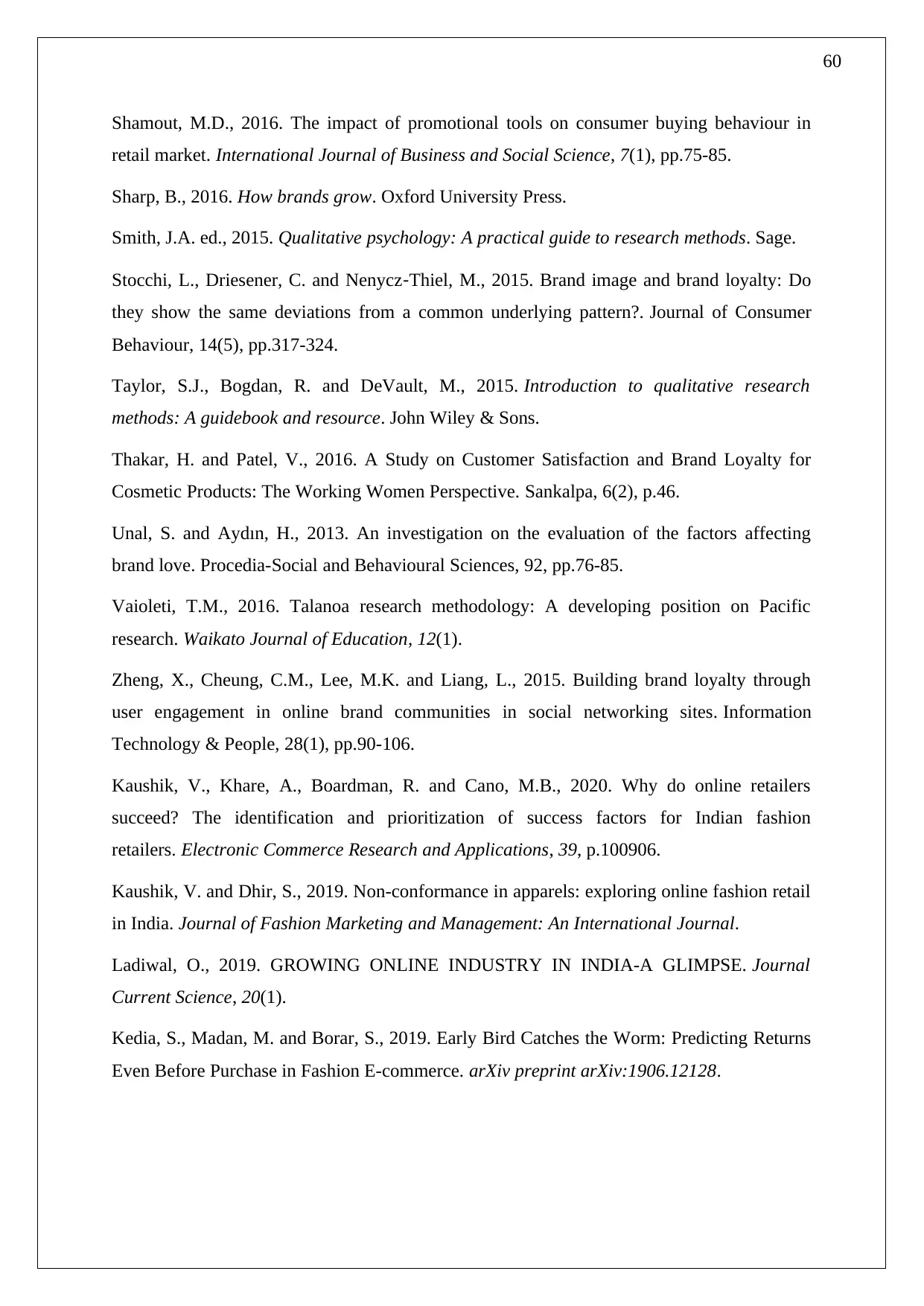
60
Shamout, M.D., 2016. The impact of promotional tools on consumer buying behaviour in
retail market. International Journal of Business and Social Science, 7(1), pp.75-85.
Sharp, B., 2016. How brands grow. Oxford University Press.
Smith, J.A. ed., 2015. Qualitative psychology: A practical guide to research methods. Sage.
Stocchi, L., Driesener, C. and Nenycz‐Thiel, M., 2015. Brand image and brand loyalty: Do
they show the same deviations from a common underlying pattern?. Journal of Consumer
Behaviour, 14(5), pp.317-324.
Taylor, S.J., Bogdan, R. and DeVault, M., 2015. Introduction to qualitative research
methods: A guidebook and resource. John Wiley & Sons.
Thakar, H. and Patel, V., 2016. A Study on Customer Satisfaction and Brand Loyalty for
Cosmetic Products: The Working Women Perspective. Sankalpa, 6(2), p.46.
Unal, S. and Aydın, H., 2013. An investigation on the evaluation of the factors affecting
brand love. Procedia-Social and Behavioural Sciences, 92, pp.76-85.
Vaioleti, T.M., 2016. Talanoa research methodology: A developing position on Pacific
research. Waikato Journal of Education, 12(1).
Zheng, X., Cheung, C.M., Lee, M.K. and Liang, L., 2015. Building brand loyalty through
user engagement in online brand communities in social networking sites. Information
Technology & People, 28(1), pp.90-106.
Kaushik, V., Khare, A., Boardman, R. and Cano, M.B., 2020. Why do online retailers
succeed? The identification and prioritization of success factors for Indian fashion
retailers. Electronic Commerce Research and Applications, 39, p.100906.
Kaushik, V. and Dhir, S., 2019. Non-conformance in apparels: exploring online fashion retail
in India. Journal of Fashion Marketing and Management: An International Journal.
Ladiwal, O., 2019. GROWING ONLINE INDUSTRY IN INDIA-A GLIMPSE. Journal
Current Science, 20(1).
Kedia, S., Madan, M. and Borar, S., 2019. Early Bird Catches the Worm: Predicting Returns
Even Before Purchase in Fashion E-commerce. arXiv preprint arXiv:1906.12128.
Shamout, M.D., 2016. The impact of promotional tools on consumer buying behaviour in
retail market. International Journal of Business and Social Science, 7(1), pp.75-85.
Sharp, B., 2016. How brands grow. Oxford University Press.
Smith, J.A. ed., 2015. Qualitative psychology: A practical guide to research methods. Sage.
Stocchi, L., Driesener, C. and Nenycz‐Thiel, M., 2015. Brand image and brand loyalty: Do
they show the same deviations from a common underlying pattern?. Journal of Consumer
Behaviour, 14(5), pp.317-324.
Taylor, S.J., Bogdan, R. and DeVault, M., 2015. Introduction to qualitative research
methods: A guidebook and resource. John Wiley & Sons.
Thakar, H. and Patel, V., 2016. A Study on Customer Satisfaction and Brand Loyalty for
Cosmetic Products: The Working Women Perspective. Sankalpa, 6(2), p.46.
Unal, S. and Aydın, H., 2013. An investigation on the evaluation of the factors affecting
brand love. Procedia-Social and Behavioural Sciences, 92, pp.76-85.
Vaioleti, T.M., 2016. Talanoa research methodology: A developing position on Pacific
research. Waikato Journal of Education, 12(1).
Zheng, X., Cheung, C.M., Lee, M.K. and Liang, L., 2015. Building brand loyalty through
user engagement in online brand communities in social networking sites. Information
Technology & People, 28(1), pp.90-106.
Kaushik, V., Khare, A., Boardman, R. and Cano, M.B., 2020. Why do online retailers
succeed? The identification and prioritization of success factors for Indian fashion
retailers. Electronic Commerce Research and Applications, 39, p.100906.
Kaushik, V. and Dhir, S., 2019. Non-conformance in apparels: exploring online fashion retail
in India. Journal of Fashion Marketing and Management: An International Journal.
Ladiwal, O., 2019. GROWING ONLINE INDUSTRY IN INDIA-A GLIMPSE. Journal
Current Science, 20(1).
Kedia, S., Madan, M. and Borar, S., 2019. Early Bird Catches the Worm: Predicting Returns
Even Before Purchase in Fashion E-commerce. arXiv preprint arXiv:1906.12128.
Paraphrase This Document
Need a fresh take? Get an instant paraphrase of this document with our AI Paraphraser
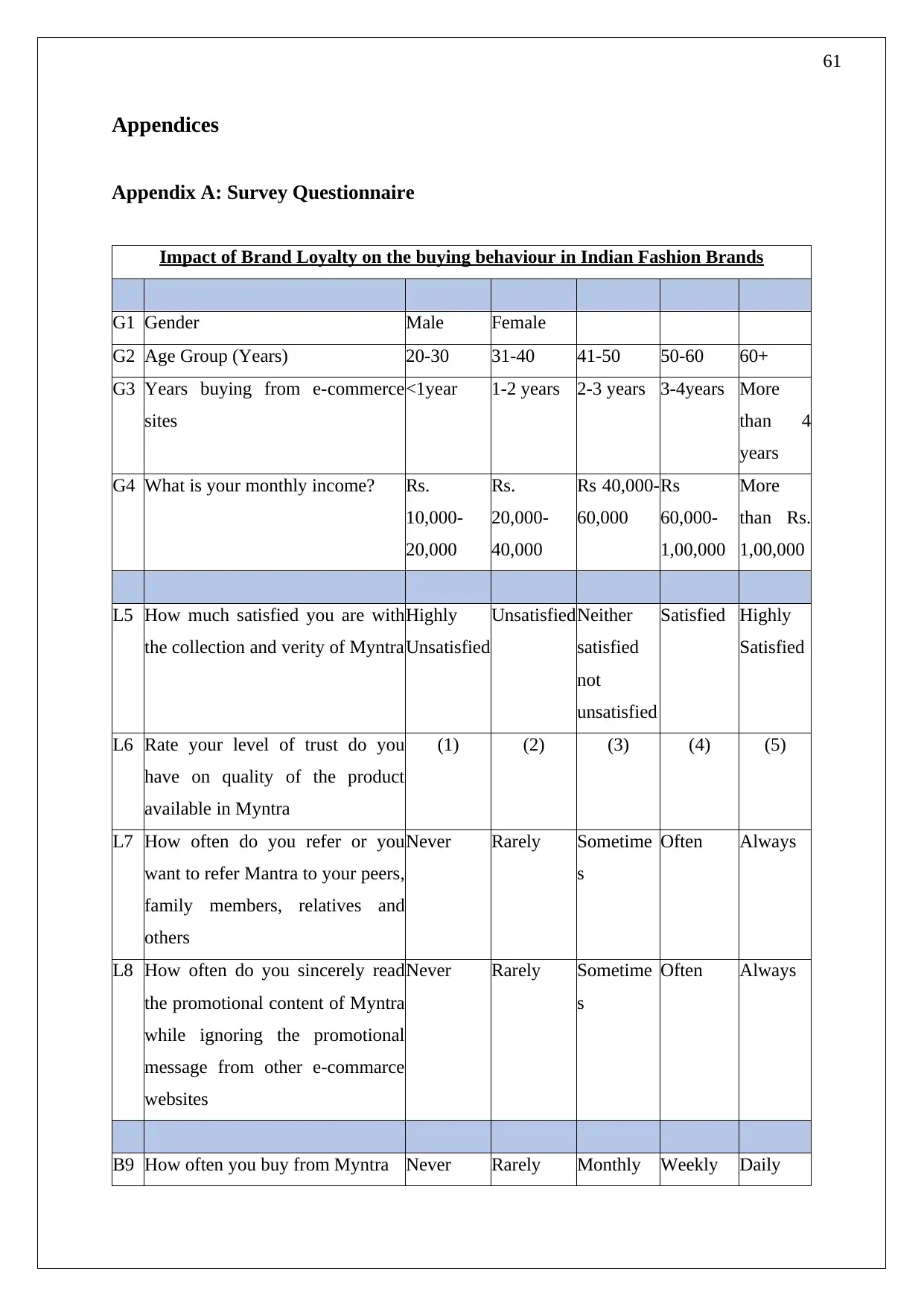
61
Appendices
Appendix A: Survey Questionnaire
Impact of Brand Loyalty on the buying behaviour in Indian Fashion Brands
G1 Gender Male Female
G2 Age Group (Years) 20-30 31-40 41-50 50-60 60+
G3 Years buying from e-commerce
sites
<1year 1-2 years 2-3 years 3-4years More
than 4
years
G4 What is your monthly income? Rs.
10,000-
20,000
Rs.
20,000-
40,000
Rs 40,000-
60,000
Rs
60,000-
1,00,000
More
than Rs.
1,00,000
L5 How much satisfied you are with
the collection and verity of Myntra
Highly
Unsatisfied
UnsatisfiedNeither
satisfied
not
unsatisfied
Satisfied Highly
Satisfied
L6 Rate your level of trust do you
have on quality of the product
available in Myntra
(1) (2) (3) (4) (5)
L7 How often do you refer or you
want to refer Mantra to your peers,
family members, relatives and
others
Never Rarely Sometime
s
Often Always
L8 How often do you sincerely read
the promotional content of Myntra
while ignoring the promotional
message from other e-commarce
websites
Never Rarely Sometime
s
Often Always
B9 How often you buy from Myntra Never Rarely Monthly Weekly Daily
Appendices
Appendix A: Survey Questionnaire
Impact of Brand Loyalty on the buying behaviour in Indian Fashion Brands
G1 Gender Male Female
G2 Age Group (Years) 20-30 31-40 41-50 50-60 60+
G3 Years buying from e-commerce
sites
<1year 1-2 years 2-3 years 3-4years More
than 4
years
G4 What is your monthly income? Rs.
10,000-
20,000
Rs.
20,000-
40,000
Rs 40,000-
60,000
Rs
60,000-
1,00,000
More
than Rs.
1,00,000
L5 How much satisfied you are with
the collection and verity of Myntra
Highly
Unsatisfied
UnsatisfiedNeither
satisfied
not
unsatisfied
Satisfied Highly
Satisfied
L6 Rate your level of trust do you
have on quality of the product
available in Myntra
(1) (2) (3) (4) (5)
L7 How often do you refer or you
want to refer Mantra to your peers,
family members, relatives and
others
Never Rarely Sometime
s
Often Always
L8 How often do you sincerely read
the promotional content of Myntra
while ignoring the promotional
message from other e-commarce
websites
Never Rarely Sometime
s
Often Always
B9 How often you buy from Myntra Never Rarely Monthly Weekly Daily
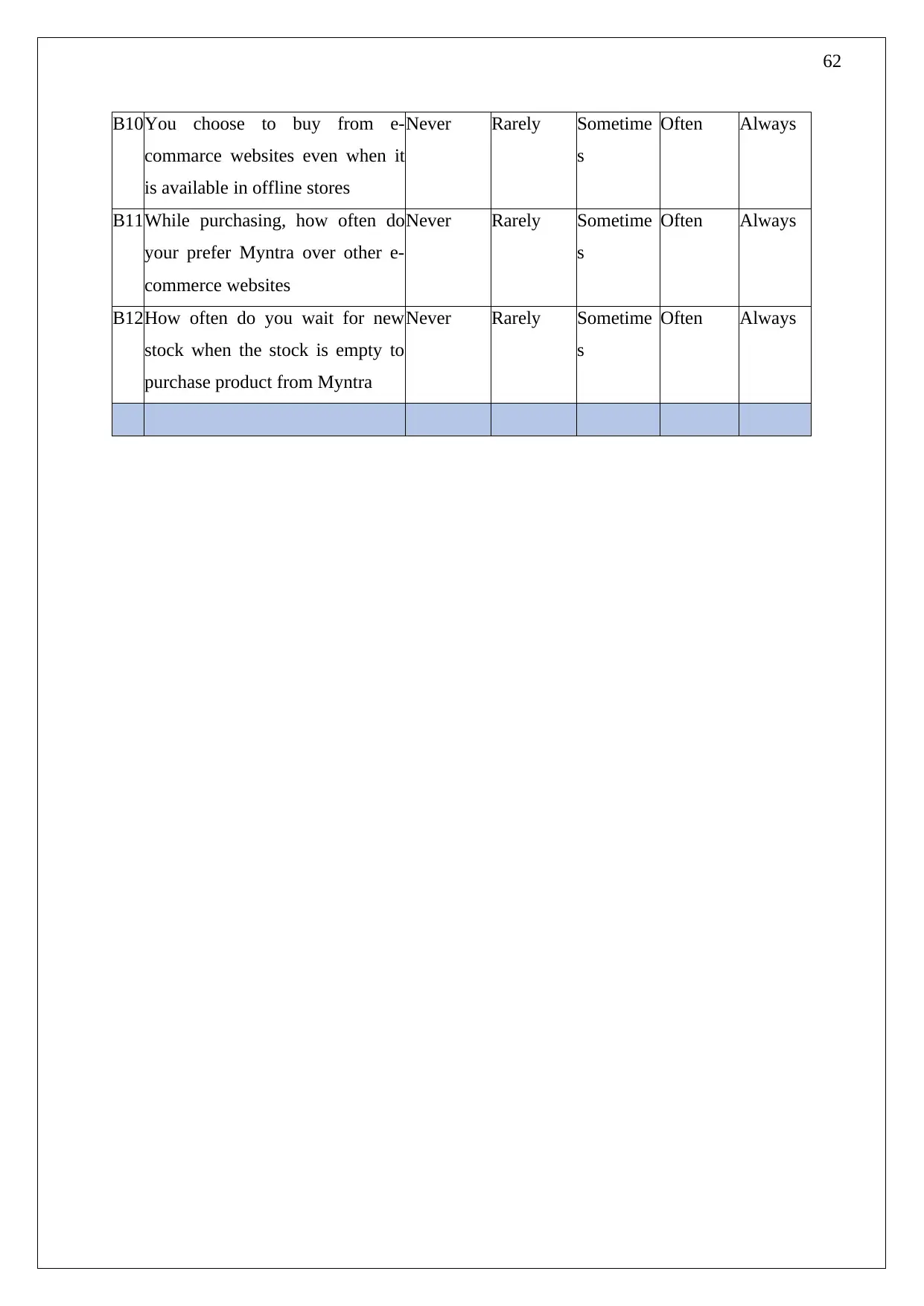
62
B10You choose to buy from e-
commarce websites even when it
is available in offline stores
Never Rarely Sometime
s
Often Always
B11While purchasing, how often do
your prefer Myntra over other e-
commerce websites
Never Rarely Sometime
s
Often Always
B12How often do you wait for new
stock when the stock is empty to
purchase product from Myntra
Never Rarely Sometime
s
Often Always
B10You choose to buy from e-
commarce websites even when it
is available in offline stores
Never Rarely Sometime
s
Often Always
B11While purchasing, how often do
your prefer Myntra over other e-
commerce websites
Never Rarely Sometime
s
Often Always
B12How often do you wait for new
stock when the stock is empty to
purchase product from Myntra
Never Rarely Sometime
s
Often Always
1 out of 63
Related Documents
Your All-in-One AI-Powered Toolkit for Academic Success.
+13062052269
info@desklib.com
Available 24*7 on WhatsApp / Email
![[object Object]](/_next/static/media/star-bottom.7253800d.svg)
Unlock your academic potential
© 2024 | Zucol Services PVT LTD | All rights reserved.





